1 Introduction
Cultural diversity is evident within and between countries, and it is widely recognized for its strong correlation with economic and political development (see, e.g., Nunn 2021). According to cultural geographer Wilbur Zelinsky, “the dominant culture of a given nation is determined by the characteristics of the first group of settlers who came to an empty territory regardless of how small the initial band of settlers might have been” (Zelinsky 1973).
To understand the influence of immigrants on the cultural and institutional evolution of settler societies, in this paper I revisit Zelinsky’s doctrine. I place specific emphasis on settlers’ culture as a pivotal element of their characteristics and assess its impact in explaining variations in gender norms within the United States, particularly within individual states. My approach hinges on exploiting the disparities in early settlers’ attributes across US counties, generated by immigration from places with distinct gender norms. This analysis seeks to determine whether early settlers carry and instill their values and beliefs in the newly established areas of the United States. I document higher female labor force participation (FLFP), both historically and currently, in US counties that historically hosted a larger share of settlers from origins with liberal gender attitudes. I also find that current residents of these US counties have liberal attitudes toward women’s roles in societies.
This paper centers on gender norms, encompassing beliefs and values concerning women’s roles in society, which exhibit significant disparities both among and within states. Survey-based measures, such as the General Social Survey (GSS), unveil substantial variations in gender roles and attitudes among respondents in the United States. Furthermore, by concentrating on gender norms, I can offer indicative evidence supporting potential mechanisms pertaining to the development and transformation of gender values and beliefs in US counties. These mechanisms are linked to gender attitudes in the settlers’ places of origin (see Sections 2.2 and 3 for details).
I examine the US context and identify the settler population by analyzing data concerning individuals who resided in US counties around the time of their establishment. These settlers encompass individuals born in the same state, those from other states, and those born outside of the United States. My focus centers on US counties that were created during the “age of mass migration,” a period characterized by a substantial influx of diverse migrants to the United States between 1850 and 1940. This choice is informative for several reasons. First, it enables me to study counties during their early stages of cultural and institutional development. Second, the era of mass migration offers an adequate setting for examining variations in the composition of settlers, both across and within states, due to the extensive and varied migration flows into the United States during that time.
To understand the outsize influence of settlers during the initial stages of institutional development, I distinguish between two categories of newly formed US counties: “new” and “partitioned” counties. My primary sample of newly established counties—referred to as new counties—consists of those that were not created through partitioning or division from previously established counties but instead originated from areas that were not part of any county. In an alternative analysis, I consider counties that were partitioned from preexisting settled regions, referred to as partitioned counties.
The rationale behind this distinction is rooted in the notion that new counties might significantly differ from partitioned counties in terms of their level of establishment and development, encompassing factors related to county, community, society, culture, and institutions. Consequently, new counties are more representative of the “empty” territories alluded to in Zelinsky (1973)’s doctrine. A key distinguishing characteristic between new and partitioned counties is that the latter were densely populated. This presents an empirical framework to examine the cultural legacy of first effective settlement and directly assess Zelinsky (1973)’s doctrine, which contends that “the actions of this initial group of people have a much more significant impact on the cultural landscape of a region than the contributions of tens of thousands of new immigrants several generations later.” This approach aligns with theories of persistence through intergenerational cultural transmission, path dependence, and the pivotal role of initial conditions during critical junctures of institutional development in shaping social norms and attitudes, both in the short and long term (Alesina and Giuliano 2015; Bisin and Verdier 2017; Belloc and Bowles 2013; Bazzi et al. 2020; Couttenier et al. 2017; Tabellini 2008).
To examine the makeup of settlers, I analyze data on their demographic attributes, place of birth, and gender-related characteristics in their places of origin. To capture settlers’ culture, I employ quantitative measures that reflect values and beliefs originating from their places of birth. The fundamental premise here is that settlers internalize their cultural norms before relocating to new areas, establishing a connection between settlers’ culture and the prevailing culture in their home country or state. I present supportive evidence for this assumption in Section 6.
I begin by presenting a descriptive analysis of the characteristics of early settlers who resided in US counties around the time of their creation. My findings reveal that most of these settlers were literate men in their prime working years. Most were born outside of the state where they settled, followed by those born within the state and those born abroad. In terms of settlers’ cultural background, foreign-born settlers predominantly hailed from high-FLFP countries, defined as those with above-median FLFP rates. Meanwhile, out-of-state born settlers predominantly came from states where women had property and earning rights.
My analysis of the role of settlers’ culture in explaining variations in FLFP within states yields compelling evidence supporting the concept of cultural continuity and the persistence of norms over time, particularly within the primary sample of new counties. I establish a positive and statistically significant link between FLFP in newly established US counties, both in the short and the long term, and the cultural values of the initial settlers. These values are represented by factors such as historical FLFP (measured using various metrics) and women’s financial liberation in the settlers’ places of origin.
I conduct a comprehensive sensitivity analysis and demonstrate the robustness of the results to various modifications, including changes in the measurement of settlers’ culture, the consideration of demographic characteristics within counties, the inclusion of additional county-level factors pertaining to isolation and economic development, the use of alternative inference methods, and the incorporation of controls for counties’ frontier experiences.
However, when I focus on the alternative sample of partitioned counties, this relationship is not observed. I attribute this difference to the fact that partitioned counties are not in their earliest stages of development and do not experience the same critical junctures in the formation of their local culture.
Comparing the results obtained for newly created counties emerging from noncounty areas (new counties) with those from subdivisions of existing counties (partitioned counties) aligns with conducting a differences-in-differences analysis. The findings corroborate the predictions made by Zelinsky (1973) that the influence of settlement is considerably stronger when cultural institutions have yet to take shape. This phenomenon explains the significant impact of early settlers in new counties during crucial phases of cultural and institutional development, where the initial settlers shape local institutions and culture. These influences became entrenched norms, as opposed to the more advanced and established communities in partitioned counties. This innovative research framework thus serves as a practical means to empirically examine and document one of the potential mechanisms through which persistence may have occurred.
The main challenge in achieving causal identification stems from omitted variables that exhibit correlations with both the county-level proportions of settlers from regions with liberal gender attitudes and FLFP in newly established US counties. To address the potential issues of selection and sorting of settlers into newly created US counties based on specific local conditions, as well as the self-selection of settlers with particular characteristics, including gender-related values, I incorporate a set of covariates that are likely to impact both the composition of settlers and gender norms within US counties. These covariates account for local factors such as economic opportunities. Additionally, I implement an instrumental variables (IV) strategy designed to isolate potentially exogenous variations in settlers’ culture.
I tackle further potential threats to the study’s identification as well as various other issues and concerns that encompass potential limitations in quantifying settlers’ populations, the link between the timing of county formation and settler populations, migration endogeneity, and the validity of the cultural correspondence assumption. Moreover, I examine the factors influencing the enduring influence of initial cultural elements by exploring the nonlinear impacts of settlers’ culture on FLFP in recently formed US counties. I uncover structural shifts in FLFP levels within US counties with historical ties to settlers, both in the short and long run, revealing the presence of threshold effects in the transmission of cultural values.
I next investigate whether the culture of later settlers plays a significant role in cultural development within host areas. My findings indicate that the influence of initial settlers is considerably more significant for cultural formation compared to the contribution of new immigrants arriving several generations later.
I then examine whether individuals currently residing in US counties that historically hosted a higher proportion of settlers with progressive gender attitudes exhibit pro-women’s empowerment and achievement attitudes beyond domestic responsibilities. To do this, I analyze data from the General Social Survey (GSS) and the LifeStyle Survey (LSS) and find that residents in counties with greater shares of early settlers from places characterized by high FLFP and women’s financial rights are more likely to support women’s participation in work and national affairs, not limited to household duties. These findings indicate the persistence of progressive gender attitudes in these counties.
This paper contributes to four strands of the literature. First, I contribute to the literature on the roots and persistence of cultural traits, specifically gender norms (Alesina et al. 2013; Algan and Cahuc 2006; Baranov et al. 2023; Becker and Woessmann 2008; Campa and Serafinelli 2019; Cortés et al. 2022; Gay 2023; Grosjean and Khattar 2019; Hansen et al. 2015; Nunn 2014; Teso 2019). Natural experiments in history affecting sex ratios, historical agricultural practices, and historical institutions including religion and family structures are documented as crucial determinants affecting the formation of gender norms. I contribute to this literature by examining a novel factor that may explain variations in gender norms across societies, focusing on the effects of early settlers’ characteristics. I show that their cultural traits at early stages of institutional and cultural formation have lasting impacts on the prevailing culture. These settlers thus leave the largest imprint on a locale’s gender norms by shaping its future formal and informal institutions, to which later migrants assimilate. The relatively underdeveloped cultural and institutional environment in these newly established counties allowed settlers to substantially impact the formation of local culture, institutions, and social identity.
Examining newly formed counties at various stages of cultural and institutional development presents a novel approach to directly assess the influence of early settlers and offers a potential mechanism for understanding persistence in terms of their impact on shaping local institutions and fostering entrenched local gender-liberal attitudes. Baranov et al. (2023) show that variation in the sex ratio of early settlers in Australia had persistent effects on gender norms. Baranov et al. (2020) examine whether the convict makeup of initial settlers in Australia had long-term effects on culture and show a persistent influence of convict colonization on marriage-related social norms. Brodeur et al. (2020) document that while common-law-based legal institutions improve women’s socioeconomic outcomes, these gains are absent or dampened in societies where ancestral cultural norms limit their rights. Other particularly relevant studies are Bazzi et al. (2020) and Grosjean (2014). Bazzi et al. (2020) revisit Turner’s thesis (Turner 1893), which argues that the American frontier fostered individualism in the United States, and document a more pervasive individualism and a greater opposition to redistribution in US counties with a greater frontier experience. Following an influential work in social psychology (Cohen et al. 1996), Grosjean (2014) addresses the cultural effects (the culture of honor) of the type of settler population (herders) in the South.
Second, this paper contributes to the literature on immigrants and their assimilation and gender norms (Alesina and Giuliano 2010; Antecol 2000; Blau 1992; Blau et al. 2011; Blau 2015; Blau et al. 2020; Fernandez et al. 2004; Fernandez and Fogli 2009; Fortin 2005). A strand of literature examining culture and gender norms relies on an epidemiological approach, which aims at separating the impacts of culture from those of institutions and economic environments. This approach relies on the descendants of immigrants, arguing that the latter transmit the values and beliefs of their country of origin in an institutional environment that is the same across all different immigrant groups (Fernandez 2011). This paper considers the first iteration of immigrants, who themselves played an important role in shaping the institutional environment that previous studies, relying on epidemiological approaches, treat as constant when examining subsequent immigrants.
Third, this paper contributes to the existing literature that documents (theoretically and empirically) the importance of initial conditions in determining the long-run equilibrium and modes of transmission (Akerlof and Kranton 2000; Bisin and Verdier 2011; Gay 2023; Shayo 2009), and to the emerging quantitative research that shows immigrants and culture matters for economic outcomes (Ager and Brückner 2013; Algan and Cahuc 2006; Barro and McCleary 2003; Fernandez and Fogli 2009; Guiso et al. 2009; Giuliano 2007; Sequeira et al. 2020; Tabellini 2010).1See Nunn and Puga (2012) for a comprehensive review of these studies. Fulford et al. (2020) examine the short- and long-term impact of immigrants and their descendants on local development in US counties. Exploring variations in country-of-ancestry composition, Fulford et al. (2020) show that immigrants from countries with higher economic development, cultural traits that favor cooperation, and a long history of a centralized state have a greater positive impact on county GDP per worker. Although much of the literature has focused on natural resource endowments, the cultural background of early settlers can be, and has been, interpreted as an endowment. My results provide evidence supporting both the horizontal and vertical transmission of gender norms. Miho et al. (2023) document evidence of between-group horizontal cultural transmission of gender norms using Stalin’s ethnic deportations as a historical experiment.
This paper also contributes to the growing literature on how patterns of migration shape cultural differences. In particular, it offers a framework for documenting that when immigration coincides with the critical juncture phase of institutional development in destination locations, it can help to propagate and entrench norms carried by immigrants in newly established locations (Brodeur et al. 2020; Brodeur and Haddad 2021; Couttenier et al. 2017; Grosjean 2014). I thus contribute to the literature on the origins of cultural differences and the effects of migration in shaping the evolution of cultures across societies. Finally, this paper sets the stage for future research to examine a host of other cultural traits in settler populations as well as other settler societies.
Several papers, including Bazzi et al. (2020), Grosjean (2014), Grosjean and Khattar (2019), and Baranov et al. (2023), show that initial cultural conditions matter. In addition, many papers since Fernandez and Fogli (2009) (including Blau et al. 2011 and Blau 2015) show that the culture of migrants persists, including in the case of FLFP. There are also other existing studies that have documented that the inflow of individuals with different cultural or political preferences shapes the values of receiving counties in the United States (e.g., Bazzi et al. 2021; Giuliano and Nunn 2021). This plausibly provides an answer to the question of whether we should expect a new culture to emerge in host societies. However, this research provides a novel framework to empirically examine the cultural legacy of first effective settlement and investigate cultural formation in settler societies.
The study supports previous findings of the literature on cultural persistence, namely several studies of the United States and other settlers’ countries, which document a lasting imprint of the characteristics and circumstances of early settlements on subsequent socioeconomic development. While there is an extensive literature on the roots of cultural traits, the novelty of this study in comparison to a battery of recent works (e.g., Bazzi et al. 2020; Fernandez 2011; Fiszbein et al. 2022; Guiso et al. 2016; Knudsen 2019; Nunn and Wantchekon 2011; Schulz et al. 2019; Spolaore and Wacziarg 2013; Voigtl¨ander and Voth 2012) is the significance of “first” settlement. Contrary to other persistence studies examining historical determinants at some historical point, this paper emphasizes the greater importance of initial settlement than later settlement. Its most notable contribution is to provide an “experiment” and a framework showing that early settlers can have an outsized influence on local norms when settlement coincides with early stages of cultural and institutional development. Unlike previous papers that uniquely consider immigrants from abroad (particularly European immigrants) to the United States, uniquely focus on movers within the United States (e.g., Southern migration), or solely consider frontier settlers, this paper examines the impact of both foreign (including European immigrants) and out-of-state born settlers on culture in all newly established US counties, which is also more comprehensive than solely considering frontier settlers.
The rest of the paper is structured as follows. In Section 2, I provide a brief historical background on the process of county creation in the United States and a conceptual framework. In Section 3, I describe the novel methodology that allows me to investigate the cultural legacy of first settlement and the data sources used in this framework. I also provide some detailed descriptive statistics. Section 4 outlines the empirical strategy, and Section 5 discusses the results and presents several robustness checks. Section 6 addresses additional concerns, and Section 7 concludes.
2 Historical and Conceptual Background
In this section, I first provide a brief overview of the process of territorial expansion in the United States as well as state incorporation and county creation. County creation events provide an adequate setting to focus on counties at early stages of community, societal, cultural, and institutional development. In Appendix Section 7.1, I discuss alternative ways to define and measure newly settled areas based on population and population density thresholds. In the rest of this section, I provide a conceptual framework offering insights on the implications of Zelinsky (1973)’s doctrine of first effective settlement.
2.1 Territorial Expansion, State Incorporation, and County Creation
On July 4, 1776, the United States was created out of the Thirteen Colonies,2The Thirteen Colonies became New Hampshire, Massachusetts, Rhode Island, Connecticut, New York, New Jersey, Pennsylvania, Maryland, Delaware, Virginia, North Carolina, South Carolina, and Georgia. which declared their independence from the Kingdom of Great Britain and proclaimed themselves as free and independent states. It was not until 1873 with the Treaty of Paris, which put an end to the American Revolutionary War, that their independence was recognized by Great Britain.
The United States evolved from the Thirteen Colonies to its current form as a result of the following five largest territorial expansion events.3Appendix Figure A1 displays these expansion events. The first was the Louisiana Purchase (1803), which was a massive land purchase constituting almost 25 percent of the present-day United States, covering land from New Orleans up to Montana and North Dakota. The Adams-Onis Treaty, or the Florida Purchase Treaty, (1819) put an end to lengthy negotiations between the United States and Spain, officially transferring Florida to the United States. The third largest territorial expansion was the Texas Annexation (1845), which involved annexing the Republic of Texas—a region that had declared its independence from Mexico—and its subsequent admission to the Union as a US state. In 1848, the Mexican Cession encompassed the region that Mexico ceded to the United States as a result of the Treaty of Guadalupe Hidalgo after the Mexican-American war. Finally, the Alaska Purchase in 1867 resulted in the acquisition of Alaska from the Russian Empire by the United States.
The Congress of the Confederation, known as the United States in Congress Assembled, had governing authority over the United States. Its authority was granted by the Articles of Confederation and Perpetual Union, which was the first constitution of the United States (an agreement among the 13 original states). The Congress of the Confederation enacted two key ordinances: the Land Ordinance of 1784 and the Northwest Ordinance of 1787. These two ordinances organized the creation of territorial governance and dictated the protocols for state admission to the Union, the division of land into administrative units, and public use of land. The Land Ordinance was a standardized system for settling and selling land, allowing frontier migrants moving westward to acquire land through direct sales from the federal government via the Public Lands Survey System of grids of square townships for the distribution and sale of land in definable parcels as a commodity. The Northwest Ordinance created the Northwest territory, the first organized incorporated territory of the United States beyond the 13 original colonies.
The westward territorial expansion of the United States happened gradually and was largely driven by population pressures and external geopolitical forces (Davis et al. 1972). However, it did not occur peacefully. With the arrival of more explorers, and as new settlers moved in, Native American tribes, previously occupying the West, were displaced and lands were violently taken away from them. Treaties forced millions of Native Americans onto reservations, which were then frequently broken, leading to even larger shares of lands being acquired by settlers.
US territories were administrative divisions overseen by the US government, but they were not sovereign entities like US states. They included both organized incorporated territories, governed through an organic act and constituting integral parts of the United States (where full constitutional rights were applicable), and unincorporated territories, which were not considered integral parts of the United States (with only partial application of the Constitution). The process of incorporation was under the authority of the US Congress. The Admission to the Union Clause of the US Constitution (preceded by the two ordinances) dictated how these territories would be admitted to the Union as US states. A total of 31 out of 37 states admitted to the Union by Congress were established within US-organized, incorporated territories. Sometimes an entire US territory became a state and sometimes just part of it.
The Northwest Ordinance authorized the creation of counties by the governor’s proclamation until the organization of the territorial general assembly, and thereafter by the general assembly itself. US counties constituted administrative or political subdivisions of a state. In an organized incorporated territory (not yet granted statehood), the territorial legislative assembly had the authority to create counties. For example, Arizona territory established by the Arizona Organic Act enacted the creation of Arizona’s first four counties (Mohave, Pima, Yavapai, and Yuma). Thus, US counties were, in some cases, formed before statehood.4 Appendix Figure A2 displays the territorial act in 1818 that was enacted by the territorial legislature of Alabama, which established Marengo County. In US states (organized incorporated territory admitted to the Union or US states not established within US-organized incorporated territories), county creation was under the authority of the state-specific General Assembly of Senate and House of Representatives, and conditions for county creation were dictated by state constitutions.5 For instance, Texas’s state constitution dictated that “no existing county could be reduced to less than 900 square miles without the consent of a two-thirds majority of the Legislature. In addition, the Legislature could continue to create counties without consent of the residents living on the land area being considered.” Other conditions imposed that new counties that were to be formed in Texas state from unorganized lands must be at least 900 square miles. Appendix Figure A3 displays an act passed by Alabama state to establish a new county as a subdivision of previously formed counties.
2.2 Conceptual Background
Wilbur Zelinsky is an American cultural geographer with many geographical studies on American popular culture. He famously argued in one of his books (Zelinsky 1973) that the first settlers significantly impact the dominant culture of a given nation. His doctrine of first effective settlement (also known as the Zelinsky 1973 doctrine) is a theory in cultural geography that served as a basis for future theories linking American history to present-day events. Zelinsky’s view—on how and why the behavior of the initial group of colonizers (settlers) matters more than that of subsequent immigrants in shaping the cultural geography of a given place—is based on the idea that the cultural institutions established by the first settlers will remain ingrained in the social fabric of a given territory. Moreover, the newly established institutions are self-perpetuating in the sense that they reproduce their cultures across time. Later immigrants will not defy prevailing institutions but rather will assimilate and socialize into the territory’s cultures and views. While changes will continue to occur in settled regions, these will be anchored in the cultural institutions established by the initial settlers. A related theory is the “fragment theory” of class, culture, and ideology by Louis Hartz in his influential book The Founding of New Societies (Hartz 1969), which argues that the diverse political and cultural traditions in new societies (in the United States, Latin America, South Africa, Canada, and Australia) represent a cultural fragment of the European countries from which they originated. He posited that each new society retains the ideology that was dominant in its parent country at the time of its founding.6Another related point is by Frederick Jackson Turner, who argued that the American frontier fostered individualism (Turner 1893). The earliest stages of development on the frontier were likely a critical juncture in the formation of local culture, as alluded by Turner (1893)’s thesis, where he notes that the “traits [of frontier society] have, while softening down, still persisted as survivals in the place of their origin, even when a higher social organization succeeded.”
Woodard (2011) expanded the doctrine of first effective settlement, particularly the homogeneity within settled nations, and argued that the movement of people to new territories, bringing with them the culture of the society they came from, resulted in the creation of multiple nations, which together constitute the country. These multiple American nations are thus culturally segmented parts, each composed of a group of people who share a common culture and origin defined beyond legal states and international boundaries. Woodard’s argument, inspired by the first effective settlement doctrine, relates directly to cultural formation in settler societies.
The implications of the various doctrines and theories from adjacent disciplines discussed above suggest that the culture of settlers of newly created US counties has a lasting impact on the culture formed in these areas. As counties are newly formed, and given that settlement is at its early stages,
settlers who first inhabit these territories may influence the formation of local economic, social, political, and cultural institutions—both formal and informal—institutions in a way that shapes the social fabric of that given county.
The purpose of this paper is thus to empirically examine the implications of these theories, particularly Zelinsky (1973)’s doctrine. It tests whether migrants who moved to US counties during their early formation carried the values and beliefs from their societies of origin to their new locales, and how these influenced the formation of institutions and culture in these newly settled areas. This relates to cultural persistence via both the spatial (horizontal/cultural continuity via portability) and the vertical (across generations or over time) transmission of cultural beliefs.
One possible outcome is that these settlers carried their cultural beliefs from their home country/state, moved to US counties, and shaped a culture that mirrors their home country/state culture, which persists to the present day. This would validate both the horizontal and vertical aspects of transmission of norms and values in newly formed US counties. Another possible outcome is that they moved to US counties and shaped a culture mirroring that of their home country or state, but this cultural influence did not persist over time or across generations. This would thus validate the horizontal transmission of norms and values only. Last, settlers may have arrived to US counties and shaped a culture that does not mirror that of their home country or state, meaning that both horizontal and vertical transmissions of cultural beliefs are absent in newly formed counties.
3 Data
In this section, I describe the novel methodology used to investigate the cultural legacy of first settlement, particularly how to capture counties in their early stages of cultural and institutional development, construct settlers’ population, and examine their composition in terms of demographic and cultural characteristics. I also describe the data sources used in this framework and provide some detailed descriptive statistics.
3.1 US Counties
I focus on county creation events to capture counties at their early stages of cultural and institutional development. I disregard counties created before 1840 and after 1940, limiting my analysis to counties formed between 1840 and 1940, for several reasons. First, the time period falls within the era of mass migration, which provides an adequate setting for both across- and within-state variation in settler composition as a result of the diverse and heavy migrant inflows to the United States during that period. Second, given that full-count US censuses are available only between 1850 and 1940, and counties are not identified in public-use microdata from 1950 onward, I cannot examine the composition of settlers residing in newly formed US counties any time before or after that period. Additionally, data on FLFP, the main outcome of interest in this paper, are only available as of 1850, which explains disregarding US counties created before 1840.7Out of 3,172 US counties, almost 42 percent were created before 1840, and only 2 percent were created after 1940. The remaining counties were created sometime between 1840 and 1940. As mentioned earlier, counties created between 1880 and 1889 are excluded from the analysis given that census data are missing for 1890 from all sources. Additionally, few counties that do not classify as new nor partitioned are also excluded. Expanding the sample selection to include the 65 counties created post-1940 does not alter the main sample of new counties given that none of them were created from noncounty areas. Appendix Section 7.1 and Appendix Figure A4 provide a detailed discussion on the importance of using county creation events to capture the first effective settlement rather than using population and population density thresholds.
To construct my sample of US counties created between 1840 and 1940, I rely on the Atlas of Historical County Boundaries data set.8Data are available from https://publications.newberry.org/ahcbp. This data set provides information about the creation of every US county as well as their changes in administrative status, size (land area in square miles), shape, and location. I end up with a total of 1,381 US counties created between 1840 and 1940 (see Figure I). About 77 percent of these counties were created before 1900, and about 58 percent are in the West and Midwest census regions, 41 percent in the South census region, and the remaining counties in the Northeast census region. Due to missing census data for 1890 from all sources, I exclude 167 counties created between 1880 and 1889 from the sample.
The 1,381 US counties created between 1840 and 1940 include counties that were not subdivided or partitioned but were created from noncounty areas, which I refer to as new counties. Figure II displays these new US counties in red. About 55 percent are in the Midwest census region, about 22 percent in the South census region, and the remaining 23 percent in the West census region. Close to 82 percent of these counties were formed before 1900, and the remaining 18 percent were formed sometime after 1900.
Additionally, new counties were created either by subdividing a previously formed county, by combining areas from multiple established counties, or through a combination of noncounty areas and portions of already formed counties. I refer to these as partitioned counties (see the yellow areas in Figure II). The gray areas in Figure II indicate counties that are excluded from the analysis because they were either created before 1840, between 1880 and 1889, or after 1940.
My main analysis is limited to the sample of new counties, i.e., those that were not subdivided or partitioned but were created (entirely) from noncounty areas. The main sample sums up to a total of 324 counties, excluding partitioned counties. This is crucial given that counties created through subdivision may differ from new counties in terms of how established the county, community, society, and institutions are. While the average number of inhabitants was 6,114 for new counties and 6,867 for partitioned counties, population density per square mile was more than four times larger in the latter group of counties (population density of 41.8) compared to new counties (population density of 10.9). Population and population density data are obtained from the first US Census available after the county’s creation date.
To fix ideas, consider Bullock County (Appendix Figure A3), founded in 1866 in Alabama state. Since the county was created as a combination of four previously established counties (Macon, Montgomery, Pike, and Barbour), it is a partitioned county and is thus excluded from my main sample of new counties. In Appendix Section 7.2.1, I provide a detailed discussion on the classification of newly created US counties across new and partitioned categories.
3.2 Settler Population
In this subsection, I describe how I construct the settlers’ population as well as the data sources and variables used to examine this population’s composition. I also provide a descriptive analysis offering new insights on the characteristics of settlers living in newly created US counties. I present summary statistics for my entire sample of settlers, by gender and by gender and category (foreign, out-of-state, and in-state born settlers) simultaneously.
3.2.1 Settler Population and Demographic Characteristics
I define the population of early settlers as individuals residing in US counties at the time of their territorial government’s creation. Having information about each county’s year of creation, I construct the settler population using information about county identifiers from full-count census data. Specifically, I build a data set of people living in these US counties by relying on the first full-count US Census available after the county creation date. In Section 6, I examine the validity of settlers’ definition given that census data are not available for areas before they become politically organized as an administrative entity of the United States.
I rely on complete-count US Census data (1850–1940) from the Integrated Public Use Microdata Series, or IPUMS (Ruggles et al. 2020).9The data are available from https://usa.ipums.org/usa/. The population counts exclude most Native Americans, who were generally not enumerated by the census before 1900. IPUMS provides access to US Census microdata and includes a wide range of information about individuals’ education/literacy, labor force and fertility status, income and occupational score, among other information. I carry out my analysis at the county level, so I generate county averages based on individual characteristics. County identifiers allow me to identify the county where the household was enumerated and, more importantly, where individuals are residing. I generate settlers’ county-level average age and gender composition as well as their marital, fertility, and literacy status.
Additionally, given that settlers coming from different places are exposed to a different set of values and beliefs, it is crucial to identify their country/state of origin. To do so, I rely on a variable available from IPUMS, which indicates the US state or foreign country where the individual was born. Using information about the birthplace allows me to divide the settler population into three different categories. The first category comprises foreign-born individuals, i.e., those born outside the United States. The second category includes those born out of state, i.e., born in a different US state from where their household resided at the time the census enumerator conducted the interview. Finally, in-state born individuals are those born in the same state where their household is located.
Table I provides summary statistics of the characteristics of settlers living in my sample of new US counties. Column (1), Panel (A) presents statistics for the entire sample of settlers, and columns (2) and (3) report statistics by gender. The results from column (1) show that settlers who occupied newly formed counties were mostly literate men in their prime age. The statistics reported in Panel (B) reveal that settlers were mainly out-of-state born migrants (64 percent), followed by in-state born individuals (21 percent). Foreign-born settlers constitute 15 percent of settler populations. Appendix Figure A5 illustrates the distribution of foreign-born, out-of-state, and in-state migrants out of the entire population, respectively, across my main sample of new counties. Appendix Figure A6 shows this distribution for the alternative sample of partitioned counties.
Panel (A), columns (2) and (3) of Table I show that these features apply to both male and female settlers, with a notably reduced proportion of singles among female settlers. These patterns are consistent with what historians, demographers, and economists have documented regarding the distinctive characteristics of frontier populations given the difficult and dangerous frontier conditions (Bazzi et al. 2020).
Appendix Table A1 repeats these descriptive statistics by gender for foreign, out-of-state, and in-state born settlers separately in columns (1)–(2), (3)–(4), and (5)–(6), respectively. The table confirms that regardless of gender, foreign and out-of-state born settlers were younger and more likely to be literate than in-state born individuals. Furthermore, the children-to-women ratios were significantly higher for female foreign and out-of-state-born settlers compared to those born in state.
3.2.2 Settlers’ Culture
To capture settlers’ culture, I use various proxies that reflect values and beliefs from settlers’ places of origin.10People moving to US counties from different locations may be exposed to different norms at their places of origin/birth, including gender-related ones. However, this paper does not focus on the distance traveled by these settlers. For instance, Von Berlepsch and Rodríguez-Pose (2019) exploit distance traveled and distinguish between internal migrants (what I refer to as out-of-state born individuals) and external migrants (foreign-born individuals) in their examination of the impact of migrants on counties’ long-run economic development. In contrast, I exploit migrants’ culture using gender norms at their places of origin/birth as the underlying variation rather than the distance traveled. The underlying assumption is the correspondence between settlers’ culture and the dominant culture in their sending country/state. I use a series of quantitative variables including FLFP (measured through various metrics) and women’s financial liberation rather than simply using the country or state of birth as a proxy variable for gender norms at the place of birth.11Due to data limitations, it may not be possible to explore the potential influence of different groups of Native Americans on settlers’ migration decisions or on gender norms. In some robustness specifications, I account for exposure to conflict with Native Americans. Specifically, I construct two quantitative variables. The first one captures FLFP by the country of origin per decade. The second one delves into the variation in the enactment of women’s financial rights across US sending states.12Financial empowerment is solely assessed for sending US states and not foreign countries. This is due to the heterogeneity in historical inheritance practices across various regions within a given country, as well as the scarcity of countries that granted women property and earning rights during the period of analysis.
I create a data set of historical FLFP for foreign-born settlers’ sending countries (countries of birth), merging data from at least three different sources.13Foreign-born individuals from countries lacking historical labor force participation data are excluded from the population of foreign-born settlers with known FLFP. These individuals are instead classified as part of a population of foreign-born settlers with unknown FLFP. Foreign-born settlers from countries with both known and unknown FLFP comprise the entire foreign-born settler population. This includes data from IPUMS International Historical Censuses.14Data are available from https://international.ipums.org/international-action/samples. I combine this with information on FLFP by country by decade, extracted from Olivetti (2014) and Olivetti and Petrongolo (2016). Determining the optimal decade for constructing historical FLFP in the sending countries is not straightforward. In this paper, I use labor force participation data from the source countries from either the same decade, or one to two decades earlier than, the period when I identify the population of foreign-born settlers, depending on data availability. Since data on the migration date of settlers are unavailable, I gauge the characteristics of source countries based on when I observe the settlers, which is either in the same decade or a decade or two earlier, depending on data availability, before the county creation date. The underlying assumption is that the cultural beliefs of these foreign-born settlers are best reflected by the activities of their counterparts in the country of origin (Fernandez and Fogli 2009).
Summary statistics related to settlers’ culture reveal that foreign-born migrants primarily originated from high-FLFP countries. Table I, Panel (C) reports that 53 percent of foreign-born individuals from countries with known FLFP come from those with FLFP rates above the decade-specific median.15Notably, using the mean instead of the median does not affect the analysis. I proxy for settlers’ culture using FLFP with various metrics, not solely relying on the decade-specific median cutoff to distinguish those from high- and low-FLFP countries. I first employ a weighted average of FLFP from sending countries, adjusting for the share of foreign-born settlers residing in a specific US county and originating from a given country. I then construct a time-in-variant measure of gender norms in the origin country, established using the earliest available FLFP data for each country as of 1840. I compute most of these measures for settlers born out of state but do not incorporate them into the main specification. A more detailed discussion on this is provided later in the paper. Appendix Figure A7 shows the distribution, across my main sample of new counties, of the share of foreign-born settlers from countries known to have above-median FLFP. Appendix Figure A8 displays this distribution for the alternative sample of partitioned counties.
The second quantitative measure proxies for out-of-state born settlers’ gender norms, using the variation in the timing of passage and implementation of women’s financial liberation relative to the county creation date. This measure explores the timing of granting of property and earning rights to women across US sending states. The data on the timing of women’s financial liberation by state are obtained from Geddes and Dean (2002) and displayed in Appendix Figure A9.16Investigating the timeline of women’s legal rights (other than voting) in the 19th century, particularly during the period observed in this paper, reveals that only three countries passed formal changes and reforms regarding women’s property rights (Ireland, the United kingdom, and Scotland). I thus refrain from measuring financial liberation for settlers originating from foreign countries.
Panel (C) of Table I shows that almost 36 percent of out-of-state born settlers came from US states where women had property and earning rights (see Appendix Figure A10 for the distribution of this share across my main sample of new counties and Appendix Figure A11 for the sample of partitioned counties).
Appendix Section 7.4, particularly Appendix Figure A.8, offers a snapshot of the distribution of newly created counties by decade of creation and the type of counties established. It also includes a list of the top five sending countries/states of settlers, FLFP, and financial rights categorized by country/state of origin.
Appendix Figures A12 and A13 present a detailed overview of the countries of origin with known FLFP data, the relevant data sources used in each decade, the (total) proportion of foreign-born settlers with known FLFP out of the entire foreign-born settlers’ population, and the proportion of foreign-born settlers from countries. This information helps in understanding the sample used to establish the cutoff for high (above-median) FLFP.
3.3 FLFP in US Counties
I obtain data on FLFP in US counties from complete-count US Census data (1860–1940) from IPUMS. I rely on the variable “labforce,” which is a dichotomous variable that indicates whether a person participated in the labor force.17Official census accounts of FLFP before 1890 may be subject to underreporting. See Chiswick and Robinson (2020) for a discussion on the measurement problems of the 19th-century census FLFP. Additionally, note that before 1940, the census asked about the occupation in which individuals were “gainfully employed” (Goldin 2006).
4 Empirical Strategy
4.1 Strategy Visualization
I begin by presenting a visual display to enhance the understanding of the methodology employed in this paper to investigate how the gender norms brought by early settlers can exert lasting effects on local culture. Appendix Figure A14 provides a detailed representation of the methodology used in this analysis. The primary event of interest is the county creation event. When a county is established between 1840 and 1940, I create the population of settlers using the first US Census conducted after the county’s creation date.
To assess settlers’ culture, I rely on variables such as FLFP and financial liberation in the settlers’ places of origin. To explore the role of settlers’ culture in explaining variations in gender norms within the United States, I calculate FLFP in US counties using data from the first US Census conducted after the county’s creation date for the short-run analysis. For the analysis focusing on persistence, I calculate FLFP approximately 100 years after the county’s creation date. Additionally, I measure gender values and attitudes using data from the GSS and the LSS.
4.2 Identification Strategy
In this subsection, I provide a formal description of my identification strategy and discuss potential threats to causal identification. The aim is to examine how settlers’ culture contributes to explaining variations in gender norms within the United States. The identification strategy entails a comparison of US counties created simultaneously within the same state, differing in the proportion of hosted settlers originating from regions with liberal gender attitudes. This comparison is made while considering the county-level total population and using proxies for local conditions. The analysis is conducted at the county level, focusing on my primary sample of new US counties created between 1840 and 1940. These are counties that were not subdivided or partitioned but were entirely established from noncounty areas.
In an alternative examination, I extend this analysis to the sample of partitioned counties. The rationale for considering this latter group of newly created counties is to directly test Zelinsky (1973)’s doctrine, which argues that early settlers exert an outsized influence through their imprint in shaping local culture and institutions. This approach also serves as an experiment to document one way in which persistence might have occurred, especially considering that counties formed as subdivisions of previously established counties could differ from new counties in terms of their level of societal, institutional, and cultural development.
Comparing the results obtained for new counties, which are newly created from noncounty areas, with the results derived for partitioned counties, which are subdivisions of already established counties, is analogous to performing a differences-in-differences analysis.18In Appendix Table A2, I investigate whether observable county-level characteristics predict the classification of a newly created county as a new county. To do this, I focus on the sample of newly created counties and directly compare new counties with partitioned one. I present the results from linear probability models that incorporate state and decade of county creation fixed effects, along with the following geographic variables: latitude, longitude, mean county temperature, rainfall, elevation, distance to lakes and rivers from the county centroid, and average potential agricultural yield. In the second specification, I include additional controls that account for terrain ruggedness, rainfall risk, distance to the nearest portage site, distance to the nearest Indian battle site, distance to the coast, number of years the county has been intersected by railroads since its creation date, and distance to the nearest mineral discovery site. In column (1), 2 out of 10 variables are statistically significant, while in column (2), only 1 variable is significantly related to whether the county is classified as a new county. These findings suggest that the sample of new and partitioned counties is well balanced across a wide range of covariates. In the empirical analysis, I include state and decade of county creation fixed effects as well as the aforementioned geographic variables.
Although US counties were established at various times and across different states, variations across states and in the timing of county creation are not relevant for this research. The sole relevant variation lies in the composition of settlers in newly created counties, i.e., the makeup of the initial inhabitants of these counties after their creation, specifically their culture. The primary challenge for causal identification arises from omitted variables that are correlated with both the countylevel proportions of settlers from places with liberal gender attitudes and FLFP in newly created US counties. To establish a causal link between settlers’ culture and FLFP in US counties, I must assume that the spatial distribution of the relative share of settlers from places with liberal gender attitudes was random. The process of selection and sorting settlers into newly created US counties based on specific local conditions and/or self-selection of settlers with particular characteristics, including gender-related values, poses challenges to identifying the causal effects of settlers’ culture.
I address this potential endogeneity bias by incorporating a set of covariates that are likely to influence both the composition of settlers and gender norms in US counties. These covariates account for local conditions, including economic opportunities. In addition to county-level geographic characteristics, the covariates include terrain ruggedness, rainfall risk, distance to the nearest portage site, distance to the nearest Indian battle site, distance to the coast, number of years the county has been intersected by railroads since its creation date, and distance to the nearest mineral discovery site. Furthermore, to consider employment opportunities, I include controls for contemporaneous male labor force participation (MLFP) in US counties.
Of course, it is impossible to control for all plausible factors that may correlate with culture and also influence the spatial distribution of settlers from places with liberal gender attitudes. Therefore, I employ an IV strategy that isolates potentially exogenous variations in settlers’ culture. In Section 5.5, I provide a detailed discussion of the strategy, which draws inspiration from the work of Sequeira et al. (2020) and Bazzi et al. (2020). This strategy aims to isolate push factors by predicting migrant outflows from Europe based on climate shocks.
There are, however, other potential threats to my identification, in addition to location-specific confounders and, consequently, issues related to settlers’ selection and sorting. First, one might argue that the timing of county creation could be influenced by the composition of settlers, where a more homogeneous population might expedite the county creation process. In other words, endogeneity in county formation could be a concern. Second, defining settlers as the first inhabitants of newly created counties using the first available census data might be problematic if people had been residing in these counties long before their creation and, consequently, long before the first US Census was conducted. I address these concerns in Section 6.
Last, the correspondence assumption between settlers’ culture and the dominant culture in the sending country/state of settlers might not hold if settlers hold beliefs, preferences, and values that do not align with the norms of their country/state of birth. In other words, the cultural correspondence assumption might be challenged if there is a selective migration from their places of origin. While the IV approach mitigates this concern by isolating migration push factors based on climate shocks, I further investigate the validity of the cultural correspondence assumption in Section 6.
4.3 Model Specification
I now present the model specification used in this paper. I estimate the following specification using ordinary least squares (OLS) estimation:
(1)
where captures a given county
, created in a given state
, in a given decade
.
is the county-level FLFP. For the short-run (long-run) analysis, data on FLFP are extracted from the 1st (10th) full-count US Census available after county creation date.
is the distribution of foreign, out-of-state, and in-state born individuals out of the total population.19The shares of foreign, out-of-state, and in-state born individuals (omitted category) add up to the entire population in a given US county. The estimated coefficients on the share of foreign and out-of-state born individuals are thus relative to the share of in-state born individuals.
is the independent variable of interest proxied with values and beliefs from settlers’ country/state of birth using two different measures.20While, conceptually, examining the effects of hosting more out-of-state and more foreign-born settlers from gender-liberal places should not differ, studying the effects separately allows for a more comprehensive understanding of the overall effects of the characteristics of these two groups of early settlers and enables a comparison of their relative effects. The first measure encompasses FLFP in sending countries, quantified using a range of metrics. The second measure explores the chronological implementation and passage of women’s financial rights across US sending states.
includes a list of covariates susceptible to affect both the composition of settlers and gender norms in US counties, directly and indirectly, through economic development and other channels. The list incorporates baseline county-level geoclimatic controls such as latitude, longitude, mean county temperature and rainfall, elevation, distance to lakes and rivers from the county centroid, and average potential agricultural yield.21This latter measure of agricultural suitability, as provided by the UN’s Food and Agriculture Organization, serves as a suitable proxy, for instance, for local economic development and the demand for female workers in agriculture. To these, I add a set of demographic controls characterizing settlers’ population, including the share of prime-age population (Bazzi et al. 2020), the share of literate population (Bazzi et al. 2020), the sex ratio computed as the ratio of the male over the female population (Baranov et al. 2023; Grosjean and Khattar 2019), the share of the single population (Bazzi et al. 2020), and the children-to-women ratio computed as the ratio of the number of children under 5 years of age over the number of women in their childbearing age times 1,000.
Finally, I also include additional controls that capture counties’ geography, isolation, conflict with Native Americans, and other factors that may be correlated with settlers’ location, culture, and gender norms in US counties. Specifically, I control for terrain ruggedness (Nunn and Puga 2012), rainfall risk (Davis 2016), distance to the nearest portage site (Bleakley and Lin 2012), distance to the nearest Indian battle site, distance to the coast, number of years that the county has been intersected by railroads since its creation date, and distance to the nearest mineral discovery site (Couttenier et al. 2017). $ and
are state and decade of county creation fixed effects, respectively, to account for time-invariant differences across states and common decade-specific shocks.
is the error term. My standard errors are clustered on 60-square-mile grid cells (Bester et al. 2011).
5 Main Results
In this section, I explore systematic evidence regarding the short-term historical relationship between settlers’ culture and FLFP at the county level. Subsequently, I replicate this analysis in the long run to investigate the enduring connection between settlers’ culture and FLFP as well as gender attitudes today. I also examine the correlation between the culture of later settlers and FLFP in US counties, both in the short and long term. This examination assists in discerning the cultural impacts of later settlement.
5.1 Settlers’ Culture: Short-Run Analysis
I begin by investigating the connection between settlers’ culture and gender norms in US counties at the time of their creation. Table II presents the results of estimating Equation (1), with the outcome variable of interest being FLFP in US counties in the short run. Data on labor force participation are extracted from the first US Census data available after the county’s creation. Throughout the analysis, I control for state and decade of county creation fixed effects as well as geographic countylevel variables. In columns (1)–(5), my main sample comprises new counties that were exclusively created between 1840 and 1940 from noncounty areas. In columns (6)–(10), I narrow down the sample to partitioned counties.
Contingent on the proportions of foreign-born, out-of-state born, and in-state born settlers within the total county-level population, I investigate whether a higher proportion of early settlers from places with liberal gender attitudes is correlated with FLFP in US counties in the short run. In columns (1)–(4) and (6)–(9), I assess settlers’ culture by using FLFP levels in sending countries to capture the values and beliefs of foreign-born settlers, employing various metrics. In columns (5) and (10), I use the variations in the timeline of the enactment of women’s financial liberation to calculate the proportion of out-of-state-born settlers originating from states where women had property and earning rights.
The results from my main sample analysis, presented in column (1) and limited to new counties created from noncounty areas between 1840 and 1940, show a positive and statistically significant correlation between the proportion of foreign-born settlers from countries with above-median FLFP and FLFP in US counties. The estimate in column (1) indicates that a 1 percentage point increase in the share of foreign-born settlers from countries with above-median FLFP is associated with approximately a 0.07 percentage point increase in FLFP in US counties.22The mean of the dependent variable, FLFP, in my primary sample of new counties is 0.11, with a standard deviation of 0.11. In my alternative sample of partitioned counties, the mean is 0.13, with a standard deviation of 0.12.
In column (2), I assess the sensitivity of the results to the definition of settlers’ culture, where I use FLFP data from their sending origins. Out-of-state born settlers constitute 64 percent of the early settler population, suggesting they may have a relatively more significant influence on local culture. Therefore, I examine the impact of the proportion of out-of-state born settlers from US states with above-median FLFP.
However, it is important to note that I aim to gather data on FLFP from the same decade or a decade or two earlier compared to when I study the population of out-of-state born settlers. These data may not be available for counties that were not yet created or were recently established, meaning it is not always possible to use FLFP from sending states to capture the cultural beliefs of out-of-state born settlers. Additionally, the data required to construct this measure are also used to create the main dependent variable of interest. As a result, I refrain from including the share of out-of-state born settlers from above-median FLFP states in the main specification for the rest of the paper and limit the analysis to a sensitivity check. The reduced sample size is due to missing data on FLFP in 1850 from the US Census, which is necessary to calculate the proportion of out-of-state born settlers from high-FLFP states.
The results presented in column (2) indicate that having a higher proportion of settlers from countries and states with high-FLFP is positively associated with a greater level of FLFP in the hosting counties. Compared to column (1), the effect for the share of foreign-born settlers from countries decreases in magnitude, yet the point estimate remains statistically significantly robust.23The fact that the coefficient linked to the culture of foreign-born settlers decreases when the culture of out-of-state settlers accounted for suggests a positive correlation between these variables. The relatively low, yet positive, correlation between these two variables supports the hypothesis that migration flows from various locations are randomly distributed across US counties, considering the correlation in the average characteristics of two different types of migrants. The estimates in column (2) reveal that a 1 percentage point increase in the proportion of settlers from countries and states with above-median FLFP is associated with roughly a 0.03 and 0.08 percentage point increase in FLFP in US counties, respectively.
I then explore alternative measures of FLFP from sending countries. The results could be highly sensitive to the definitions of high-FLFP from sending countries as above median or mean. To address this concern, I use a weighted average of FLFP from sending countries, with weights based on the share of foreign-born settlers originating from a given country and residing in a specific US county. In addition, since the gender norms of source countries are measured in the same or preceding two decades, the key variable of interest could be influenced by the backward propagation of cultural norms by contemporaneous migrants or migrants in earlier waves in similar regions. To mitigate this potential issue, I employ a time-invariant measure of origin-country gender norms, which is defined using the earliest (known) FLFP data available for each country as of 1840.
The results presented in columns (3) and (4) of Table II corroborate the findings outlined in the primary specification (column (1)). Settlers’ culture, as proxied by alternative variations of FLFP from sending countries, remains positively and statistically significant, with a magnitude ranging from 0.07 to 0.09 percentage points. In column (5), the positive and statistically significant estimate for the proportion of out-of-state born settlers originating from US states where women had property and earning rights confirms a positive association with FLFP in the short run for my primary sample of new counties, with a magnitude of 0.073 percentage points.
In columns (6)–(10), I replicate the same analysis for the sample of US counties that have been partitioned or subdivided from previously settled areas. I find evidence indicating the absence of a short-term historical relationship between settlers’ culture and FLFP in US hosting counties, which applies to measures of settlers’ culture.
5.1.1 Sensitivity Analysis
In Table III, I examine the robustness of the main results from column (1) of Table II by including a set of demographic controls. These controls encompass the share of prime-age population, the share of literate population, the sex ratio calculated as the ratio of the male to the female population, the share of the single population, and the children-to-women ratio computed as the ratio of the number of children under 5 years of age to the number of women in their childbearing age, multiplied by 1,000. The dependent variable in columns (1)–(6) is FLFP in US counties in the short run for the sample of new counties.
In Panel (A), settlers’ culture is proxied for using FLFP from sending countries. In Panel (B), settlers’ culture is proxied by women’s financial rights. Columns (1)–(5) in Panels (A) and (B) present the results of introducing each of these controls individually, and then all of them are introduced simultaneously in column (6). I find that having more settlers from high-FLFP countries remains strongly positively correlated with FLFP in US counties in the short run. The magnitudes of the point estimates document about a 0.07 percentage point increase in FLFP.24The results from Panel (B) reveal a high sensitivity to including these demographic controls. A plausible explanation is that the latter might directly be related to the treatment. An extreme example is that across sending populations, the FLFP rate is perfectly correlated with the literacy rate.
Next, I introduce additional controls that capture counties’ geography, isolation, and development levels that may be correlated with settlers’ location, culture, and gender norms in US counties. The structure of Table IV is similar to the one in Table III. I control for terrain ruggedness, rainfall risk, distance to the nearest portage site, distance to the nearest Indian battle site, distance to the coast, number of years that the county has been intersected by railroads since its creation date, and distance to the nearest mineral discovery site separately in columns (1)–(7) and simultaneously in column (8). I document that my main results remain robust to including these plausible confounding factors.
While I have assessed the sensitivity of the results to the definition of settlers’ culture using FLFP from sending origins in columns (2)–(4) of Table II, and have examined the robustness of the main results (column (1)), I have not yet tested the robustness of these alternative definitions to including location-specific confounders that could influence both the culture and locational decisions of migrants (i.e., as conducted in Tables III and IV). I thus further probe the analysis in Table V. Panels (A), (B), and (C) display the results using various measures of settlers’ culture: the share of foreign and out-of-state born settlers from countries/US states with above-median FLFP; a weighted average of FLFP from sending countries/US states, weighted by the share of foreign-born (out-ofstate) settlers residing in a given US county and originating from a given country (US state); a time-invariant measure of origin country gender norms, defined using the earliest (known) FLFP data available for each country as of 1840, respectively.
Column (1) of Panel (A) repeats the main results reported in column (1) of Table II. Column (1) of Panel (B) shows the results from using the share of foreign-born settlers from high-FLFP countries, using a weighted average of FLFP. Column (1) of Panel (C) repeats the results obtained in column (4) of Table II. In the goal of further accounting for county-level local economic conditions, I control for contemporaneous MLFP in US counties in column (2) of Table V. My findings remain robust to including this variable.
The results reported in column (3) of Panels (A) and (B) repeat my findings from Table II, particularly columns (2) and (3). In column (4) of Panels (A) and (B), I account for MLFP, and in column (5) of Panels (A), (B), and (C), I account for county-level additional controls that capture counties’ geography, isolation, and development levels. Overall, I document that alternative definitions for FLFP from sending origins remain robust to including local economic and geographic conditions.
Last, I examine the impact of settlers’ culture on FLFP in the short run using variables that capture values and beliefs from their places of origin in one regression. The results are reported in Appendix Table A3. The sample of US counties is restricted to new counties in columns (1)–(8) and partitioned counties in columns (9)–(16). The dependent variable in columns (1)–(16) is FLFP in US counties in the short run. State fixed effects, decade of county creation fixed effects, and county-level geographic controls are included throughout.
Columns (1), (3), (5), and (7) replicate columns (1)–(4) of Table II. Columns (2), (4), (6), and (8) are amended to additionally account for the share of out-of-state born settlers from states where women were granted financial rights. The results in Appendix Table A3 indicate that settlers’ culture, as proxied by the share of foreign-born settlers coming from high-FLFP countries (measured through various metrics), remains robust even when the other measure of culture (financial liberation of women) is included. The estimates continue to be positive and statistically significant throughout. Columns (9)–(16) repeat this analysis for partitioned counties. Once again, the findings suggest the absence of a short-term relationship between settlers’ culture and FLFP.
5.2 Later Settlers’ Culture: Short-Run Analysis
In this subsection, I directly test Zelinsky’s predictions by examining whether the culture of later settlers matters for cultural formation in hosting areas. In other terms, the purpose of this analysis is to investigate the cultural impacts of later settlement. If early settlers have a unique and dominant effect on the local culture, then later settlers’ culture should not determine gender norms differences across US counties.
In Table VI, I probe the relationship between later settlers’ culture as measured by the share of foreign-born settlers from high-FLFP countries and FLFP in US counties in the short run. The result in each column are derived from a separate estimation and are based on a slightly altered version of Equation (1), where settlers’ population and culture capture later rather than early settlement.
I compute later settlers’ population using data from the 2nd, 3rd, … 8th census available after the county creation date. The dependent variable in columns (1)–(8) of Table VI is FLFP in US counties in the short run using from the 2nd, 3rd, … 8th census available after the county creation date (i.e., 10, 20, … 80 years later), respectively. Stated differently, columns (1)–(8) repeat the main analysis and specification 10, 20, … up to 80 years post-initial settlement and check whether the culture of people who inhabit newly created counties 10, 20, … 80 years after its creation determine its FLFP levels.
In column (1), later settlers’ culture for each US county is measured using the share of foreign-born individuals who reside in that county 10 years after its creation and who originate from sending countries. Settlers’ culture in columns (2)–(8) is measured using the share of foreign-born individuals who reside in that county 20–80 years after its creation and originate from high-FLFP sending countries.
The findings across columns (1)–(8) reported in Table VI reveal that later settlers’ culture does not determine FLFP in the short run.25The analysis is in the short run given that settlers’ culture and FLFP in US counties is measured at the same time (i.e., 10, 20, … 80 years postcounty creation date). I then repeat this analysis, focusing on the long-term FLFP in US counties as the dependent variable, based on the 10th census available after the county creation date. Settlers’ culture is measured using the share of foreign-born individuals who reside in that county 20-–80 years after its creation and originate from high-FLFP-sending countries. It remains crucial to mention that the results from this analysis do not allow me to simply reject the importance of later settlers’ culture, particularly for persistence. Later settlers matter as a result of the first settlement through following migrants’ clustering (see Section 5.9 for more details).
The findings from this analysis provide evidence in support of Zelinsky (1973)’s doctrine that the first group of people matter much more for cultural formation than the contribution of new immigrants a few generations later.
5.3 Long-Run Analysis
I now turn to the long-run relationship between the culture and gender norms of early settlers in the United States and their impact. This analysis examines the influence of foreign and out-of-state born settlers from places with liberal gender attitudes on gender norms in US counties, specifically during their early stages of cultural and institutional development, and the long-run effects of this influence. I begin by estimating Equation (1) in the long run. The dependent variable in columns (1)–(10) of Table VII is FLFP in US counties, using data on labor force participation from the 10th US Census available 100 years after each county’s creation. The analysis is limited to new counties throughout.
Exploiting settlers’ culture, I document an increase in FLFP 100 years later, with a higher share of foreign-born settlers from countries with above-median FLFP. The estimate presented in column (1) of Table VII suggests that a 1 percentage point increase in this share is associated with an approximately 0.02 percentage point increase in FLFP for the primary sample of new US counties in the long run. This result remains consistent even after accounting for counties’ demographic, geographic, isolation, and development characteristics. It also holds when considering alternative measures of settlers’ culture using FLFP from their respective origins. These long-term findings align with the results of FLFP a few years after county creation (short-run results reported in Table II), providing evidence for the enduring impact of settlers’ culture. In columns (9) and (10) of Table VII, I find that this relationship persists when using women’s financial liberation as a proxy for settlers’ culture.26I conduct a similar analysis for counties categorized as partitioned, as shown in Appendix Table A4. These results confirm there is no long-term relationship between the culture of initial settlers and the FLFP in US hosting counties.
Appendix Table A5 shows the robustness of the main results for the short- and long-run analysis using the following alternative approaches to inference: (1) the Gaussian mixture model (GMM)-based spatial heteroskedasticity-autocorrelation-consistent (HAC) procedure of Conley (1999), which allows for arbitrary correlation in unobservables across all counties within 100, 300, 500, and 1,000 kms; (2) two-way clustering on both the arbitrary grid cells and the year in which each county was incorporated; and (3) wild cluster bootstrapping, where bootstrapped errors are clustered by state (the level at which they are clustered in the cluster-robust variance estimator). I also document in Appendix Table A6 that my findings in both the short and long run are independent and remain robust to controlling for US counties’ total frontier experience and/or the selection of people to the American frontier. Data on total frontier experience are based on Bazzi et al. (2020).
5.4 Later Settlers’ Culture: Long-Run Analysis
In this subsection, I examine whether later settlers’ culture matters for gender norms in the United States in the long run. Table VIII reports the results from replicating the analysis in Section 5.2. The dependent variable in columns (1)–(8) is now FLFP in US counties in the long run using data on labor force participation from the 10th census available after the county creation date (i.e., 100 years later).
Later settlers’ population uses data available 10, 20, … up to 80 years after county creation (i.e., using the 2nd, 3rd, … 8th census available after the initial settlement). This allows me to investigate whether the culture of those who inhabit newly created counties 10, 20, … 80 years after its creation determines its long-run FLFP levels. In column (1), for instance, the difference in the timing of measurement between the treatment and dependent variable of interest is 90 years, whereas in column (8) the long run constitutes 20 years later.
Similarly to findings from the short-run analysis, the estimates across columns (1)–(8) displayed in Table VIII show that later settlers’ culture does not determine FLFP in the long run.
5.5 IV Strategy
The spatial distribution of the relative share of settlers from places with liberal gender attitudes might not be random, even after controlling for location-specific observable characteristics. To deal with possible endogeneity bias that impacts both the historical and persistence results, I introduce an IV strategy following Sequeira et al. (2020) and Bazzi et al. (2020). I construct an instrument that interacts the predicted weather-induced European emigration flows to the United States (normalized by the contemporaneous total US population) with the years of settlement for each US county. The instrument should isolate plausibly exogenous variation in settlers’ culture, particularly for those who migrated from abroad. The spirit of the IV is that European weather shocks act as push factors and US county creation dates constitute pull factors for (European) migration to the United States. In Section 6, I discuss the potential endogeneity of this pull factor that might bias the IV results. Note that this strategy tackles a subset of the variation in the results by solely considering migration from abroad, disregarding migration from within the United States.
I use data from Sequeira et al. (2020) on the variation in immigrant inflow that is predicted by sending country weather shocks and is exogenous to factors within the United States.27In their study, Sequeira et al. (2020) develop a method to predict immigration to the United States based on weather shocks in the countries of origin. This approach draws inspiration from existing research that shows the significant influence of weather-related factors in Europe on emigration during this era (Solomou and Wu 1999; Karadja and Prawitz 2019). The method involves estimating the relationship between weather shocks and emigrant outflows, thus allowing an assessment of how weather shocks in different seasons and temperature categories affect the flow of immigrants from specific countries to the United States during the specified time period. To calculate the weather conditions for these countries, the authors used historical temperature and precipitation data. The analysis encompasses 16 European countries, which collectively represent 75 percent of European immigration to the United States from 1860 to 1920. To estimate the total emigration from these countries in a decade, Sequeira et al. (2020) aggregate the predicted flows from each of them. I interact this measure of predicted aggregate immigration, which is driven solely by origin-country weather shocks, with the years of settlement. The latter is calculated as the difference between the year I observe settlers and the date of the corresponding US county’s creation, where these settlers reside.
Appendix Table A7 shows that the IV strategy delivers significant effects of settlers’ culture on FLFP in US counties both in the short and long run for newly created counties.28I try an alternative inference approach for the sample of newly created counties by clustering errors at the state level, using a wild bootstrap procedure. P values obtained from a wild bootstrap procedure clustering at the state level are less than 5 percent, especially for the instrumented share of foreign-born settlers from high-FLFP origins—both in the short and long run. The short-run IV estimates for the instrumented share of foreign-born settlers from high-FLFP places are of almost similar magnitude compared to OLS estimates. This confirms that the ex-ante selection of migrants based on observable or unobservable county-level factors is unlikely driving the main results of the paper. The results reported in Panel (B) for the long run show two-stage least squares estimates that are larger in magnitude compared to the OLS results (more than double), indicating a persistent and positive effect of settlers’ culture on gender norms in newly created counties.29 One plausible explanation for the increase in the estimate size is selective ex-post migration, which is one plausible channel through which persistence might have occurred. This includes the selection of later gender-liberal immigrants to US counties with liberal attitudes as well as the influence of early migrants’ population size on the locational decisions of later migrants in a particular locality.
I conduct the same analysis on the partitioned counties, as displayed in columns (5)–(8) of Appendix Table A7. The IV results validate the absence of significant results found in the OLS estimates in the short and long run.
5.6 Culture versus Other Characteristics
One may argue that culture is not the initial treatment. When individuals migrate, they could potentially bring not only their values and beliefs but also human capital and job-specific skills. Moreover, the use of FLFP and financial liberation may not accurately capture gender norms in the regions from which individuals originate. Instead, these measures may inadvertently overlap with other country-level (or state-level) variables, such as development and industrialization.
To address these concerns, I employ two types of analyses. First, as previously detailed in Appendix Tables III and VII, I show that my findings remain robust when accounting for the proportion of the literate settlers’ population in both the short and long run. Second, I replicate my primary analysis for the short and long term, using MLFP as the focal point of interest instead of FLFP. Appendix Table A8 presents the results of this analysis. The absence of any discernible relationship between the various proxies for settlers’ culture—such as the shares of foreign-born settlers from high-FLFP areas, or the share of out-of-state born settlers from areas where women were granted financial liberation—and MLFP in US counties in both the short and long term, while accounting for local conditions, offers suggestive evidence in favor of culture as opposed to other characteristics associated with the settlers’ origins.
5.7 Attitudes Regarding Women’s Roles
In this subsection, I present the findings related to the influence of settlers’ culture on contemporary attitudes toward women’s roles in society. I use data from the GSS spanning the years 1993 to 1998 and examine three specific questions: “Do you approve or disapprove of a married woman earning money in business or industry if she has a husband capable of supporting her?,” “Do you agree or disagree with this statement: Women should take care of running their homes and leave running the country up to men?,” and “Is it much better for everyone involved if the man is the achiever outside the home and the woman takes care of the home and family?”. I also use data from the 1977–1998 LSS to create a binary indicator that reflects whether respondents believe a woman’s role is in the home and whether they believe that men are inherently better leaders than women.
The model is similar to Equation (1) except that the unit of observation is now the respondent. I also include controls for the respondent’s demographic characteristics and a dummy for the survey year. Specifically, I estimate
(2)
where captures respondent
who resides in a specific county
that is within a particular state
and was created in a specific decade
. The variable
corresponds to the response of individual
in county
, state
, from the decade of county creation
, during the GSS/LSS survey year
to the questions mentioned earlier. The dependent variable in the GSS data is a binary dummy variable, which is equal to 1 if respondents hold liberal attitudes toward women’s roles in society. This includes their approval of women working, their agreement with the idea that both husbands and wives should contribute to household income, and their disagreement with the notion that it is preferable for men to work while women tend home.
In the LSS data, the dependent variable is a binary indicator equal to 1 if respondents believe that a woman’s role should be primarily within the home and men are inherently better leaders than women. is a vector of individual characteristics: the individual’s gender, age, and age squared; six education dummies; three race dummies; five marital status dummies; and one fertility variable.
is the distribution of foreign, out-of-state, and in-state born individuals out of the total population.
is the independent variable of interest. Data on the settler population are based on the first full-count US Census available after the county creation date.
includes a set of county-level geographic, isolation, and demographic controls.
,
, and
are GSS survey year, state, and decade of county creation fixed effects, respectively.
is the error term. The standard errors are clustered on 60-square-mile grid cells (Bester et. al 2011).
Table IX presents the OLS estimates, including fixed effects for GSS/LSS survey year, state, and decade of county creation, as well as county-level geographic controls and individual characteristics. In Panel (A),settlers’ culture is evaluated based on the share of foreign-born settlers originating from high-FLFP regions. In Panel (B), settlers’ culture is evaluated based on the share of settlers hailing from states that have enacted legislation regarding women’s financial rights. Columns (1)–(3) use GSS data, while columns (4) and (5) use LSS data.
The estimates presented in the table suggest that settlers with liberal gender norms have had
a persistent and positive impact on attitudes toward women’s roles in society. More specifically, I find that respondents residing in US counties historically hosting a larger share of settlers from gender-liberal origins are more likely to approve of women working, to believe that both the husband and wife should contribute to household income, and to disagree with the idea that it is preferable for men to work while women stay at home. Furthermore, respondents are less likely to believe that a woman’s place is exclusively in the home and men are inherently better leaders than women.
To assess the magnitude of the estimates, I conduct a parallel analysis using probit response models. The marginal effects indicate that respondents living in counties that historically hosted a larger proportion of foreign-born settlers from high-FLFP countries are approximately 28 percent more inclined to believe that both the husband and wife should contribute to household income. I also find a reduction of about 14 percent in the likelihood of respondents endorsing the belief that a woman’s place is in the home for counties that historically attracted more settlers from high-FLFP countries.
5.8 Nonlinear Effects
In this subsection, I explore the conditions under which initial cultural conditions are more likely to persist. Specifically, I examine the circumstances that lead to a stronger influence of these initial cultural factors. I accomplish this by examining the nonlinear impacts of settlers’ culture on FLFP in newly established US counties, both in the short and long term. I probe the variation in the share of foreign-born migrants from high-FLFP sending countries and the share of out-of-state born settlers from states where women were granted financial rights. These measures of settlers’ culture have been previously identified as pivotal determinants of FLFP in US hosting counties, both in the short and long run.
Appendix Figure A15 presents semiparametric estimates illustrating the relationship between settlers’ culture and FLFP in US counties over both short and long timeframes. The curves are estimated using the partially linear approach proposed by Robinson (1988) and account for state and decade of county creation fixed effects as well as county-level geographic controls. These controls are factored out before estimating these curves and are determined using an Epanechnikov kernel with a rule-of-thumb bandwidth. The estimates encompass all new US counties.
The graphs show structural breaks in FLFP trends within US hosting counties, highlighting significant nonlinear patterns associated with settlers’ culture. This suggests the presence of threshold effects or tipping points in cultural transmission.
5.9 Mechanisms of Persistence
In this subsection, I examine the mechanisms of persistence, shedding light on how the culture of the initial settlers in US counties established over a century ago continues to influence contemporary gender norms. Multiple factors may account for the observed long-lasting impacts of these settlers’ culture. The mechanisms of transmission and persistence are closely linked to a larger population being exposed to and carrying gender-liberal norms from their places of origin and then relocating to new areas during the early stages of cultural, community, societal, and institutional development. The relatively underdeveloped cultural and institutional environment in these newly established counties enabled settlers to exert significant influence in shaping local culture, institutions, and social identity, ultimately leading to the entrenchment of liberal attitudes toward women’s roles in society as the norm.
The cultural fabric within these newly established and settled regions is self-sustaining, partly passed down through generations and acquired by newcomers who either self-select into this particular culture or assimilate into it. Selective migration likely plays a significant role in explaining the persistence of these effects. This concept is also related to the idea of how initial conditions can shape long-term equilibria, as proposed by Bisin and Verdier (2011).
In Appendix Table A9, I conduct an empirical analysis to investigate a potential mechanism of persistence: the vertical transmission of norms from parents to children. To do so, I focus on second-generation American women aged 16 and above, whose parents were born outside of the United States, particularly in high-FLFP countries. I combine data from all US counties established between 1850 and 1940, encompassing both new and partitioned ones.
The goal of this epidemiological approach is to assess whether second-generation American daughters, whose parents hail from high-FLFP countries and reside in new counties, are more likely to participate in the labor force compared to those living in partitioned counties. This approach enables me to capture the vertical transmission of liberal gender norms from parents to their children. The primary independent variable of interest is a binary indicator that equals 1 for new counties (i.e., those created from noncounty areas) and 0 for partitioned ones. The results presented in Appendix Table A9 show a heightening of liberal gender norms within families in new counties, whereas they are diluted in partitioned counties.
Another potential mechanism for the persistence of gender values and norms is selective ex-post migration. This entails that immigrants who hold gender-liberal attitudes may selectively choose to settle in US counties that have a legacy of hosting a larger proportion of initial settlers with similar gender-liberal norms and who ended up positively impacting local norms with respect to gender there. Furthermore, the characteristics and attitudes of early settlers can influence the type of people who subsequently choose to live in a particular area. This transmission may occur through the attraction of like-minded individuals, where the location decisions of later migrants are influenced by the size of the population of early migrants who originally resided in that area.
Appendix Table A10 presents evidence supporting the notion of selective ex-post migration among foreign-born migrants. I calculate the proportion of settlers from specific foreign countries among the top sending countries in 1850, relative to the total number of foreign-born settlers. In columns (1)–(7), the dependent variable is the share of foreign-born settlers from a particular country of origin, denoted as , relative to the total population of foreign-born settlers residing in county
in state s during the years 1860, 1870, 1880, 1900, 1910, 1920, and 1930, respectively. The independent variable of interest is the share of foreign-born settlers from the same country of origin,
, relative to the total population of foreign-born settlers living in county
in state
in 1850. Across columns (1)–(7), I incorporate state fixed effects, county-level geographic controls, and additional factors related to geography and isolation.
The positive and statistically significant estimates presented in the table indicate that a larger share of early settlers from a specific country of origin, who were residing in US counties in 1850, leads to a greater population of later settlers from the same country in that location in subsequent years. This finding offers suggestive evidence that supports the concept of selective ex-post migration among settlers as a potential mechanism contributing to the persistence of gender norms.
Economic factors could also be influential. In new counties with a higher concentration of settlers holding liberal gender norms, an increase in FLFP may bring about changes in the county’s labor market and industrial composition. This in turn could lead to greater demand for female workers in the long term, resulting in higher FLFP in the long run.
6 Additional Concerns
In this section, I address additional potential threats to the study’s identification and the associated challenges, along with other issues and concerns. These encompass potential limitations in measuring settlers’ populations, the connection between the timing of county creation and settler populations, the endogeneity of migration, and the validity of the cultural correspondence assumption. The results presented in the following subsections serve to mitigate these concerns and provide support for the validity of my findings and their interpretation.
6.1 Precounty Creation Population
In this subsection, I outline the method for characterizing precounty creation populations by deducing the timing of migration to US counties and focusing on individuals who likely migrated before county formation.
Census data are unavailable for regions before they attain official administrative status as part of the United States. As such, information regarding the population, population density, and demographics of inhabitants in these geographic areas is only accessible after they are formally incorporated into a US county, which is the primary unit of analysis in this study. The absence of data about the population residing in these areas before their formal incorporation could be viewed as a potential limitation in constructing the settler population. This is because it could be argued that these regions were settled for an extended period before becoming US counties, potentially implying that the initial settlers are not accurately represented in the data.
To address this issue, I examine the migration timing for a specific subset of the population, namely households or families with children, to estimate their “time at move” to areas that became US counties. The objective is to identify individuals who likely migrated to these counties before their official formation. This analysis is feasible only for households or families with children because data on individuals’ county of birth and migration variables (before 1940) are not available in the US Census.30In Appendix Section 7.6, I elaborate on the methodology used to deduce the timing of migration. I acknowledge the limitations of this analysis, recognizing that families with children may not be representative of families without children, and fertility could be endogenous and correlated with FLFP and gender norms.
I find that the average time at move for families with only one child born outside the current state of residence, in counties created in 1860, is approximately 7 years. For households with more than one child, the average time of relocation is nearly 4 years. I repeat this analysis using the sample of counties created in 1920, and I find that families with only one child born outside the current state of residence moved to the area where the county is located about 11 years before the county was created. For households with more than one child, the average time at move to these counties is 3 years before county creation. While I have reported the time of relocation to counties created in 1860 and 1920, the average time since people moved to other US counties before their incorporation is consistently less than 10 years for households with children.
These findings offer suggestive evidence that the settler population I observe is reasonably consistent with precounty creation populations, implying that these counties were not settled for an extended period before they officially became US counties. It is important to note that I cannot account for moves within states due to the absence of data in the US Census. This means that these settlers may have relocated to other counties within the same state before ultimately moving to their current county of residence, which I cannot capture. Nevertheless, my analysis does provide some insight into the timing of moves to these newly established areas.
I conduct an additional empirical analysis to replicate the short- and long-run results while also considering the years of settlement for each US county. The calculation of years of settlement involves computing the difference between the decennial year when settlers were first observed (based on the earliest available US Census data) and the year of county creation. The range of this difference spans from 1 year as the minimum to a maximum of 10 years, with an average of approximately 6 years.
By controlling for the years that have elapsed since a US county was initially established until it appears in the US Census, I gain a better understanding of how closely I am approximating the actual first settlers. The results of this analysis are presented in Appendix Table A11, and they remain largely consistent with the previous findings.
6.2 Settlers and County Creation
The historical background on US territorial expansion, state incorporation, and county formation helps support the claim that the composition of settlers is not a crucial determinant of county creation. The US government territorial expansion was largely driven by population pressures and external geopolitical forces (Davis et al. 1972). Furthermore, the identification strategy involves comparing US counties created simultaneously within a specific state. If there are potential endogeneity concerns with county creation, my estimates should remain unaffected since I have included state and decade of county creation fixed effects.
To explore this issue in more depth, I adopt the approach presented by Couttenier et al. (2017) and construct Appendix Table A12. This table illustrates the explanatory power of various determinants in explaining the timing of US counties’ creation. The estimates and adjusted R-squared values are the results of regression models that assess the timing of county creation, which is defined as the date when a specific land area was first formally organized as a US county. These models incorporate a range of explanatory variables and state fixed effects. I also analyze the relative timing of county creation concerning the date of state incorporation rather than using absolute timing.31The results remain consistent whether I use absolute or relative timing, with a slight improvement in explanatory power across columns (1)–(4), and adjusted R-squared values of 0.79, 0.82, 0.89, and 0.89, respectively.
Column (1) of Appendix Table A12 shows that counties with larger population sizes were established earlier than those with smaller populations. This factor accounts for approximately 50 percent of the variation in the timing of county creation. The sum of the shares of foreign-born, out-of-state born, and in-state born residents (the omitted category) constitutes the entire population of a given US county. The column suggests that the timing of county creation is closely associated with population pressures.
In column (2), I introduce county-level geographic variables in addition to the settler population categorized by foreign-born, out-of-state, and in-state born settlers. This expanded model exhibits an increased explanatory power, accounting for approximately 58 percent of the variation in the timeline of county creation. Moving to column (3), I further enhance the model by incorporating county-level geographic and isolation variables. This extension explains a significant portion of the variation in the timing of county creation, amounting to about 74 percent.
Last, in column (4) I introduce settlers’ culture, approximated by the share of foreign-born settlers from high-FLFP countries. While this may suggest that cultural homogeneity among the settler population influences county creation dates, they offer relatively weak explanatory power. The adjusted R-squared value is nearly identical to that in column (3). This stands in sharp contrast to the substantial influence of population pressures, geographic characteristics, and county isolation in explaining the variation in the creation dates of US counties. The results from the table thus provide suggestive evidence supporting the limited significance of settlers’ culture as a driver of county creation.32The analysis using the shares of settlers from places where women had property and earning rights also confirms the weak explanatory power of settlers’ culture in determining the timing of county creation.
To delve deeper into this concern, I investigate whether the attributes of settlers who likely migrated to US counties created in 1860, before their official formation, can predict the county creation date. This analysis extends the previous examination of precounty creation populations. Appendix Table A13 presents the results of this estimation, following a structure similar to Appendix Table A12. However, in this case, I focus exclusively on US counties established in 1860 and explore the characteristics of the precounty creation populations. The findings from this table affirm that settlers’ characteristics, including their culture, particularly those who migrated before county formation, do not play a significant role in determining the date of county creation.
6.3 Endogeneity of Migration
While selective migration may play a significant role in the persistence result, it could also have influenced the initial outcome. Endogenous migration decisions may arise if, ex-ante, settlers choose to move to newly established US counties based on specific local conditions. They may also arise if settlers with particular traits, including gender-related values, self-select into these counties.
If the latter selective in-migration occurred, then this should not constitute a key problem for identification. Rather, similar to Bazzi et al. (2020), whereby selection to the frontier sustained local norms of individualism, the extent to which gender norms are shaped by early settlers also depends on the strength of their own preferences.
To address the former issue of selective migration based on county-level local conditions, I have considered potential factors that could impact locational decisions and the prevailing culture. Additionally, I have introduced an IV strategy that isolates potentially exogenous variation in the culture of foreign-born settlers. In addition to county-level geographic characteristics, I have also accounted for various factors, such as terrain ruggedness, rainfall risk, distance to the nearest portage site, distance to the nearest Indian battle site, distance to the coast, the number of years since the county was intersected by railroads since its creation date, and distance to the nearest mineral discovery site. All of these conditions might independently lead to the development of specific attitudes.
One particularly notable control is the contemporary MLFP in US counties, which should capture county-level employment opportunities and economic development. This factor could potentially influence FLFP regardless of the initial settlers’ composition.
6.4 Cultural Correspondence Assumption
In this study, settlers’ culture is approximated by considering the values and beliefs originating from their country or state of birth. This approach is grounded in the idea that when individuals migrate to new locations, they carry certain aspects of their cultural beliefs and values with them, subsequently transmitting them to their new surroundings. In other words, settlers internalize their culture before migrating. This concept aligns with the notion of cultural continuity through the “portability” (horizontal transmission) of beliefs and values (Alesina et al. 2013; Antecol 2000; Fortin 2005; Fernandez 2007; Nunn and Wantchekon 2011). The fundamental assumption here is that there is a correspondence between settlers’ culture and the prevailing culture in their country or state of birth, indicating that settlers possess beliefs, preferences, and values that reflect the norms in their country or state of origin.
A potential challenge to this assumption’s validity is that individuals who migrate may not hold beliefs, preferences, and values that accurately reflect the average in their country of origin. Plausible selective emigration from their country or state of birth is possible, with individuals choosing to move due to differing views from local norms, leading to a desire to depart.
If immigrants are not a representative sample of their home country’s population, with beliefs and preferences that significantly deviate from the average, and if migration predominantly involves individuals from the extremes (migration from the tails), this could introduce a bias against finding settlers’ culture as a significant factor in explaining gender norms in the United States (Fernandez 2007, Fernandez and Fogli 2009).
Alternatively, one could argue that these results are driven by a narrative of selective immigration in favor of culture. If culture is not a significant factor, and if selection causes these results, then settlers from high-FLFP (low-FLFP) countries should exhibit higher (lower) preferences and beliefs regarding work compared to the average in their home countries. However, there is no reason to assume that this is the case.
To empirically assess the credibility of the correspondence assumption between settlers’ culture and the predominant culture in their home country or state for those relocating to US counties, I employ an approach inspired by the work of Fernandez and Fogli (2009). In their research, they investigate culture by examining the work and fertility behavior of second-generation American women. To approximate culture, they use historical data on FLFP and fertility rates from these women’s ancestral countries.
The underlying argument is that FLFP in a given country is influenced by women’s preferences and beliefs, which encompass how they expect to be treated based on their work decisions, their perceptions of the role of women in the household, the perceived impact of their work on children, and various other economic and institutional factors shaping their work choices. Second-generation American women operate within the same economic markets and institutions in the United States, yet they exhibit differences in their cultural heritage.33See Fernandez and Fogli (2009) for a detailed discussion on the rationale for using countries’ FLFP to reflect culture.
Unlike Fernandez and Fogli (2009), I focus on first-generation female immigrants, i.e., those who were born in foreign countries and then moved to the United States, which allows the sample of foreign migrants to be plausibly exposed to their home country culture before migration.34Fages and Cerda (2022) employ an epidemiological approach, drawing from Fernandez and Fogli (2009), to investigate whether migrants adapt their social preferences to those prevailing in their host country, without limiting the study to second-generation immigrants. Using census data from 1860–1930 (labor force status is missing for women in 1850) on first-generation female immigrants residing in newly created US counties, I show that past FLFP in their country of origin at the same time or a few decades earlier are important determinants of their labor supply.
I estimate the FLFP of foreign-born movers observed in the United States (i.e., FLFP for women (foreign-born) who moved to the United States) on the FLFP of the stayers for each sending country. I restrict my main sample to new counties created between 1860 and 1930 and conduct the analysis at the US county level. Appendix Table A14 reports the results. The dependent variable in columns (1)–(4) is the ratio of foreign-born women settlers from a given country of origin in the labor force. This is calculated out of the total foreign-born women settlers from country
, residing in county
, within state
, during the years 1860, 1870, 1880, 1900, 1910, 1920, and 1930. The independent variable of interest is FLFP for stayers, i.e., average FLFP in the sending country. Across columns (1)–(4), I include decade of county creation fixed effects and introduce state fixed effects in columns (2)–(4). I introduce county-level geographic controls in columns (3) and (4) and append the last column with additional controls for counties’ geography and isolation.
The estimates of the coefficient on the main independent variable of interest, historical FLFP in foreign-born women’s country of origin, are all positive and statistically significant. This indicates that foreign-born women observed in the United States are more likely to work if they come from a high-FLFP country. In other words, women born in high-FLFP (low-FLFP) countries tended to work more (less) themselves in the United States. If beliefs and preferences differed from the country average, then this would introduce a bias toward not finding an effect. Alternatively, for selection to be driving these results, women who have a high (low) preference for work should select to immigrate from high-FLFP (low-FLFP) countries, which seems implausible.
7 Conclusion
This paper undertakes a comprehensive examination of Wilbur Zelinsky’s doctrine, focusing on the profound influence of the first group of settlers on the cultural and institutional evolution of a nation. With a particular emphasis on settlers’ culture as a pivotal element in shaping characteristics, it probes into the lasting impact of early settlers’ culture on gender norms in the United States, especially within individual states.
Building on this foundation, the study explores the disparities in early settlers’ attributes across US counties, which stem from immigration from areas with distinct gender norms. This analysis successfully reveals a compelling connection between the cultural values of these initial settlers and variations in FLFP.
This research focuses on counties that were not subdivided or partitioned from previously formed ones, as these counties more accurately reflect the early stages of community, society, culture, and institutional development. I find a higher FLFP in the short and long run in US counties that were initially occupied by migrants originating from places with liberal gender attitudes. I also observe a correlation between liberal attitudes toward women’s roles in societies for individuals currently residing in US counties that historically hosted higher shares of early settlers from places with liberal gender attitudes.
This research lays the groundwork for future work to examine a host of other cultural traits in the US context. Applying this analysis in other settler societies is also crucial, as the effects of settlement may vary across different countries.
Figures
Figure I: US Counties Created between 1840 and 1940
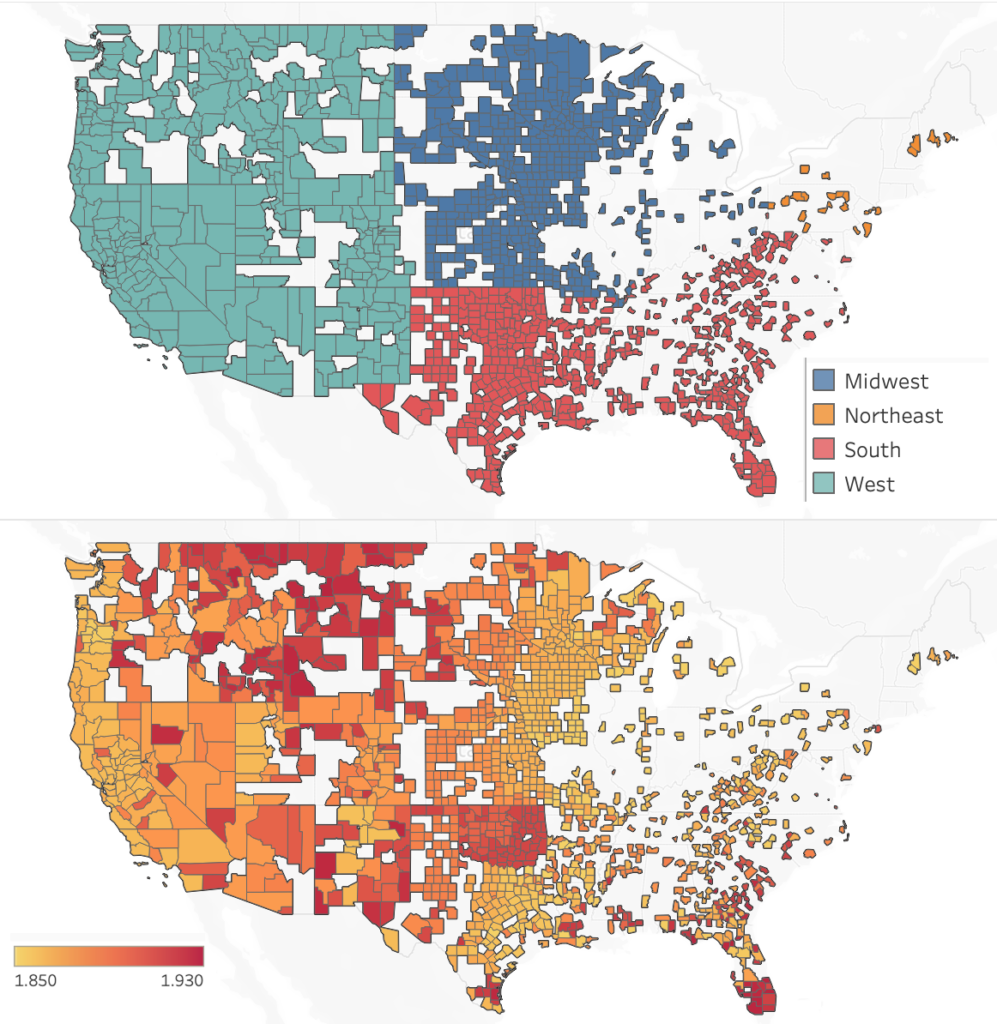
Notes: The figure shows the sample of US counties created between 1840 and 1940, color coded by US Census region in the top map. The bottom map displays the chronological timing of county creation. Light yellow refers to counties created earlier, while dark orange refers to counties created later. In both maps, gray areas indicate counties excluded from the analysis because they were either created before 1840, between 1880 and 1889, or after 1940. Source: Author’s compilation based on the Atlas of Historical County Boundaries data.
Figure II. Main Sample of New Counties
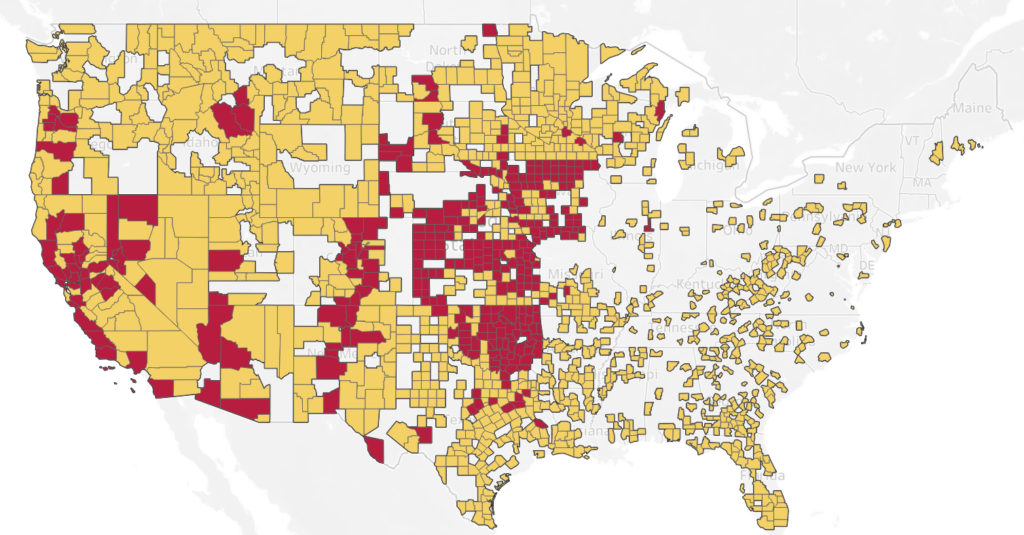
Notes: Red indicates the main sample of new counties, which includes those that were created between 1840 and 1940 from noncounty areas and were not subdivided or partitioned from previously established counties. Yellow indicates partitioned counties that are excluded from the main sample. Gray areas indicate counties that are excluded from the analysis because they were created before 1840, between 1880 and 1889, or after 1940. Source: Author’s compilation based on the Atlas of Historical County Boundaries data.
Tables
Table I. Descriptive Statistics
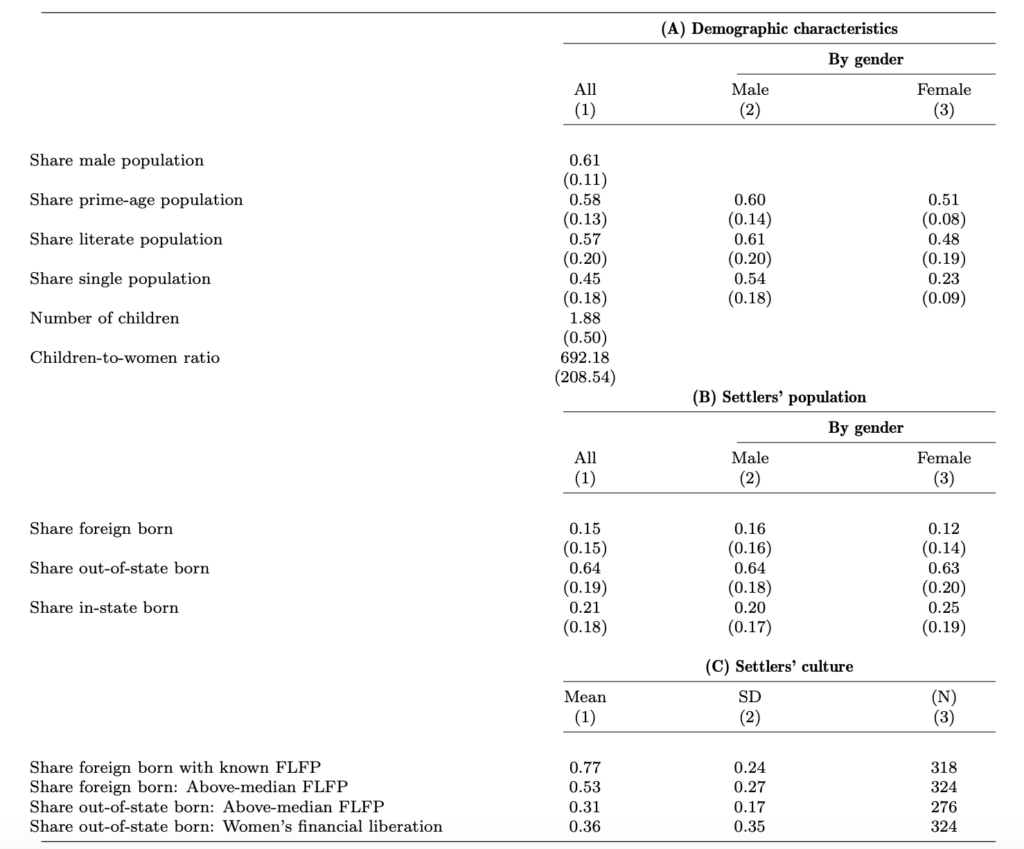
Notes: The sample is restricted to new counties. Settlers’ population is based on the first US Census available after the county creation date. Foreign-born individuals are those born outside the United States. Individuals born out of state are those born in a different US state from where their household resided at the time the census enumerator conducted the interview. In-state born individuals are those born in the same state where their household is located. All shares range between 0 and 1. In column (1) of Panels (A) and (B), shares are displayed out of the total settler population. In columns (2) and (3) of Panels (A) and (B), summary statistics are displayed by gender. Shares presented in columns (2) and (3) of Panels (A) and (B) represent the male and female settler populations, respectively. Prime age refers to ages 15 to 49. The number of children is based on the “nchild” variable from IPUMS, representing the number of women’s own children (regardless of marital status) residing in the same household. The children-to-women ratio is computed as the ratio of the number of children under 5 years of age over the number of women in their childbearing age times 1,000. Standard deviations are reported in parentheses in Panels (A) and (B). Shares of foreign-born settlers from countries with known and unknown FLFP add up to the entire foreign-born settler population. “Share foreign born: Above-median FLFP” is the share of foreign-born individuals from countries where the FLFP is above the median for that specific decade. “Share out-of-state born: Above-median FLFP” is the share of individuals born outside the state, from states where the FLFP rate exceeds the median for that specific decade. “Share out-of-state born: Women’s financial liberation” is the share of settlers born outside the state, within the total population of such settlers, coming from US states that granted women’s financial liberation before the settlers were observed. Means, standard deviations, and sample size are reported in columns (1)–(3) of Panel (C), respectively.
Table II. Historical Analysis: Settlers’ Culture and FLFP in US Counties
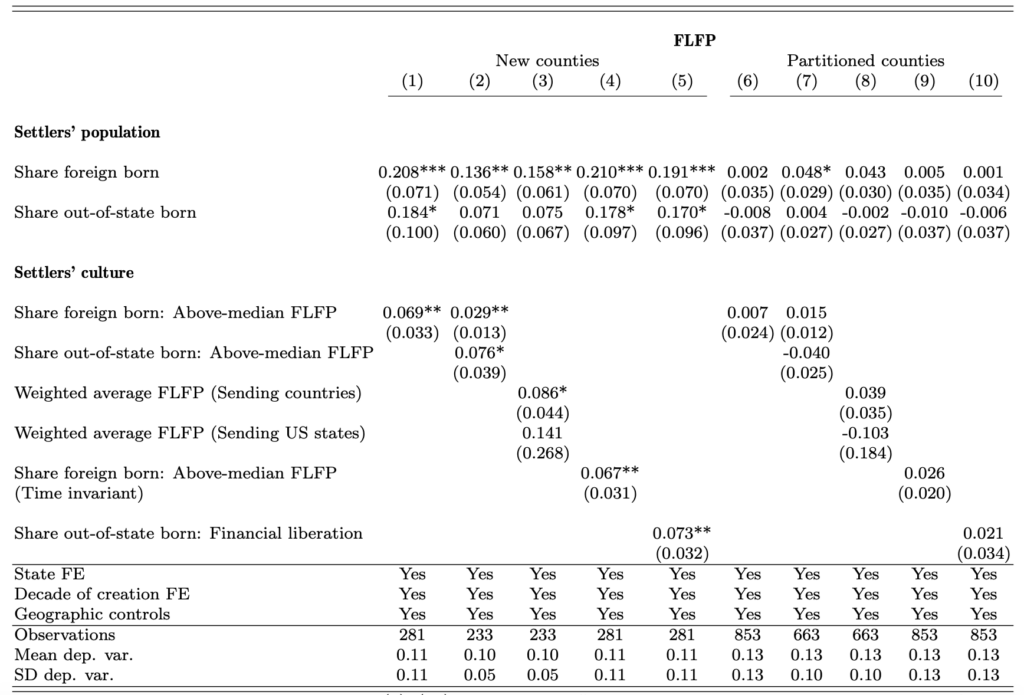
Notes: The dependent variable in columns (1)–(10) is FLFP in US counties in the short run. Data on labor force participation are based on the first US Census available after the county creation, and the sample of US counties includes those created between 1840 and 1940. In columns (1)–(5), the sample is restricted to new counties, and in columns (6)–(10), the sample is restricted to partitioned counties. Settler population is based on the first US Census available after the county creation date. Settlers’ culture is proxied for using FLFP from sending countries in columns (1)–(4) and (6)–(9), and women’s financial liberation in columns (5) and (10) to reflect gender norms at the place of origin. FLFP from sending countries (states) is extracted from the same decade, or a decade or two earlier, depending on data availability, from when I observe the foreign-born (out-of-state born) settler population. In columns (1), (2), (6), and (7), settler culture is proxied for using the share of foreign-born individuals from countries with known FLFP rates above the median for the specific decade, and the share of out-of-state born individuals from states with FLFP rates above the median for that same decade. In columns (3) and (8), settler culture is proxied for using a weighted average of FLFP from sending countries, weighted by the share of foreign-born settlers residing in a given US county and originating from a given country. The same measure is computed for the share of out-of-state born settlers. In columns (4) and (9), the share of foreign-born settlers from high (above-median) FLFP countries is computed based on countries’ time-invariant FLFP data. The time-invariant measure of origin-country gender norms is defined using the earliest (known) FLFP data available for each country as of 1840 (the first creation date of counties in my sample). In columns (5) and (10), settler culture is proxied for using women’s financial liberation. State fixed effects, decade of county creation fixed effects, and geographic controls are included in columns (1)–(10). Standard errors clustered on 60-square-mile grid cells are reported in parentheses. Significance levels: *** p<0.01, ** p<0.05, * p<0.1.
Table III. Settlers’ Population Demographic Characteristics
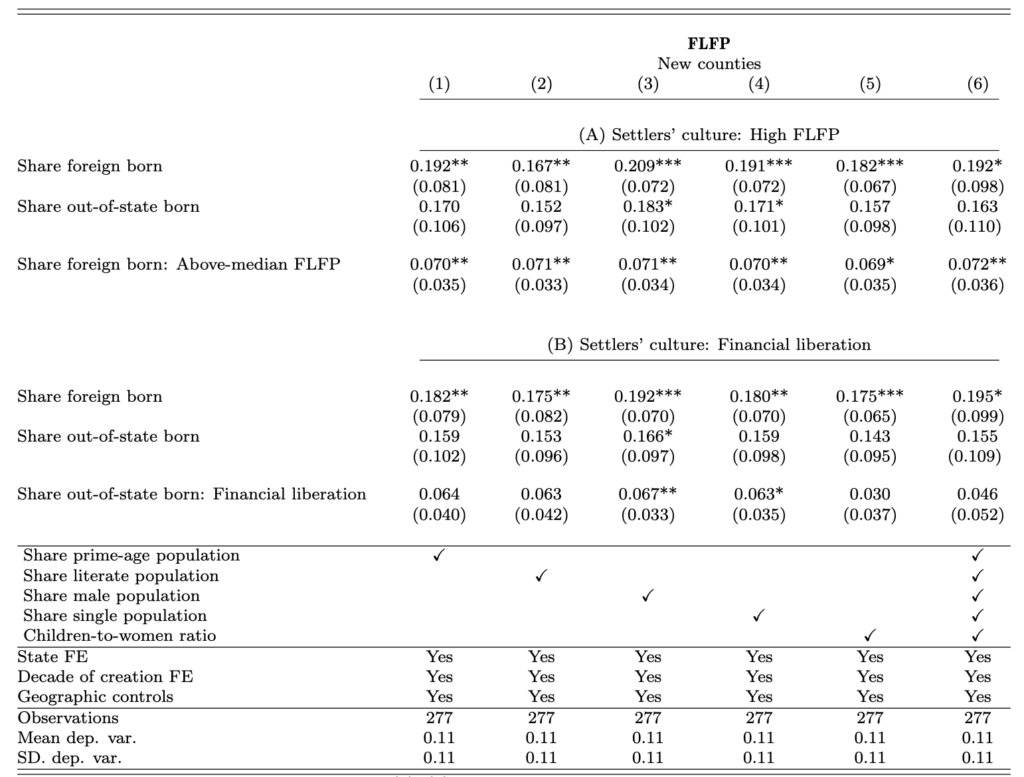
Notes: The dependent variable in columns (1)–(6) is FLFP in US counties in the short run. Data on labor force participation are based on the first US Census available after the county creation. The sample of US counties includes those created between 1840 and 1940, and it considers new counties only. Settler population is based on the first US Census available after the county creation date. In Panel (A), settlers’ culture is proxied for using FLFP from sending countries. In Panel (B) it is proxied for using women’s financial rights. FLFP from sending countries is extracted from the same decade, or a decade or two earlier, depending on data availability, from when I observe the foreign-born settler population. State fixed effects, decade of county creation fixed effects, and geographic controls are included in columns (1)–(6). The last column accounts for the demographic characteristics of settlers. Standard errors clustered on 60-square-mile grid cells are reported in parentheses. Significance levels: *** p<0.01, ** p<0.05, * p<0.1.
Table IV. Accounting for Additional Controls
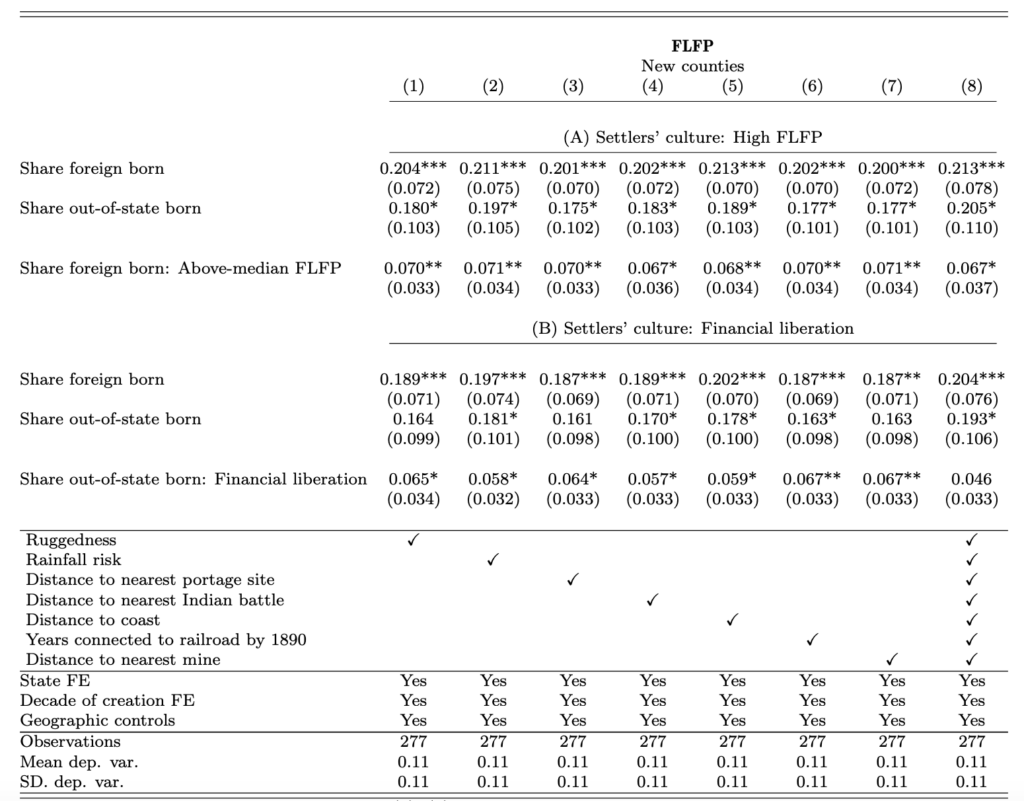
Notes: The dependent variable in columns (1)–(8) is FLFP in US counties in the short run. Data on labor force participation are based on the first US Census available after the county creation. The sample of US counties includes those created between 1840 and 1940, and it considers new counties only. Settler population is based on the first US Census available after the county creation date. In Panel (A), settlers’ culture is proxied for using FLFP from sending countries. In Panel (B) it is proxied for using women’s financial rights. FLFP from sending countries is extracted from the same decade, or a decade or two earlier, depending on data availability, from when I observe the foreign-born settler population. State fixed effects, decade of county creation fixed effects, and geographic controls are included in columns (1)–(9). The last column accounts for the exhaustive list of isolation and county-level geography controls. Standard errors clustered on 60-square-mile grid cells are reported in parentheses. Significance levels: *** p<0.01, ** p<0.05, * p<0.1.
Table V. Sensitivity Analysis to Alternative Definitions of FLFP from Sending Origins
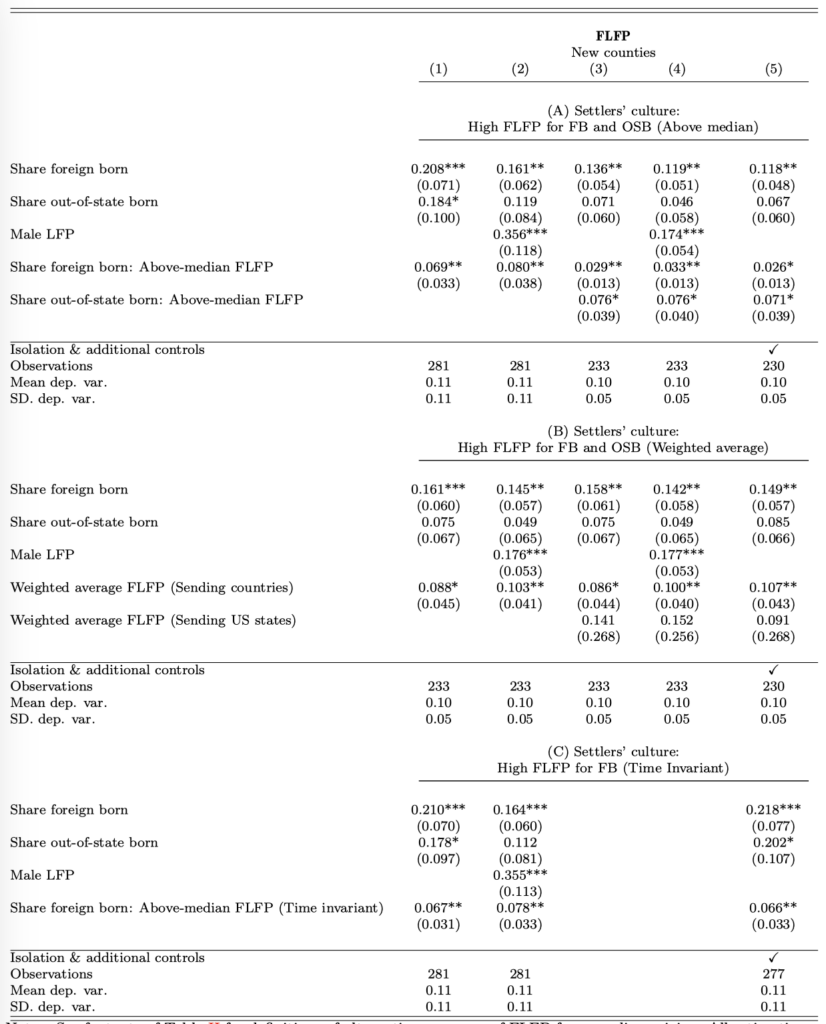
Notes: See footnote of Table II for definitions of alternative measures of FLFP from sending origins. All estimations include state fixed effects, decade of county creation fixed effects, and county-level geographic controls. Isolation and additional controls are listed in Appendix Table IV. Male LFP is contemporaneous county-level male labor force participation, constructed using data from the first US Census available after county creation and measured as the share of men aged 16+ who are in the labor force.
Table VI. Later Settlers’ Culture and FLFP in US Counties: Historical Analysis
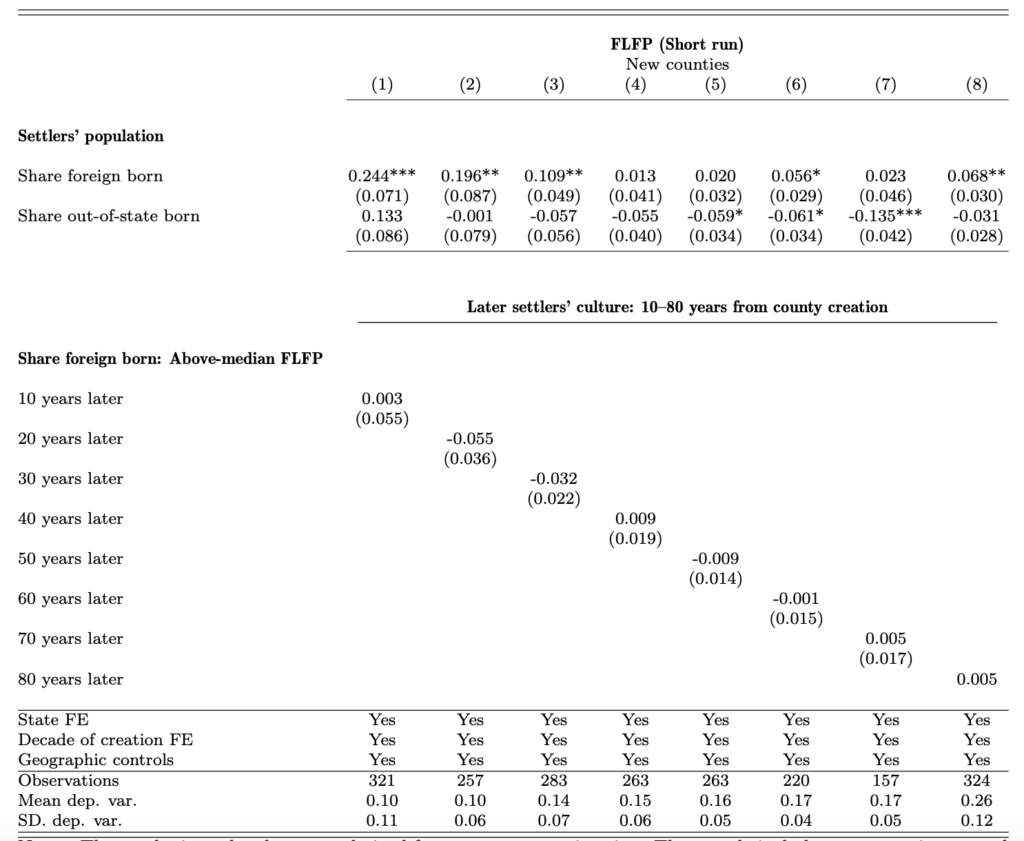
Notes: The results in each column are derived from a separate estimation. The sample includes new counties created between 1840 and 1940. The dependent variable in columns (1)–(8) is FLFP in US counties in the short run. In columns (1)–(8), data on labor force participation in US counties are based on the 2nd, 3rd, … 8th census available after the county creation date (i.e., 10, 20, … 80 years later), respectively. Later settlers’ population is based on the 2nd, 3rd, … 8th census available after the county creation date. In column (1), later settlers’ culture for each US county is measured using the share of foreign-born individuals who reside in that county 10 years after its creation and originate from high-FLFP sending countries. Settlers’ culture in columns (2)–(8) is measured using the share of foreign-born individuals who reside in that county 20–80 years after its creation and originate from high-FLFP sending countries. FLFP from sending countries is extracted from the same decade, or a decade or two earlier, depending on data availability, from when I observe the foreign-born settlers’ population. State fixed effects, decade of county creation fixed effects, and a set of geographic controls are included in columns (1)–(8). Standard errors clustered on 60-square-mile grid cells are reported in parentheses. Significance levels: *** p<0.01, ** p<0.05, * p<0.1.
Table VII. Long-Run Analysis: Settlers’ Culture and FLFP in US Counties
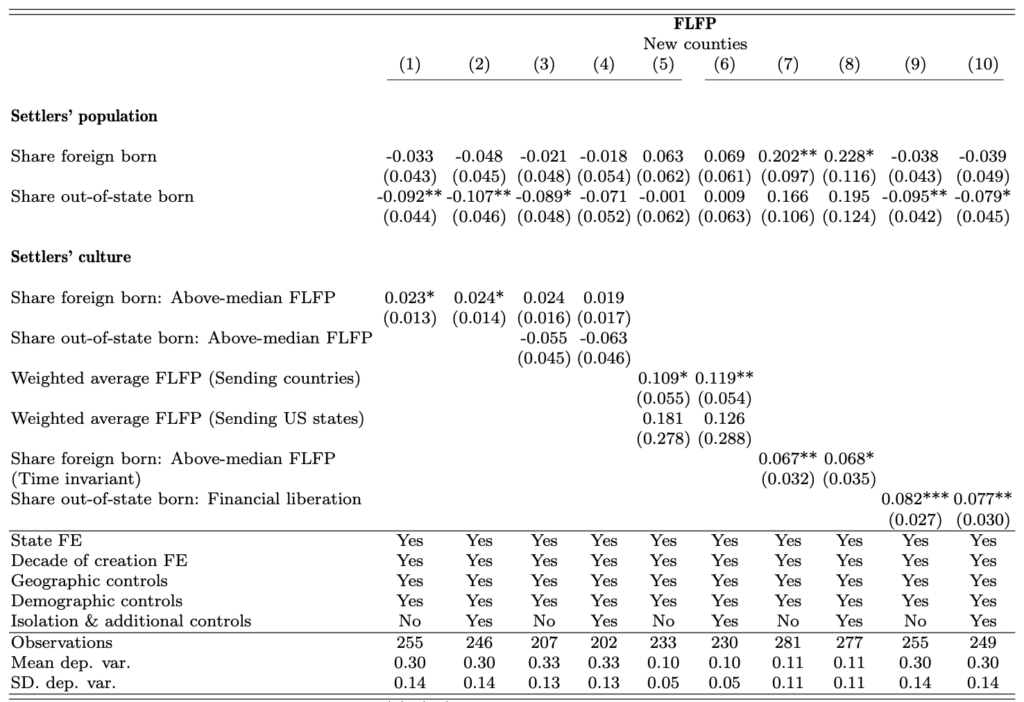
Notes: The dependent variable in columns (1)–(10) is FLFP in US counties in the long run. Data on labor force participation are based on the 10th US Census available after the county creation (100 years later). The sample of US counties includes those created between 1840 and 1940 and is restricted to new counties. Settler population is based on the first US Census available after the county creation date. Settlers’ culture is proxied for using FLFP from sending countries (states) in columns (1)–(8), and women’s financial liberation in columns (9) and (10) to reflect gender norms at the place of origin. FLFP from sending countries is extracted from the same decade, or a decade or two earlier, depending on data availability, from when I observe the foreign-born settler population. State fixed effects, decade of county creation fixed effects, geographic controls, and demographic controls are included in columns (1)–(6). Standard errors clustered on 60-square-mile grid cells are reported in parentheses. Significance levels: *** p<0.01, ** p<0.05, * p<0.1.
Table VIII. Later Settlers’ Culture and FLFP in US Counties: Persistence Analysis
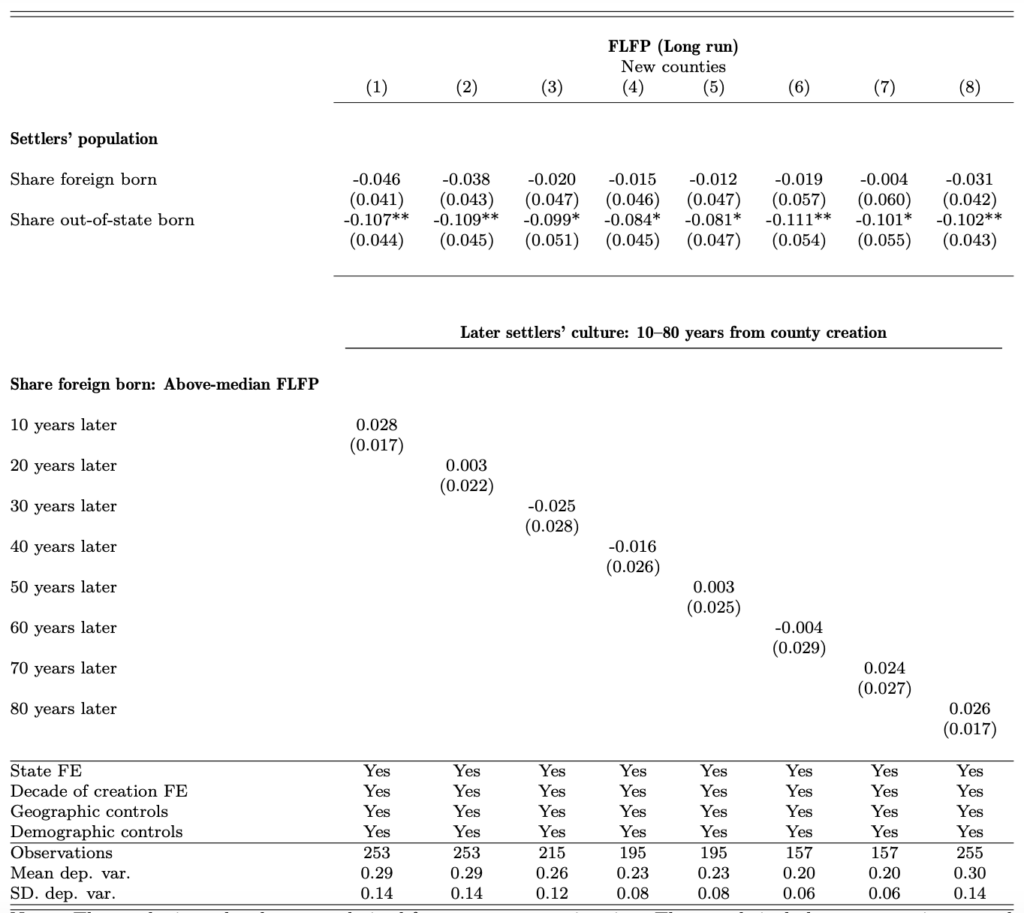
Notes: The results in each column are derived from a separate estimation. The sample includes new counties created between 1840 and 1940. The dependent variable in columns (1)–(8) is FLFP in US counties in the long run. In columns (1)–(8), data on labor force participation in US counties is based on the 10th Census available after the county creation date. Later settlers’ population is based on the 2nd, 3rd, … 8th Census available after the county creation date. In column (1), later settlers’ culture for each US county is measured using the share of foreign-born individuals who reside in that county 10 years after its creation and originate from high-FLFP-sending countries. Settlers’ culture in columns (2)–(8) is measured using the share of foreign-born individuals who reside in that county 20–80 years after its creation and originate from high-FLFP-sending countries. FLFP from sending countries is extracted from the same decade, or a decade or two earlier, depending on data availability, from when I observe my foreign-born settlers’ population. State fixed effects, decade of county creation fixed effects, and a set of geographic controls are included in columns (1)–(8). Standard errors clustered on 60-square-mile grid cells are reported in parentheses. Significance levels: *** p<0.01, ** p<0.05, * p<0.1.
Table IX. Attitudes Regarding Women’s Roles: GSS and LSS
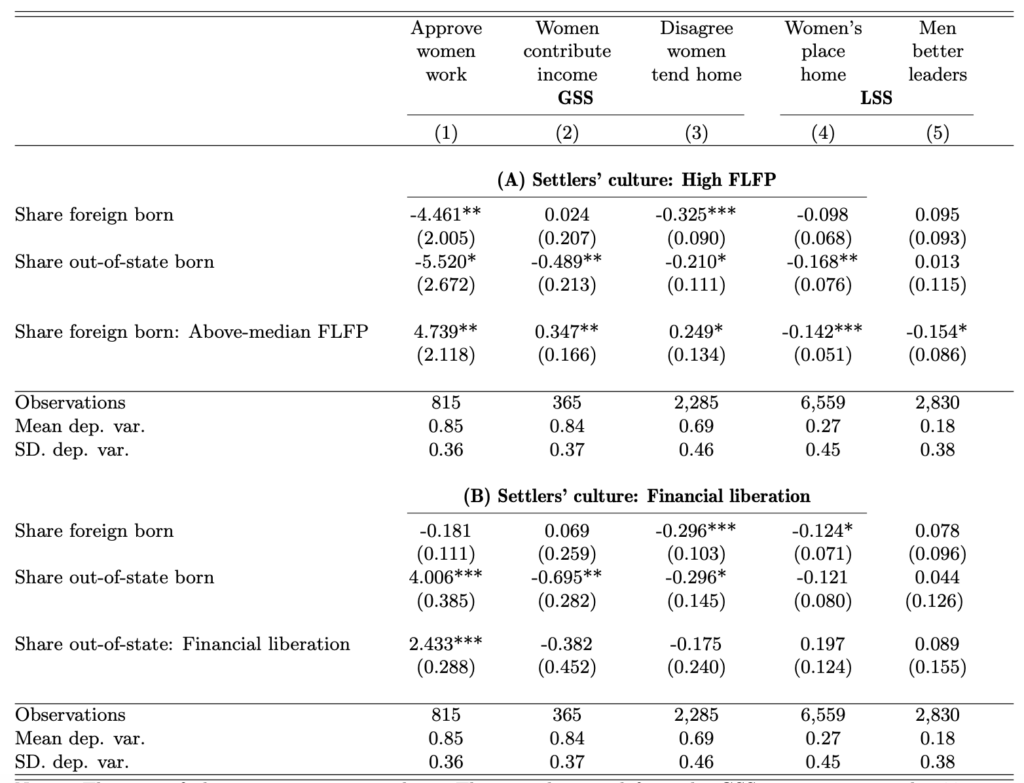
Notes: The unit of observation is a respondent. The period covered from the GSS is 1993–1998 and 1977–1998 from the LSS. The dependent variables in columns (1)–(5) are binary indicators for whether the respondent approves women working, agrees that both the husband and wife should contribute to the household income, disagrees that it is better for men to work while women tend the home, believes a woman’s place is in the home, and believes men are naturally better leaders than women, respectively. Settlers’ culture is proxied for using the share of foreign-born settlers from high-FLFP countries in Panel (A), and the share of out-of-state born settlers coming from places where women were granted financial rights in Panel (B). State fixed effects, decade of county creation fixed effects, GSS and LSS survey year fixed effects, geographic controls, and individual-level demographic controls (sex, age, age squared, education level, race, marital status, and fertility) are included in columns (1)–(5). Race is omitted from the LSS analysis given that it was not asked before 1993. Standard errors clustered on 60-square-mile grid cells are reported in parentheses. Significance levels: *** p<0.01, ** p<0.05, * p<0.1.
Appendix: For Online Publication
7.1 Early Settlement: Alternative Definitions
This paper provides an empirical analysis of the cultural imprints of early effective settlement in the United States. To understand the cultural legacy of the initial settlers of a given US county, I capture their population using information about the people who lived in US counties around the time of their creation. Focusing on newly formed counties does not aim to capture when a US county is formally defined as an administrative unit; rather, it is a way to capture early settlement.
Alternatively, other definitions of early settlers can rely on population or population density cutoffs for the entire sample of US counties, not just those that were newly created. One can also plausibly rely on the population in the first fixed number of years of settlement to define early settlers. Ideally, I can explore the cultural composition of the initial settlers in all US counties in an equal and uniform way by defining the composition of its population when it first passed some population density or economic development threshold. However, and due to data limitations, this is not feasible.
While these alternative definitions are relevant and more comprehensive of the United States, they remain empirically challenging to adopt. This is particularly true given that the first full-count US Census data that are publicly available starts in 1850—the year also in which the outcome variable of interest, FLFP, is first available. This means that for counties formed before 1850, relying on the 1850 Census data does not capture the first settlers but rather the population that inhabited these counties in 1850, which is years after their formation (particularly the time since they were first created). Of note, this is the case for US counties from the 1860 Census and onward. Additionally, if these US counties are considered in the 1850 and onward analysis, they would not be reflecting the critical juncture phase of cultural and institutional development. Rather, they would reflect advanced stages of settlement.
Tying the definition of early settlers to the creation of a US county allows me to better capture the first people who inhabited these areas. It must be noted that population and population density cutoffs correlate with the timing of county creation. Appendix Figure A4 plots the population densities for all US counties available from the 1850 Census, the year of county creation, and time since creation, computed as the difference between 1850 and the year the US counties were created. The figure shows that US counties created long before 1850 are significantly densely populated in 1850 compared created close to 1850. Defining the county as “newly settled” when it reaches a given population threshold instead would have also excluded from the analysis those densely populated areas by 1850.
From the perspective of cultural transmission, it does not matter when a county is formally defined as an administrative unit. Rather, what matters is whether a US county is in its critical junctures of institutional and cultural formation and whether the first effective settlement shapes the local culture. Focusing on county creation events and digging further into the type of new counties created, the difference between new and partitioned counties conceptually captures divergence in early settlement stages, population density, and early versus advanced stages of development.
To further confirm this, I follow Bazzi et al. (2020)’s population density cutoff, which is based on the cutoff stipulated by Porter et al. (1890) to define “fully settled” (established postfrontier settlements) areas. Examining population densities of newly created counties before 1890, the date marking the end of the frontier era (Bazzi et al. 2020; Porter et al. 1890) reveals that about 80 percent, 71 percent, and 93 percent of new US counties created in 1850, 1860, and 1870, respectively, have population densities below six people per square mile. As previously mentioned, I disregard US counties created between 1880 and 1889 due to missing census data for 1890 from all sources.
7.2 Data on US Counties
The Atlas of Historical County Boundaries provides detailed information about each county event. Events are dated and any change is stated along with the start and end date. Each US county has a unique identifier, but many versions exist depending on the number of changes to either the county’s size or shape. In total there are 3,143 unique county identifiers that reflect all US counties. The focus of this paper is on the initial event for each county identifier, which is the creation of a given county.
7.2.1 Classification: New and Partitioned Counties
Suppose at time that two counties, county A and county B, are created from noncounty areas. Each has its own ID code in ICPSR/NHGIS/Atlas of Historical County Boundaries. Both counties are classified as new counties at time
. The first event, the creation of these two counties from noncounty areas, would be coded in the Atlas of Historical County Boundaries.
Consider that at , a new county “a” is created from county A. While county A keeps its own ID code, it now has a new second event registered to reflect the loss of area to county a. County a, which has its own ID code, has its first event coded to reflect its creation from county A. County a is classified as partitioned given that it is created from an already established county A. Note that the classification is not based on which of the two partitioned counties keeps the original name or ID code but on the chronology and type of creation events. Here, county a is created after county A and as a partition from it.
I define settlers’ population for counties A and a using population data from the first census data available at and
, respectively. One might argue that the initial composition of settlers in county a is measured with error, if the composition of settlers in county A is identical at
. Unfortunately, due to the absence of any dis-aggregate information on the distribution of settlers within county A in
, it is impossible to check for this.
However, if we assume that using population data from the first census available at captures later (rather than early) settlers of county a, this assumption supports the idea of the relative importance of early settlers in cultural formation compared to later ones. Alternatively, if the population of initial settlers is measured accurately, this confirms that immigration contributes to propagating and entrenching norms carried by immigrants in newly established locations only when it coincides with the critical juncture phase of cultural and institutional development at the destination.
7.3 Settlers’ Culture
The share of foreign-born settlers from countries with FLFP rates above the median for the specific decade is obtained by first computing the median FLFP in a given decade, based on available data on women’s labor force participation from sending countries. The next step is to generate the total number of foreign-born migrants coming from countries with above-decade-specific median FLFP. The last step is to divide this by the total foreign-born settler population with known FLFP.
To examine the share of settlers coming from places where women were granted financial rights, I construct a state of origin variable set equal to 1 if financial rights were granted to women. I then calculate the share of out-of-state born settlers within the total population of such settlers from US states where women were granted financial rights before the observation period of these settlers.
7.4 Snapshot of Top Sending Countries/States
I compute an overview of the number of US counties created between 1840 and 1940 and provide a list of settlers’ top five sending countries/states in Appendix Table A15. I also provide a snapshot of FLFP and women’s financial rights for these countries/states, as well as the classification of newly created counties across new and partitioned counties.
7.5 Case Study Illustrating Short- and Long-Run Effects
To help fix ideas, I consider two adjacent, newly created counties as a case study. I choose two counties that are located within the same state and created at the same time but differ in the composition of settlers, particularly their cultural characteristics. Cherokee and Sioux county were both created in 1851 in Iowa state. Both also belong to the sample of new counties, i.e., were created from noncounty areas. Examining the culture of settlers who inhabited these counties reveals that Cherokee County, which hosted a large share of settlers coming from places with high FLFP and where women had financial rights, has higher FLFP both historically and nowadays compared to Sioux County.
About 56 percent of settlers born out of state residing in Cherokee County come from US states that granted financial liberation to women. All foreign-born settlers, with known FLFP data, come from high-FLFP countries. As an opposing extreme case, Sioux County had none of its foreign and out-of-state born population originating from high-FLFP places nor from those that granted women financial rights. These historical differences in settlers’ culture translate into substantial differences in FLFP that persist over time. See Appendix Figures A16 and A17 for a visualization of this case study analysis.
7.6 Precounty Creation Population
To infer the “time at move,” I rely on two key variables in the full-count census data. First, I use household identifiers, and second, I use a variable indicating each household member’s relationship to the head of the household, in order to remove single-person households or households without at least one child. I also impose that the country/state of birth of children of households with only one child must be different from the state where the census enumerator conducted the interview (i.e., the household’s state of residence). Otherwise, I would be capturing some households that never moved/migrated. If the household has more than one child, at least one should be born in a place that is different from the current place of residence.
I follow the method that Bazzi et al. (2020) adopt in their analysis and that is similar to Collins and Zimran (2019) to infer the timing of migration as the difference between the current census year and the child birth year for families with one child born before the move and zero children born after migration, divided by two. For families with one child born in the current state of residence and one child born earlier in a different country/state, I infer the move time as the difference between child birth years, divided by two.
Figure A1. Territorial Expansion Events
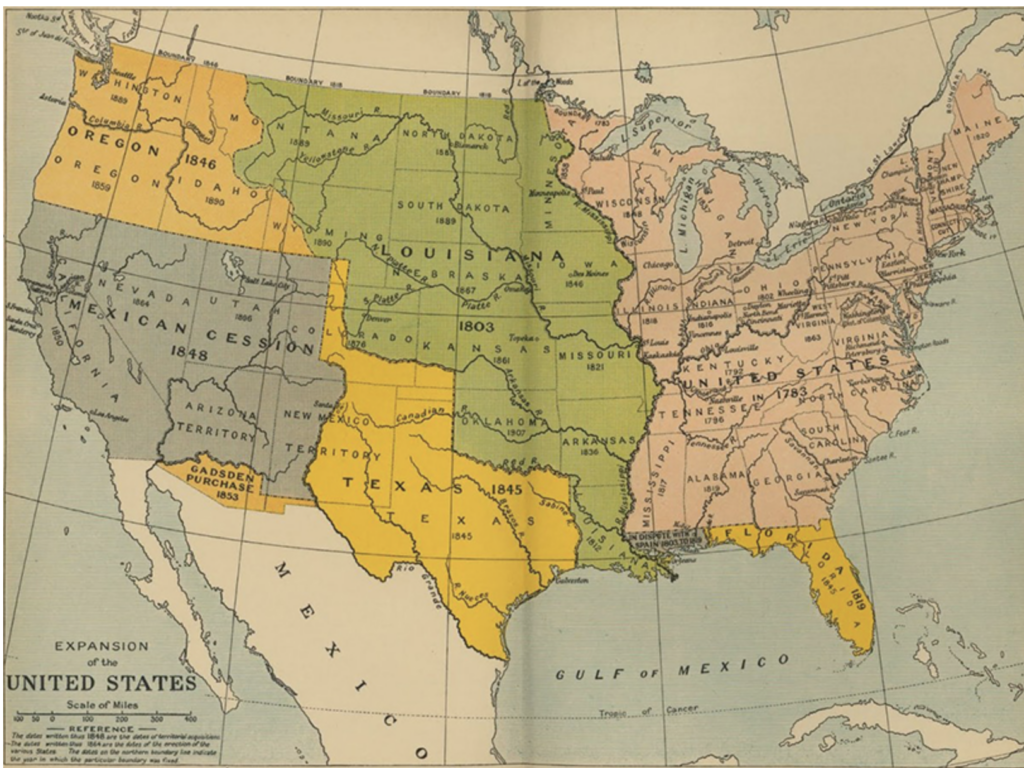
Notes: The map shows the five largest territorial expansion events after the 13 original colonies that constituted the United States. These include the Louisiana Purchase (1803), the Adams-Onis Treaty (1819), the Texas Annexation (1845), the Mexican Cession (1848), and the Alaska Purchase (1867). Source: https://www.visualcapitalist.com/us-territorial-expansion/.
Figure A2. Sample Act for County Creation

Notes: The figure shows archived information from the “Inventory of the County Archives of Alabama,” issue 46, showing the territorial act enacted in 1818 by the territorial legislature of Alabama, which established Morengo County. Source: Inventory of the County Archives.
Figure A3. Sample Act for County Creation as a Subdivision
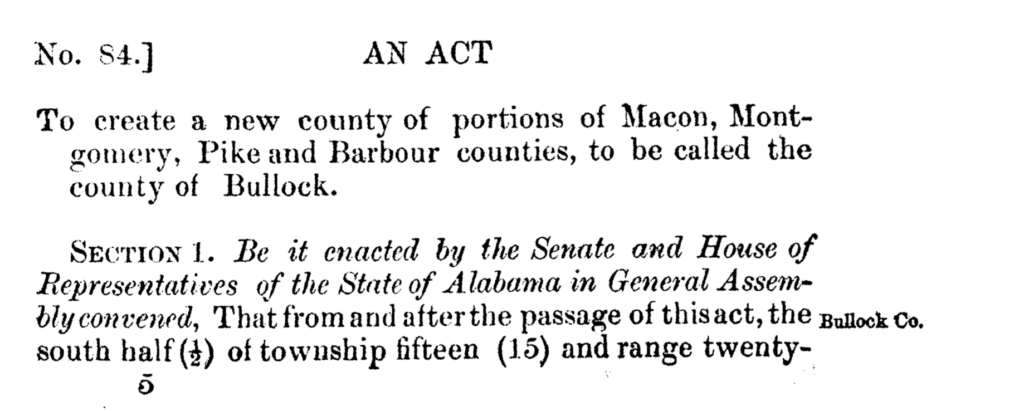
Notes: The figure shows an extract from the “General Assembly of Alabama,” showing an act enabled by Alabama to establish a new county as a subdivision of previously formed counties. Source: Alabama’s state constitution.
Figure A4. County Creation and Population Density
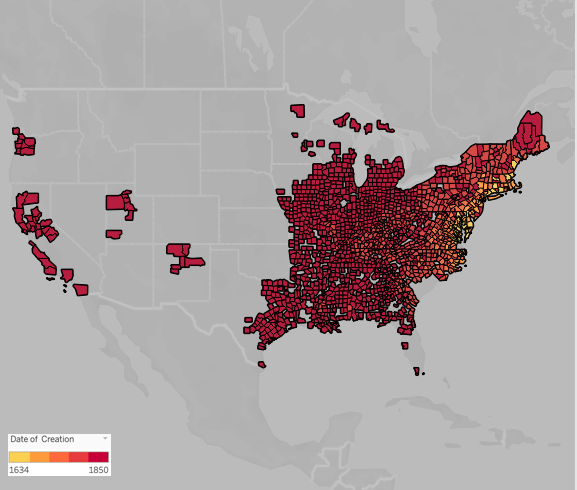
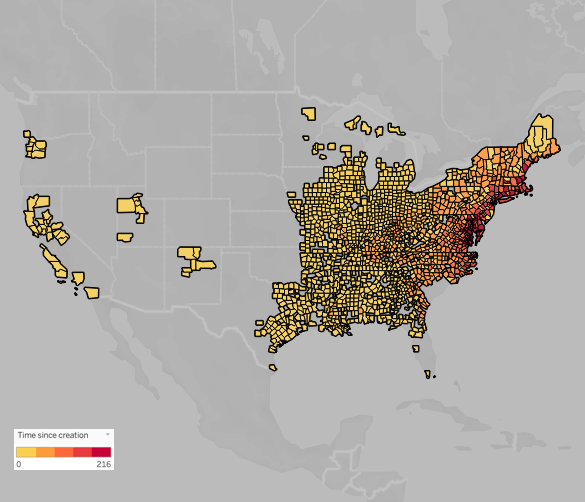
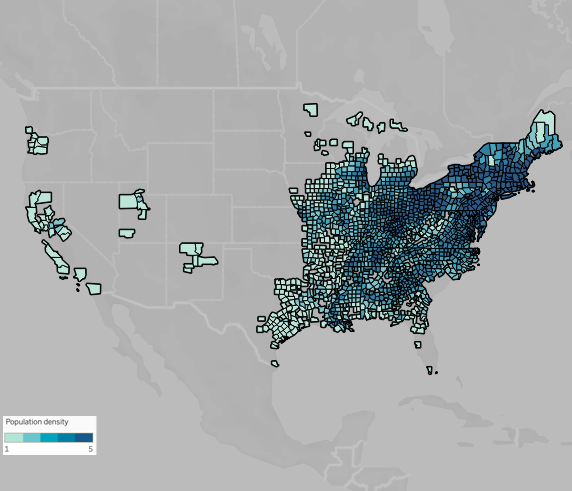
Notes: Maps display the year of creation for all US counties available in the 1850 full-count census, with the time since creation computed as the difference between 1850 and year of creation of each county, along with population density from the 1850 Census data. Yellow areas indicate counties created earlier, while dark red areas indicate counties created closer to 1850. Light blue areas indicate lower population densities in 1850, and dark blue indicates greater ones. Gray areas indicate counties that are created after 1850. Source: Author’s compilation based on the Atlas of Historical County Boundaries data and 1850 US Census data.
Figure A5. Settler Population by Origin: Sample of New Counties
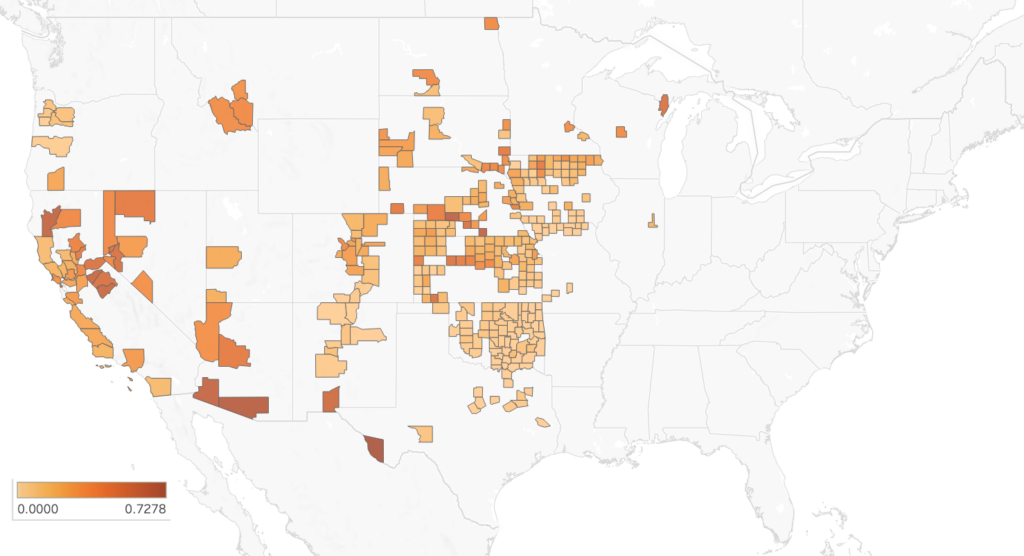
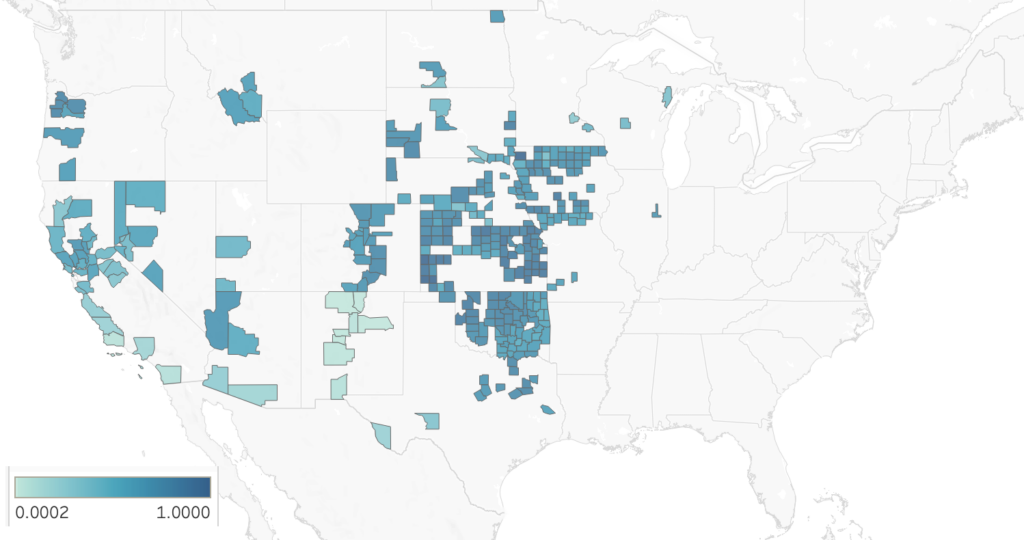
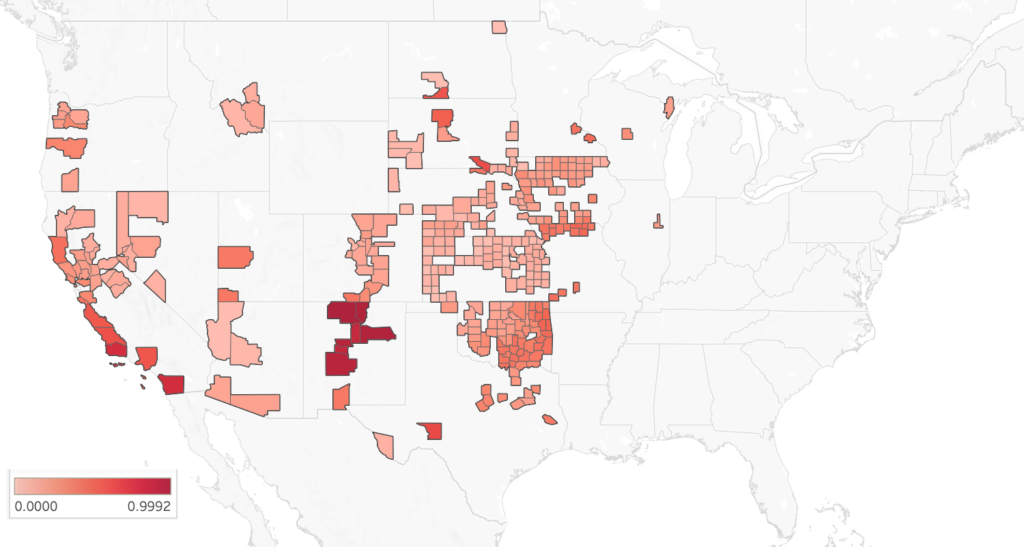
Notes: The maps show shares of foreign-born, out-of-state, and in-state born individuals out of the total population, respectively. Foreign-born individuals are those born in a country outside the United States. Individuals born out of state are those born in a different US state from where their household resided at the time the census enumerator conducted the interview. In-state born individuals are those born in the same state where their household is located. Shares range between 0 and 1, with 0 indicating no foreign-born (out-of-state, in-state) settlers in the county and 1 indicating that all individuals living in the county are foreign born (out of state, in state). Light orange, blue, and red indicate lower shares, while dark orange, blue, and red indicate greater shares. Source: Author’s compilation based on full-count census data from Ruggles et al. (2020).
Figure A6. Settler Population by Origin: Sample of Partitioned Counties
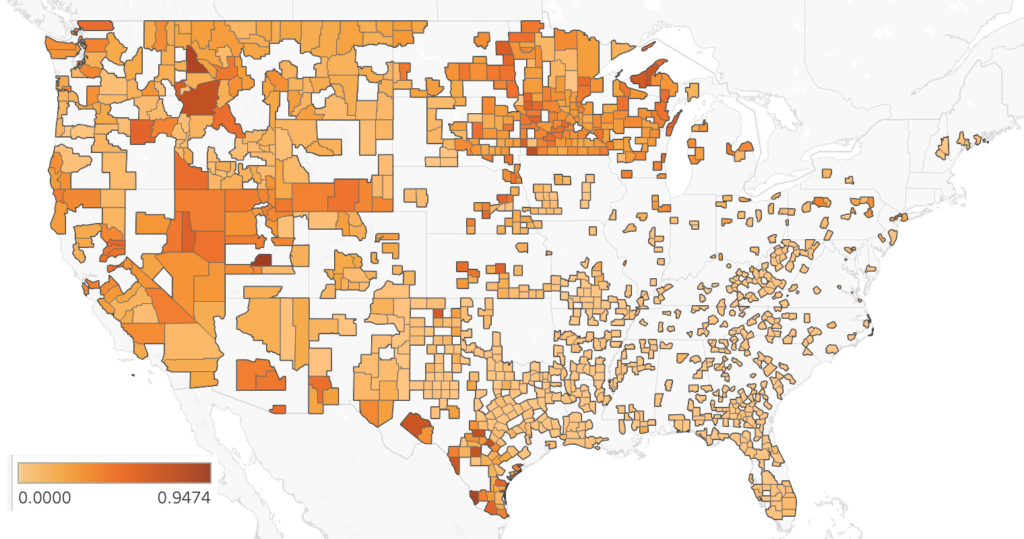
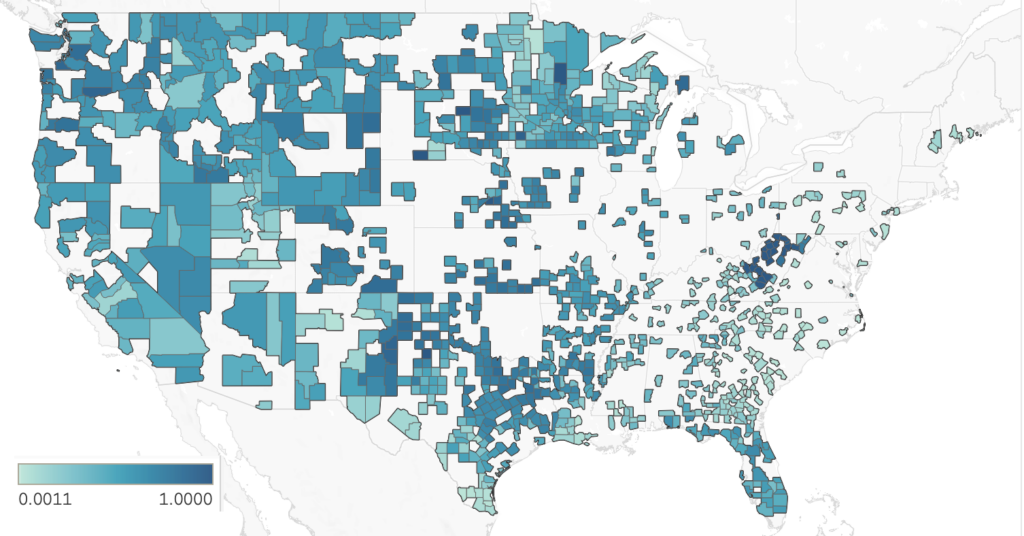
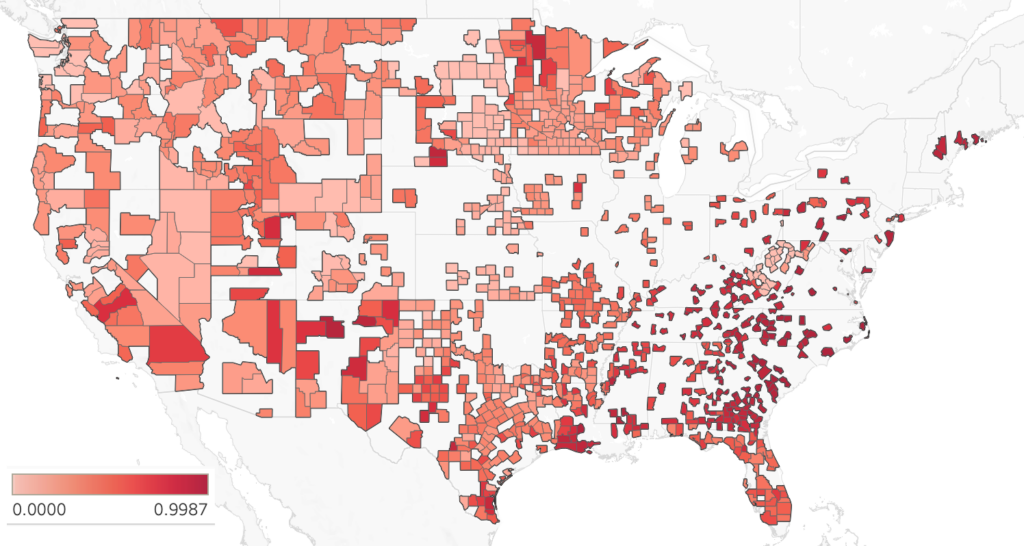
Notes: The maps show shares of foreign-born, out-of-state, and in-state born individuals out of the total population, respectively. Light orange, blue, and red indicate lower shares, while dark orange, blue, and red indicate greater shares. Gray areas indicate counties that are excluded from the sample. Source: Author’s compilation.
Figure A7. Foreign-Born Settlers from High-FLFP Countries: Sample of New Counties
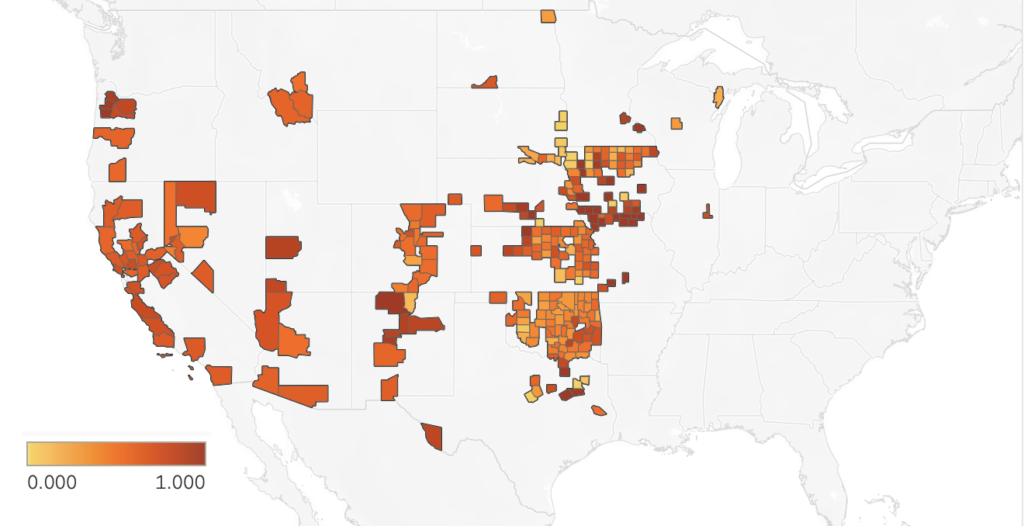
Notes: The map shows the share of foreign-born settlers from countries known to have above-median FLFP. Gray areas indicate counties that are excluded from the main sample of new counties. Light yellow indicates a small share of foreign-born settlers coming from high-FLFP countries, while dark orange indicates a high share. Source: Author’s compilation based on full-count census data from Ruggles et al. (2020). The data on country-level FLFP are based on Minnesota Population Center (2020), Olivetti (2014), and Olivetti and Petrongolo (2016).
Figure A8. Map of Foreign-Born Settlers from Countries with High FLFP: Sample of Partitioned
Counties
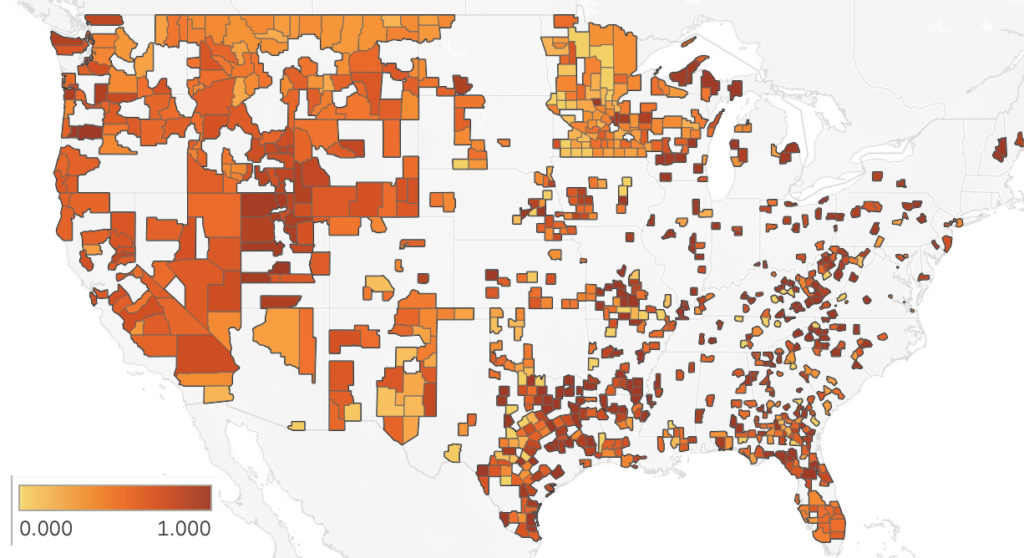
Notes: The map shows the share of foreign-born settlers from countries known to have above-median FLFP. Gray areas indicate counties that are excluded from the sample. Light yellow indicates a small share of foreign-born settlers coming from counties with above-median FLFP, while dark orange indicates a high share. Source: Author’s compilation.
Figure A9. Women’s Financial Liberation, Year Granted by State
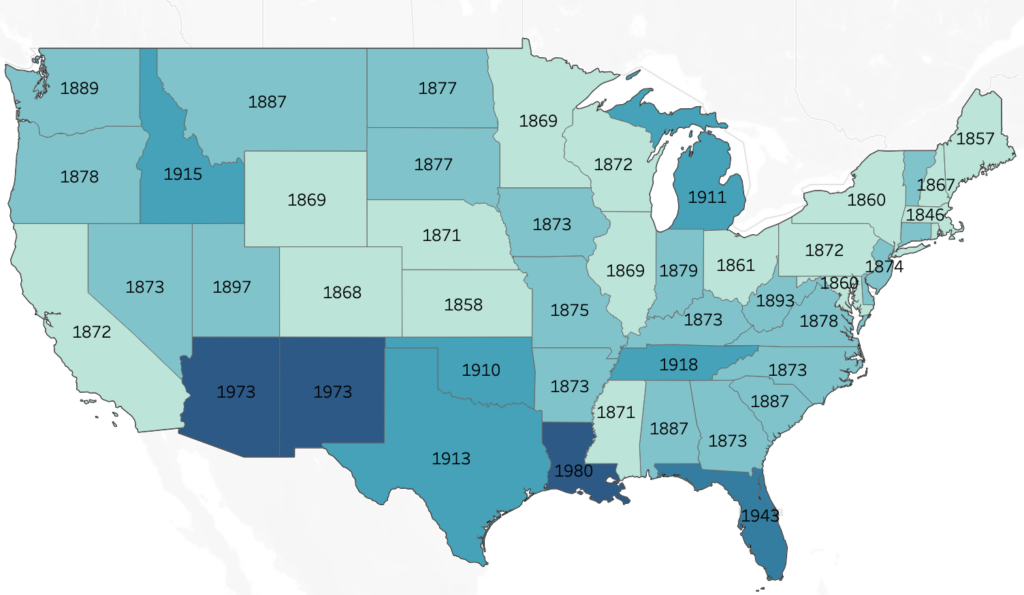
Notes: The map shows the year in which each US state granted women financial rights to retain property and labor earnings. Source: Author’s compilation based on data from Hansen et al. (2015).
Figure A10. Out-of-State Settlers from US States Granting Women Financial Rights: Sample of
New Counties
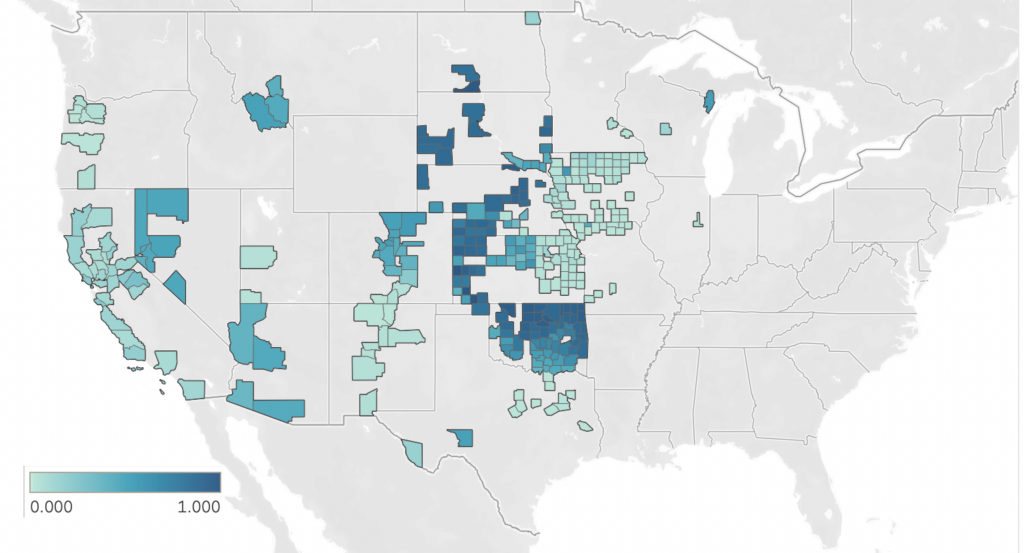
Notes: The map shows the share of out-of-state born settlers from US states where women’s financial liberation was granted before the observation period, compared to the total out-of-state settler population. Gray areas indicate counties that are excluded from the main sample of new counties. Light blue indicates a small share of out-of-state born settlers coming from US states where women had property and earning rights. Dark blue indicates a high share. Source: Author’s compilation. Data on the timing of granting women financial rights by US state are obtained from Geddes and Dean (2002).
Figure A11. Out-of-State Settlers from US States Granting Women Financial Rights: Sample of
Partitioned Counties
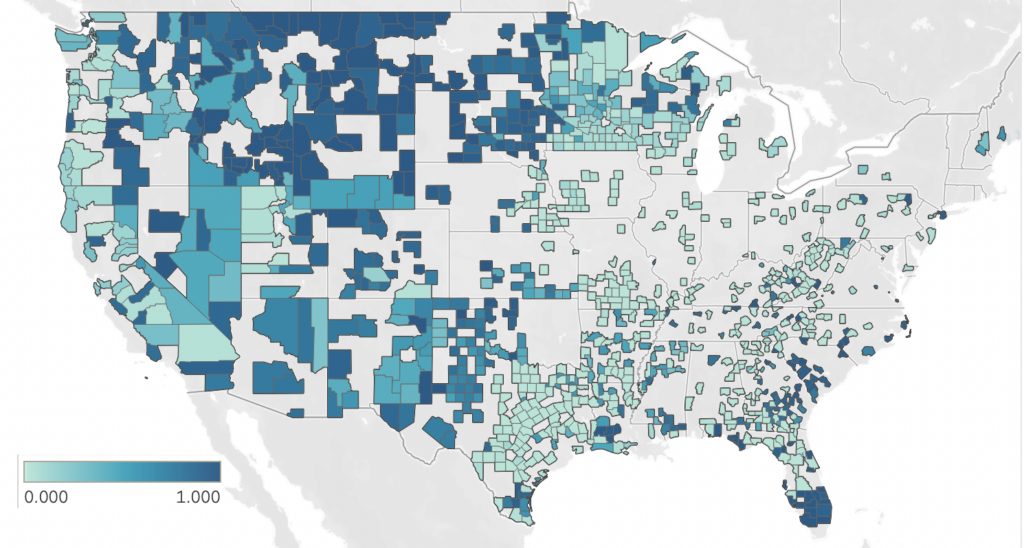
Notes: The map shows the share of out-of-state born settlers from US states where women’s financial liberation was granted before the observation period, compared to the total out-of-state settler population. Gray areas indicate counties that are excluded from the sample. Light blue areas indicate a small share of out-of-state born settlers coming from US states where women had property and earning rights, and blue areas indicate a high share. Source: Author’s compilation.
Figure A12. FLFP from Sending Countries
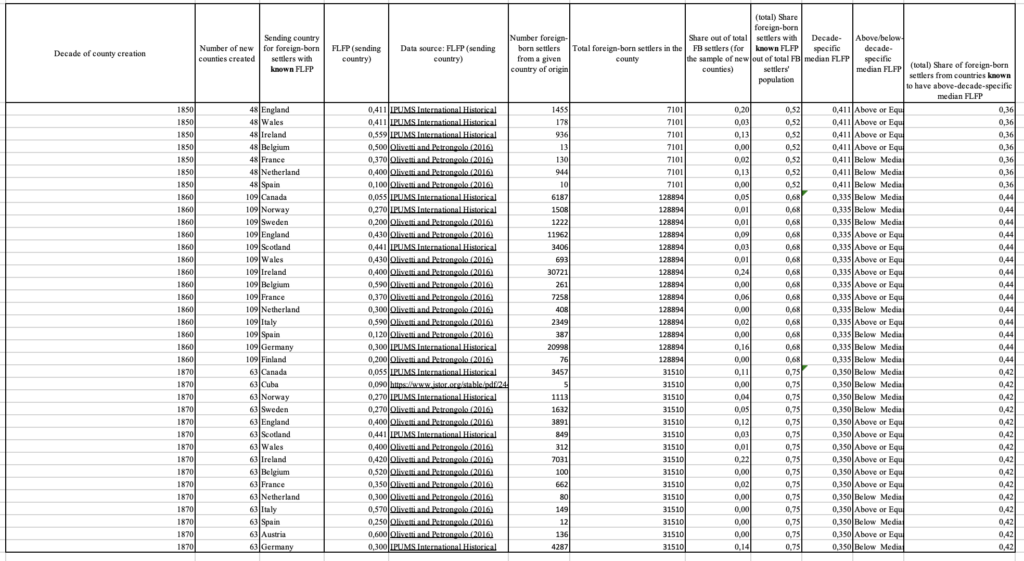
Notes: The figure shows the decade-specific number of newly created counties, countries of origin for foreign-born settlers from countries with known FLFP data, and FLFP for sending countries and relevant sources. It also shows the share of foreign-born migrants within the total foreign-born population originating from countries with known FLFP data, and the share of foreign-born settlers from high-FLFP countries. Source: Author’s compilation.
Figure A13. FLFP from Sending Countries (Ctd.)
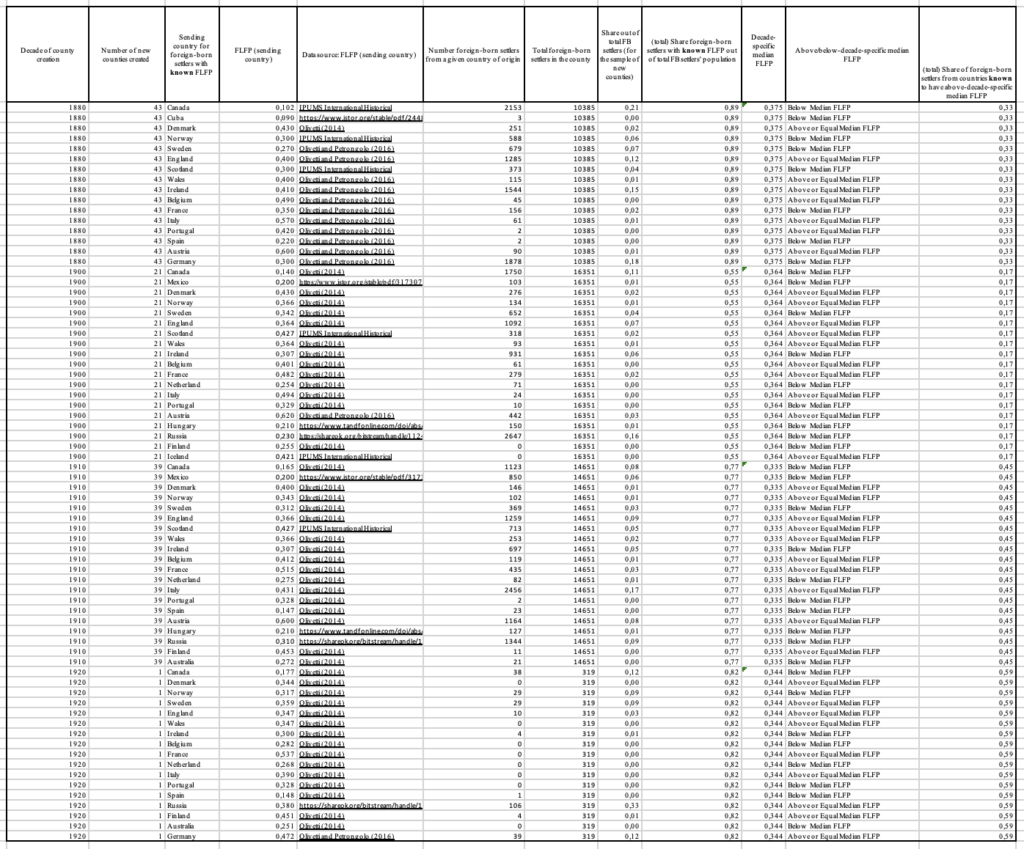
Notes: See footnote of Appendix Figure A12. Source: Author’s compilation.
Figure A14. Strategy Visualization
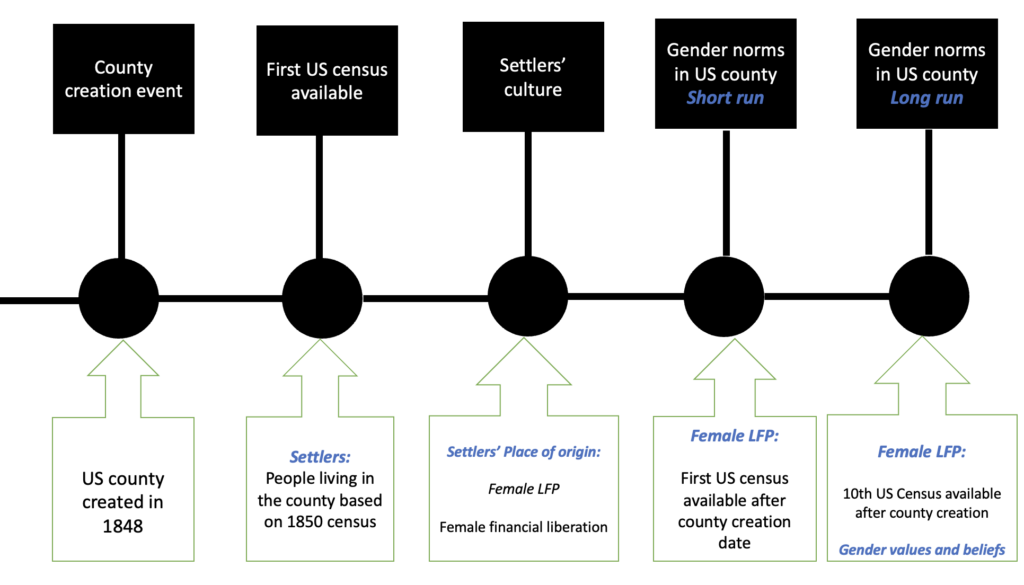
Notes: The figure provides visual display of the methodology used in this paper. Source: Author’s compilation.
Figure A15. Settlers’ Culture and FLFP: Semiparametric Estimates
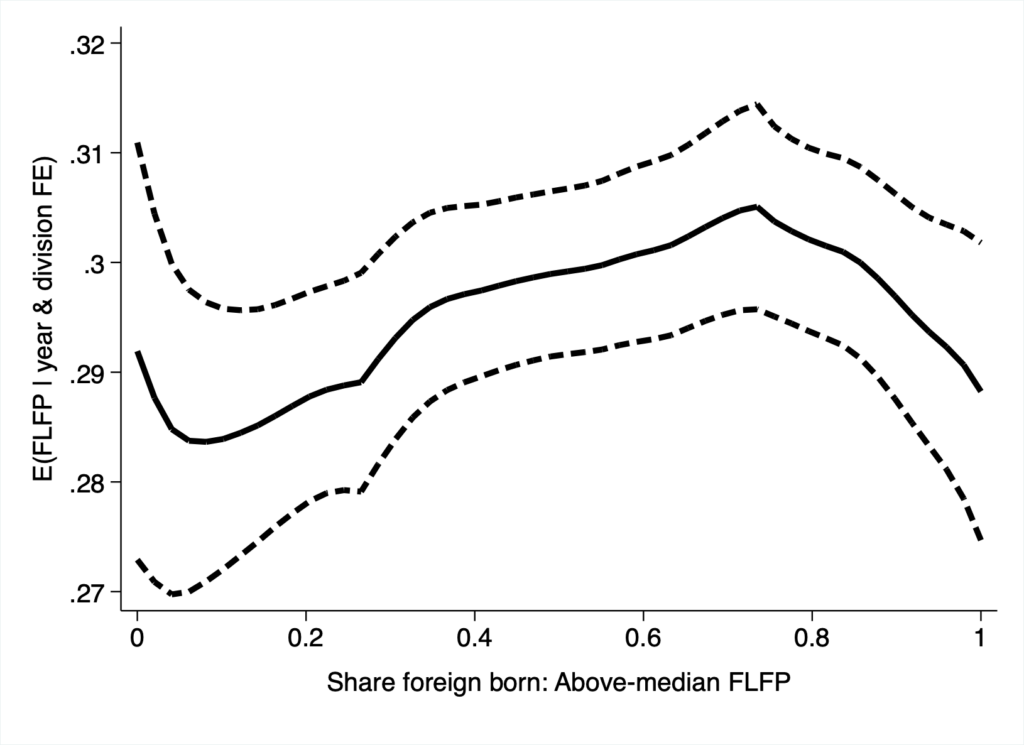
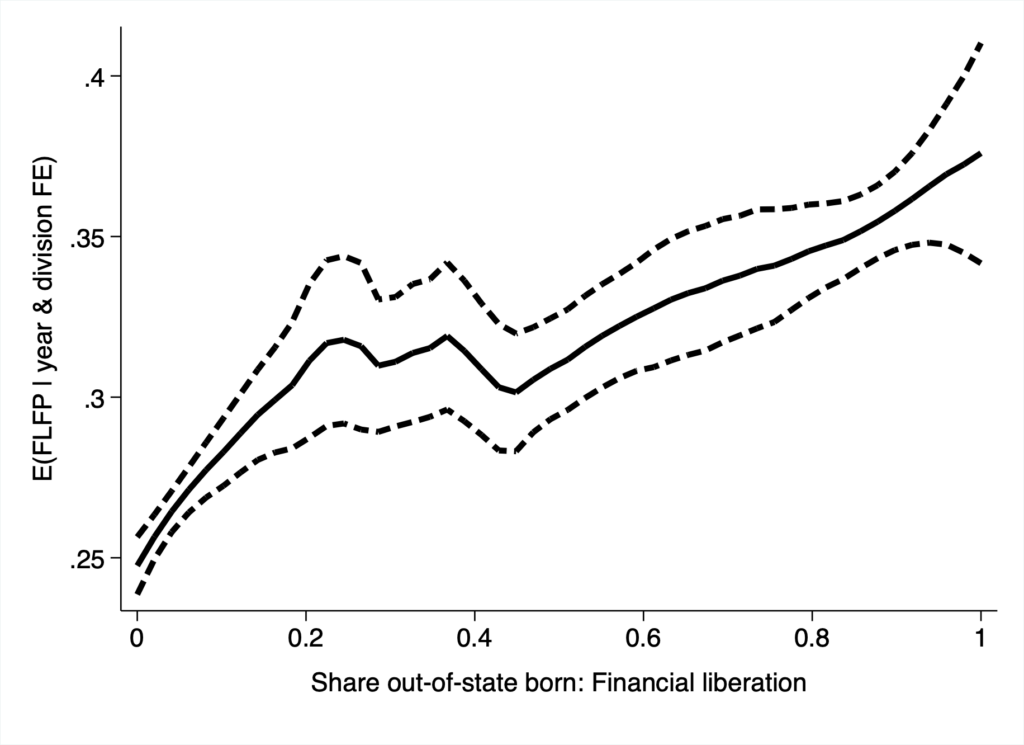
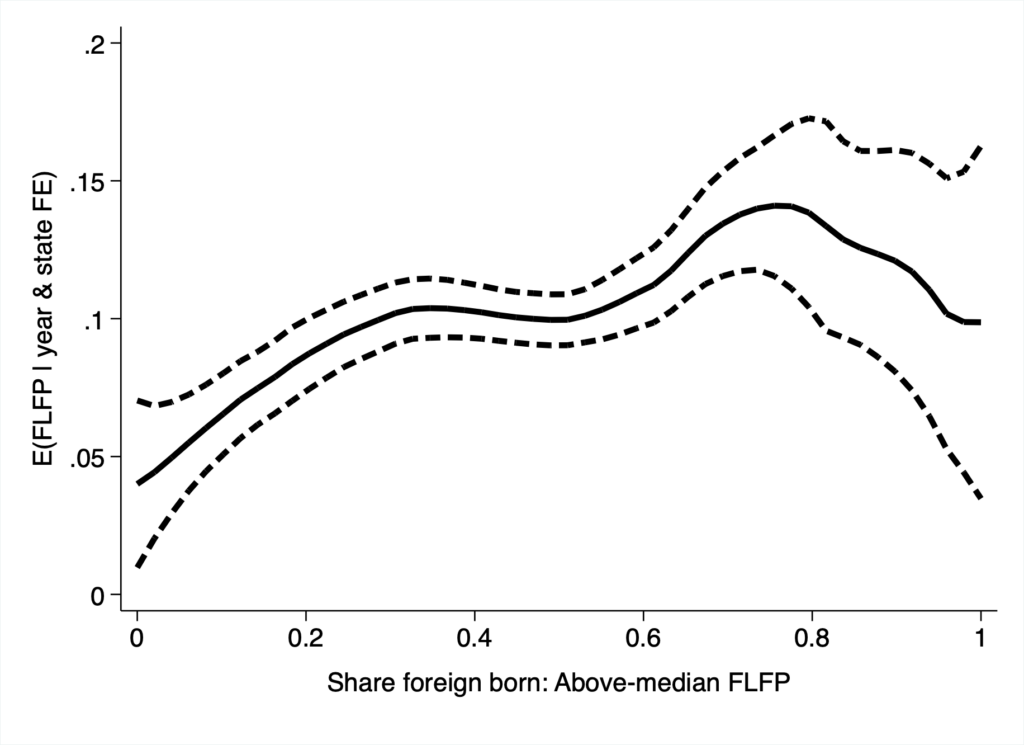
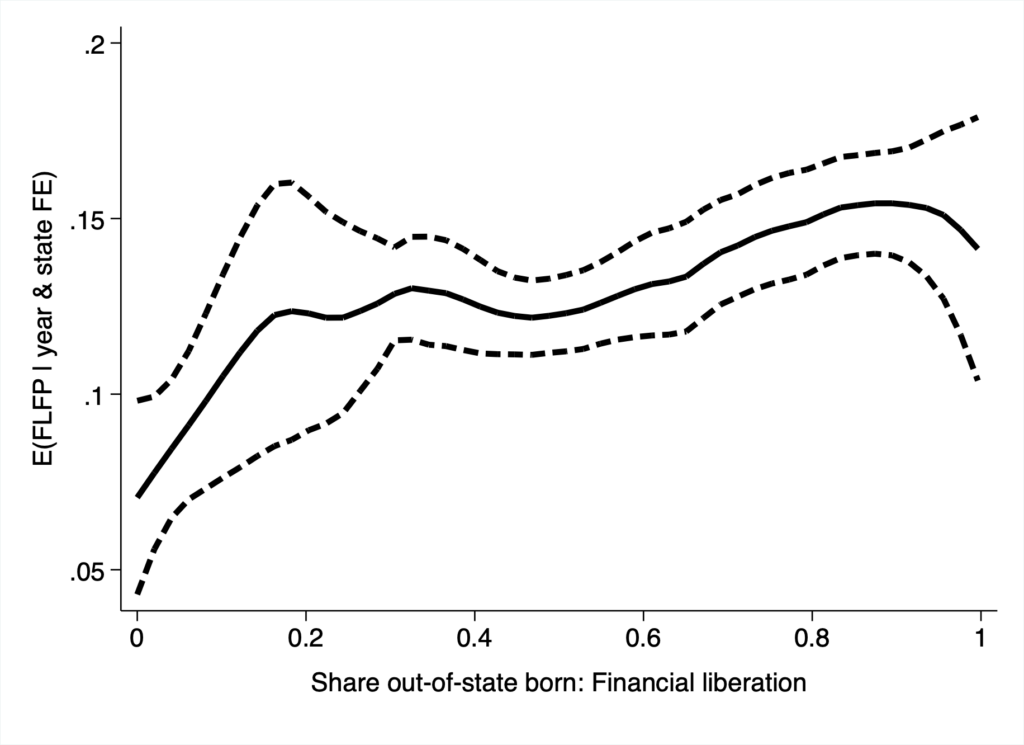
Notes: The figure presents semiparametric estimates relating settlers’ culture to FLFP in US counties in the short (two top graphs) and long run (two bottom graphs). I estimate these curves based on the Robinson (1988) partially linear approach. The specification includes state and decade of county creation fixed effects as well as county-level geographic controls—which are partialled out before estimating these shapes—and are based on an Epanechnikov kernel and rule-of-thumb bandwidth. The dashed lines indicate 95 percent confidence intervals. The estimates are recovered over all newly created US counties. The first two graphs display semiparametric estimates for FLFP in the short run, and the last two graphs display them in the long run. X-axis titles are indicative of settlers’ culture quantitative measure in question.
Figure A16. Case Study Illustrating Short-Run Effects
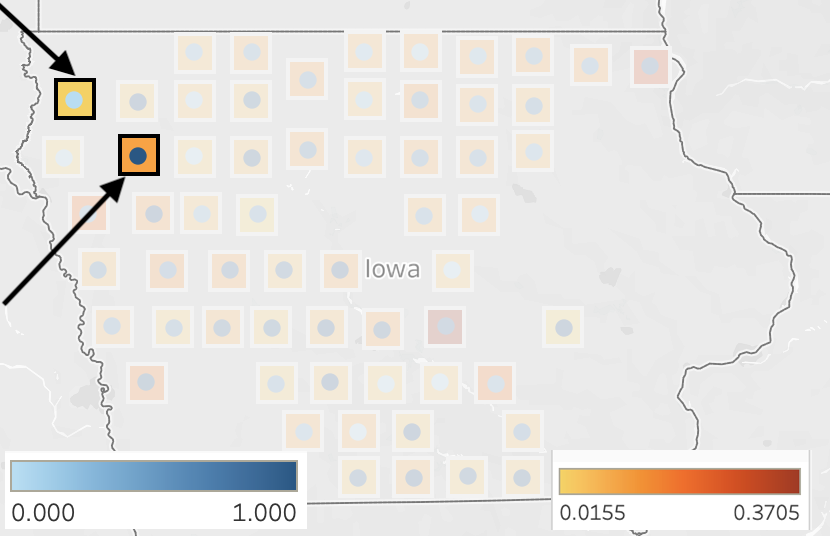
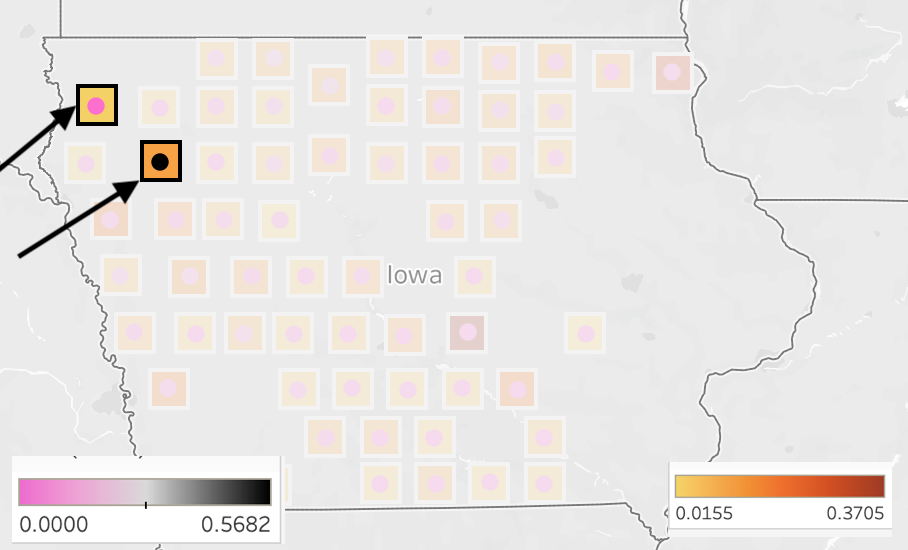
Notes: The maps show short-run effects on FLFP in US counties. Sioux and Cherokee counties are considered, both of which were created in Iowa in 1851 from noncounty areas. Color-coded squares refer to FLFP in US counties, and color-coded circles refer to the particular measure of settlers’ culture: FLFP in the places of origin (share of settlers born outside the US in countries with high FLFP) and financial liberation (share of out-of-state born settlers from states that granted financial liberation to women). The two maps capture the short-run analysis, i.e., observe FLFP in US counties using the first census available after the county creation date. Source: Author’s compilation.
Figure A17. Case Study Illustrating Long-Run Effects
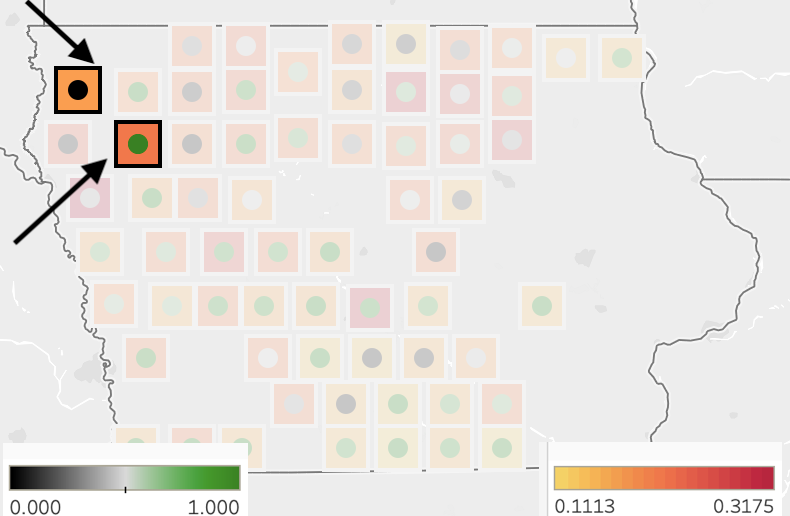
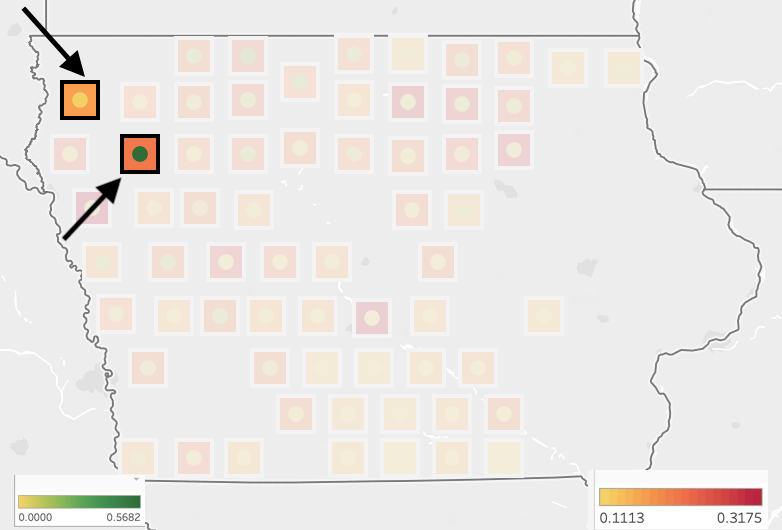
Notes: The maps show the short- and long-run effects on FLFP in US counties. Sioux and Cherokee counties are considered, both of which were created in Iowa in 1851 from noncounty areas. Color-coded squares refer to FLFP in US counties, and color-coded circles refer to the particular measure of settlers’ culture: FLFP in the places of origin (share of settlers born outside the US in countries with high FLFP) and financial liberation (share of out-of-state born settlers from states that granted financial liberation to women). The two maps capture the long-run analysis, i.e., observe FLFP in US counties about 100 years later. Source: Author’s compilation.
Table A1. Descriptive Statistics by Settlers’ Origin and Gender
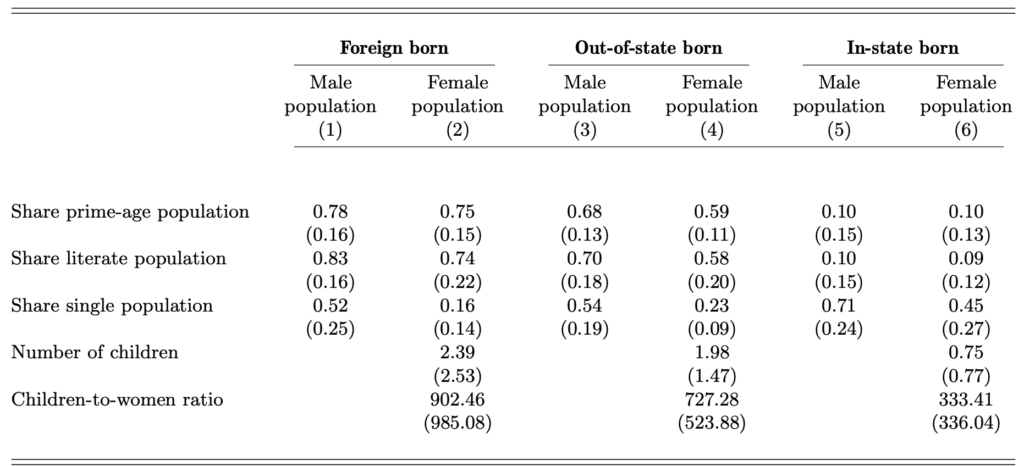
Notes: Based on complete-count census data from IPUMS. The sample is restricted to new counties, and all shares range between 0 and 1. The share of the male population among foreign-born individuals is 0.70 (0.14). The share of the male population among out-of-state born individuals is 0.62 (0.12), and the share of the male population among in-state born individuals is 0.51 (0.09). Standard deviations are reported in parentheses.
Table A2. Predict New US Counties
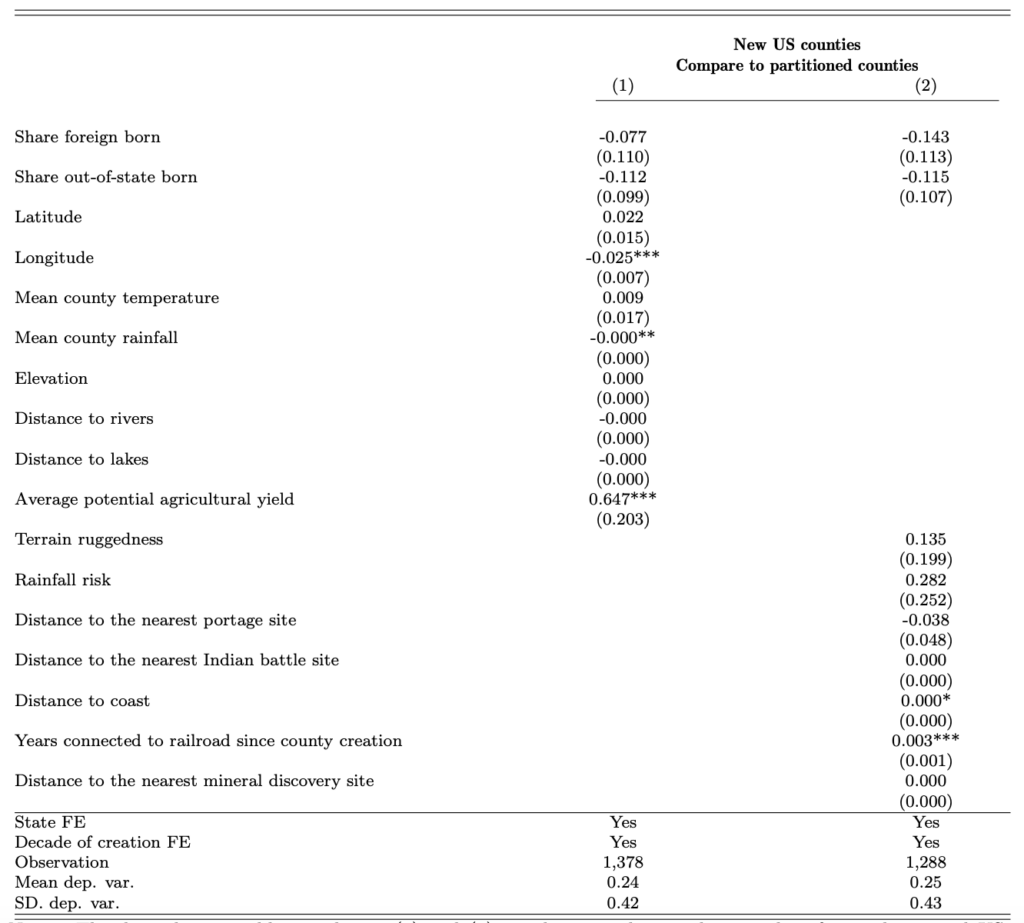
Notes: The dependent variable in columns (1) and (2) is a binary indicator that equals 1 for newly created US counties (i.e., created from noncounty areas) and 0 otherwise (i.e., partitioned county). Standard errors clustered on 60-square-mile grid cells are reported in parentheses. Significance levels: *** p<0.01, ** p<0.05, * p<0.1.
Table A3. Settlers’ Culture and FLFP: Both Measures
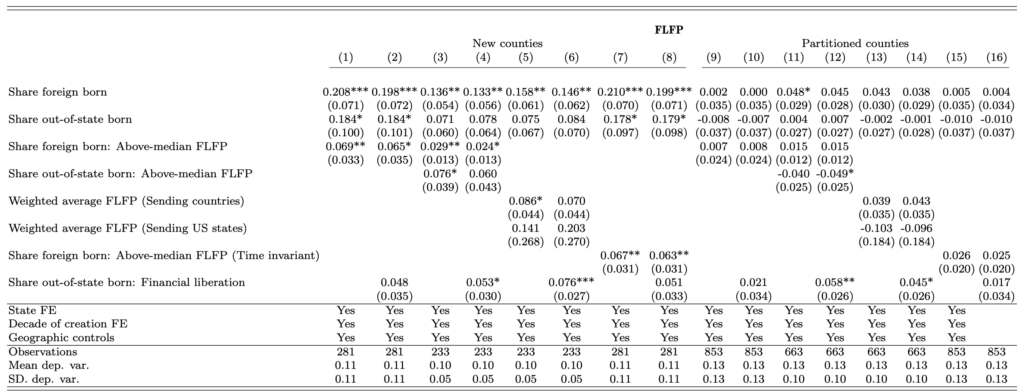
Notes: The dependent variable in columns (1)–(16) is FLFP in US counties in the short run. Data on labor force participation are based on the first US Census available after county creation for the short-run analysis. The sample of US counties is restricted to new counties in columns (1)–(8) and partitioned ones in columns (9) and (16). Settler population is based on the first US Census available after the county creation date. Settlers’ culture is proxied for using FLFP and women’s financial rights to reflect gender norms at the place of origin. State, decade of county creation fixed effects, and geographic controls are included throughout. Standard errors clustered on 60-square-mile grid cells are reported in parentheses. Significance levels: *** p<0.01, ** p<0.05, * p<0.1.
Table A4. Long-Run Analysis: Settlers’ Culture and FLFP in US-Partitioned Counties
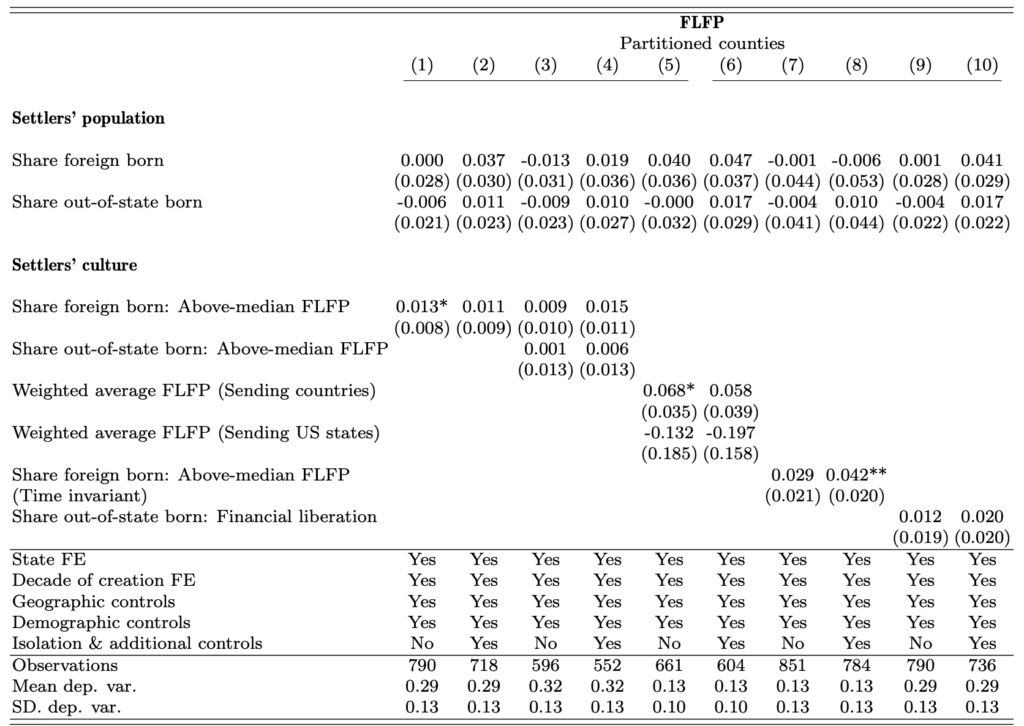
Notes: The dependent variable in columns (1)–(10) is FLFP in US counties in the long run. Data on labor force participation are based on the 10th US Census available after county creation (100 years later). My sample of US counties includes those created between 1840 and 1940 and is restricted to partitioned counties. Settler population data are based on the first US Census available after the county creation date. Settlers’ culture is proxied for using FLFP from sending countries (states) in columns (1)–(8), and women’s financial liberation in columns (9) and (10) to reflect gender norms at the place of origin. FLFP from sending countries is extracted from the same decade, or a decade or two earlier, depending on data availability, from when I observe the foreign-born settler population. State fixed effects, decade of county creation fixed effects, geographic controls, and demographic controls are included in columns (1)–(6). Standard errors clustered on 60-square-mile grid cells are reported in parentheses. Significance levels: *** p<0.01, ** p<0.05, * p<0.1.
Table A5. Robustness to Alternative Approaches to Inference
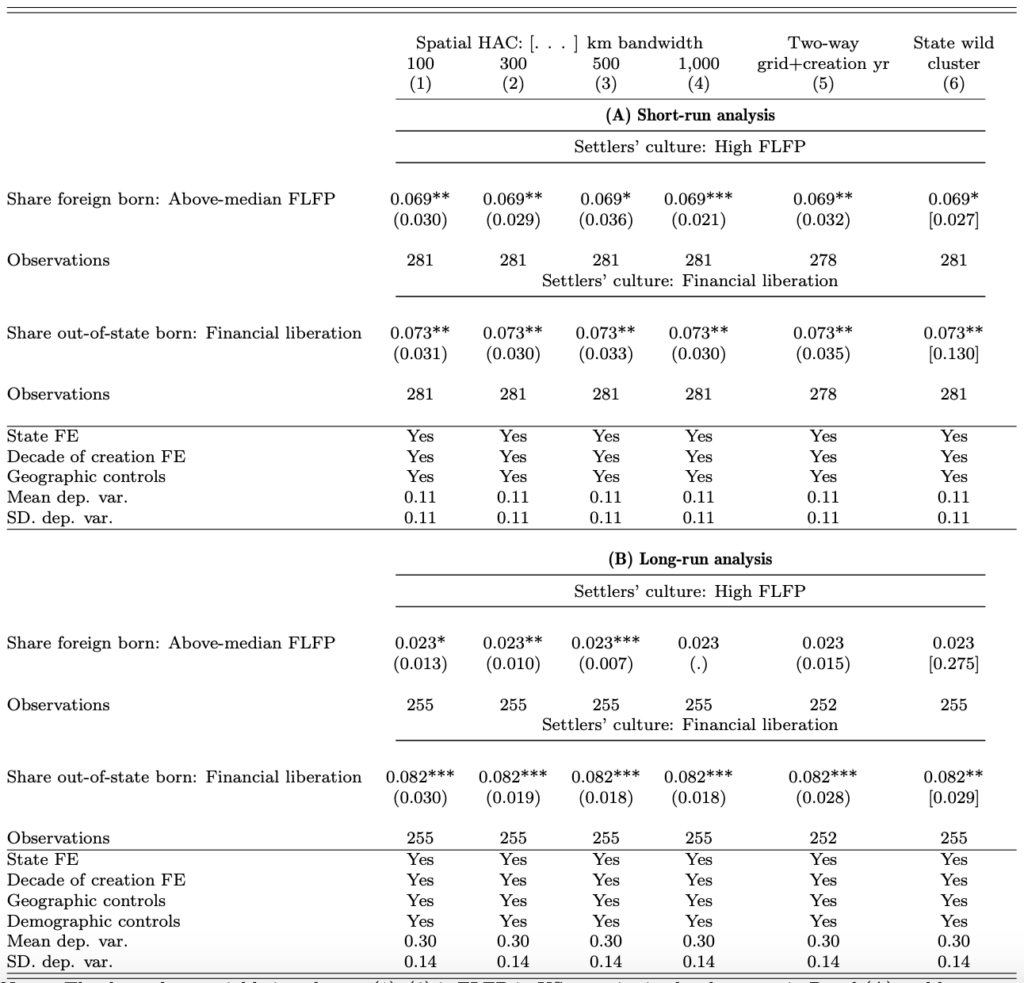
Notes: The dependent variable in columns (1)–(6) is FLFP in US counties in the short run in Panel (A) and long run in Panel (B). The sample considers new counties only. For space consideration, the estimates for the shares of foreign and out-of-state born populations are omitted. Columns (1)—(4) adopt the GMM-based spatial HAC procedure of Conley (1999) that allows for arbitrary correlation in unobservables across all counties within 100, 300, 500, and 1,000 km, respectively. Column 5 adopts two-way clustering on both the arbitrary grid cells adopted in the baseline specification and the year in which each county was incorporated. Last, column (6) clusters at the state level, using a wild bootstrap procedure to account for the relatively small number of states (17 in the main sample). The bracketed numbers in the final column correspond to p values from a wild bootstrap procedure clustering at the state level. Significance levels: *** p<0.01, ** p<0.05, * p<0.1.
Table A6. Controlling for US County Total Frontier Experience
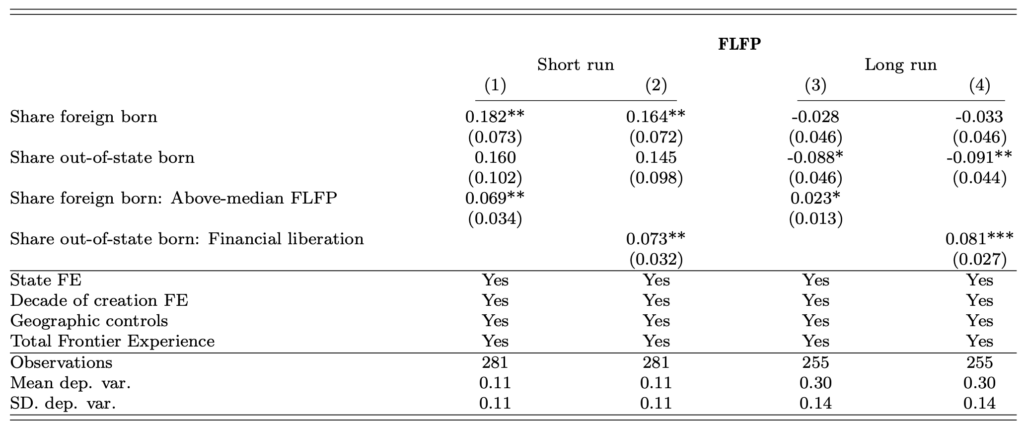
Notes: See the footnotes of Tables II and VII. Data on US counties total frontier experience are based on Bazzi et al. (2020).
Table A7. IV Strategy
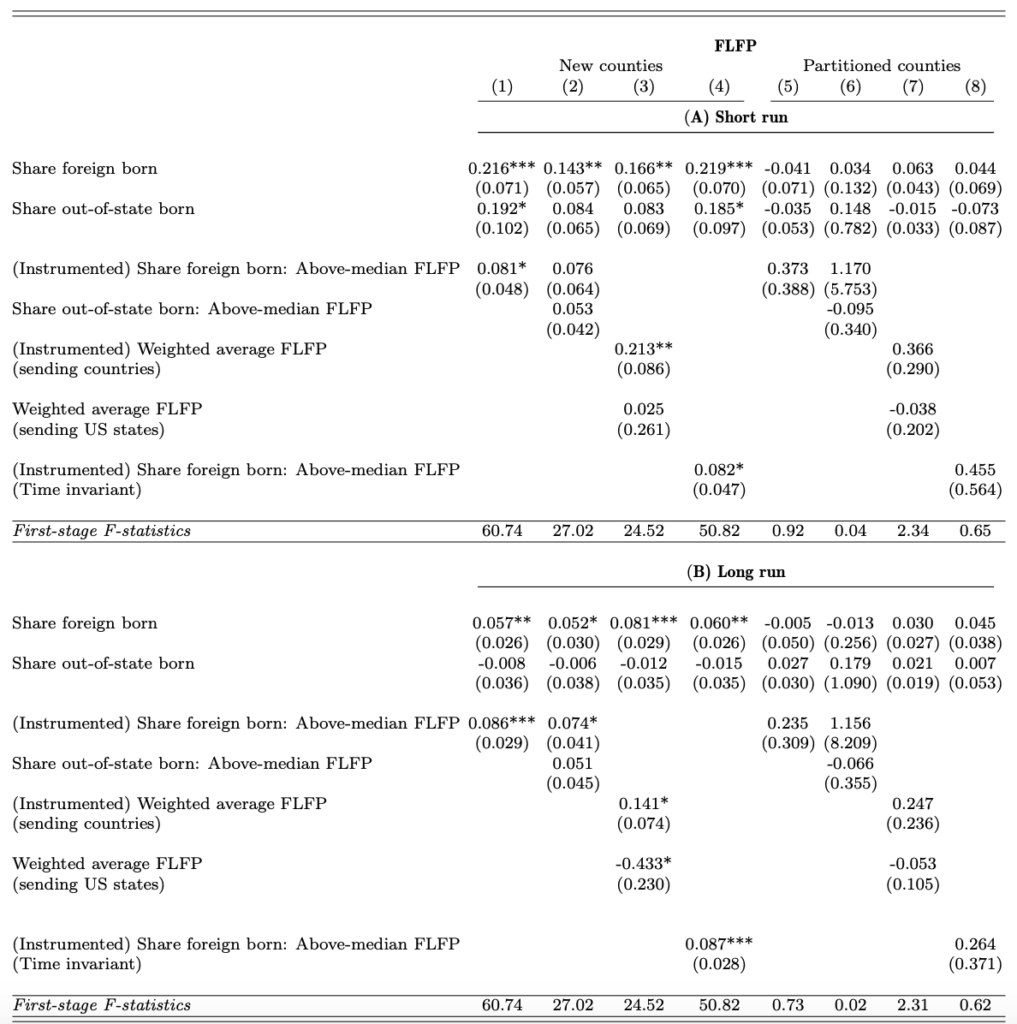
Notes: The table reports IV estimates based on the instrument described in Section 5.5. Panels (A) and (B) report the IV estimates for the short and long run, respectively, using the IV constructed based on annual migration inflows to the United States predicted by weather shocks in Europe, interacted with the years of settlement for each US county. Data on the variation in immigrant inflow to the United States that is predicted by sending country weather shocks and that are exogenous to factors within the United States are obtained from Sequeira et al. (2020). All specifications include state and decade of county creation fixed effects as well as county-level geographic controls. Standard errors clustered on 60-square-mile grid cells are reported in parentheses. Significance levels: *** p<0.01, ** p<0.05, * p<0.1.
Table A8. Culture versus Other Characteristics
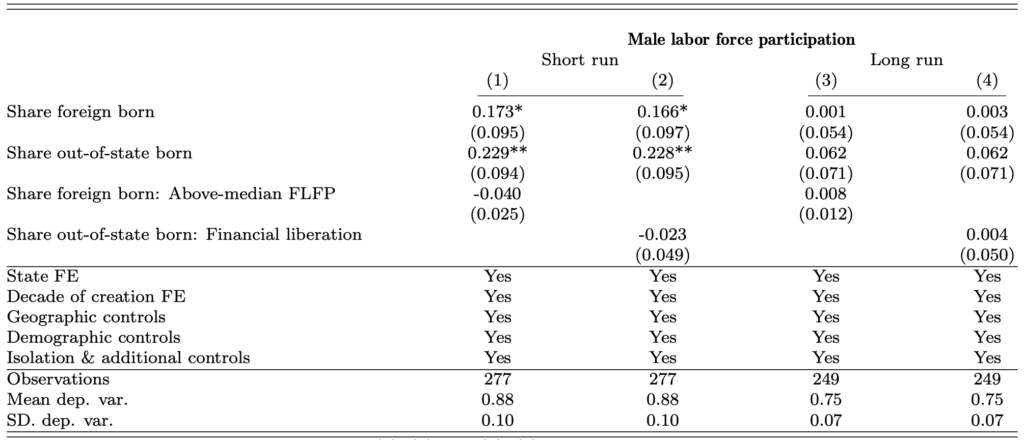
Notes: The dependent variable in columns (1)–(2) and (3)–(4) is male labor force participation in US counties in the short and long run, respectively. State, decade of county creation fixed effects, geographic, demographic, isolation and additional controls are included throughout. Standard errors clustered on 60-square-mile grid cells are reported in parentheses. Significance levels: *** p<0.01, ** p<0.05, * p<0.1.
Table A9. Vertical Transmission

Notes: The sample is restricted to second-generation American women aged 16 plus (i.e., US born women) but whose parents are born abroad (outside of the United States), particularly born in countries known to have high FLFP (i.e, countries known to have above-median FLFP). The sample includes all newly created counties between 1850–1940 (new and partitioned counties). The dependent variable in columns (1)–(4) is a binary indicator that equals 1 if the second-generation American woman whose parents originate from a country with liberal gender norms (as captured by high FLFP) is in the labor force and 0 otherwise. The independent variable of interest is a binary indicator that equals 1 if the newly created US county is a new county (i.e., created from noncounty areas) and 0 otherwise (i.e., partitioned county). State and decade of county creation fixed effects, county-level geographic controls, and additional county-level controls for geography and isolation are included throughout. Individual-level age control is included in columns (1)–(4). In columns (2) and (4), the sample further includes second-generation American women with at least one of their parents originating from countries with gender-liberal norms (as captured by high FLFP). In columns (3) and (4), the sample excludes nonsingle women (as inferred by nonzero fertility status). Standard errors clustered on 60-square-mile grid cells are reported in parentheses. Significance levels: *** p<0.01, ** p<0.05, * p<0.1.
Table A10. Selective Ex-Post Migration

Notes: The dependent variable in columns (1)–(7) is the share of foreign-born settlers from a given country of origin relative to the total population of foreign-born settlers residing in county
in state
, for the years 1860, 1870, 1880, 1900, 1910, 1920, and 1930, respectively. The independent variable of interest is the share of foreign-born settlers from the same country of origin
relative to the total population of foreign-born settlers residing in county
in state
in 1850. State fixed effects are included in columns (1)–(7). Geographic controls and additional county-level controls for geography and isolation are included in columns (1)–(7). Standard errors clustered on 60-square-mile grid cells are reported in parentheses. Significance levels: *** p<0.01, ** p<0.05, * p<0.1.
Table A11. Accounting for Years since County Creation
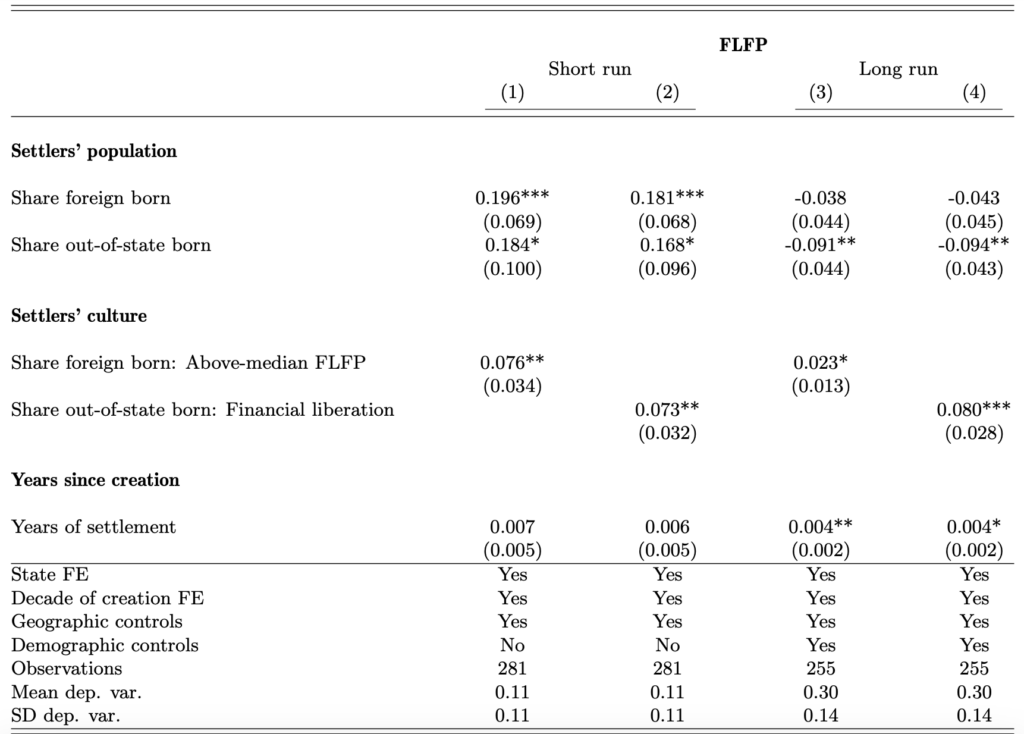
Notes: See footnote of Table II for columns (1)–(2) and footnote of Table VII for columns (3)–(4). The estimations further account for the years of settlement for each US county, calculated as the difference between the decennial year when settlers are observed (from the first US Census available) and the year of county creation.
Table A12. Determinants of County Creation Date
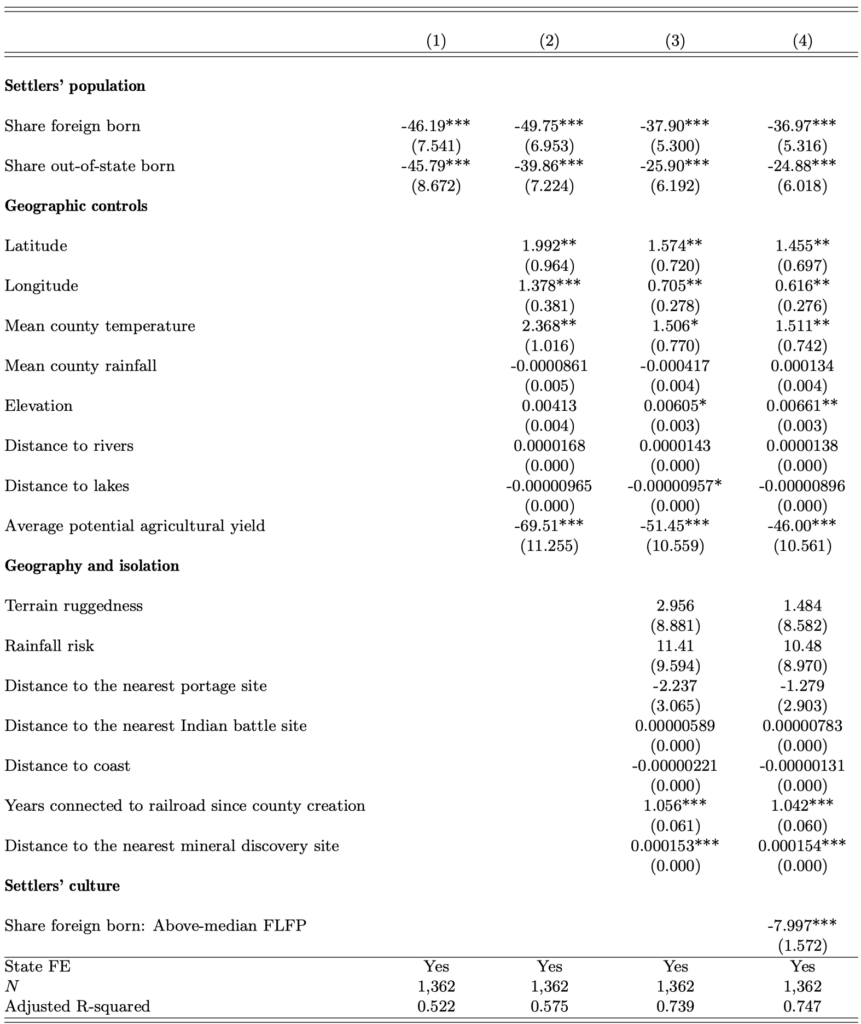
Notes: The dependent variable in columns (1)–(4) is the date at which a given land was first politically organized into a county (county creation date). The sample of US counties includes those created between 1840 and 1940. Settlers’ population data are based on the first US Census available after the county creation date. Settlers’ culture is proxied for using the share of foreign-born settlers from countries known to have above-median FLFP. Standard errors clustered on 60-square-mile grid cells are reported in parentheses. Significance levels: *** p<0.01, ** p<0.05, * p<0.1.
Table A13. Determinants of County Creation Date: Precounty Creation Populations
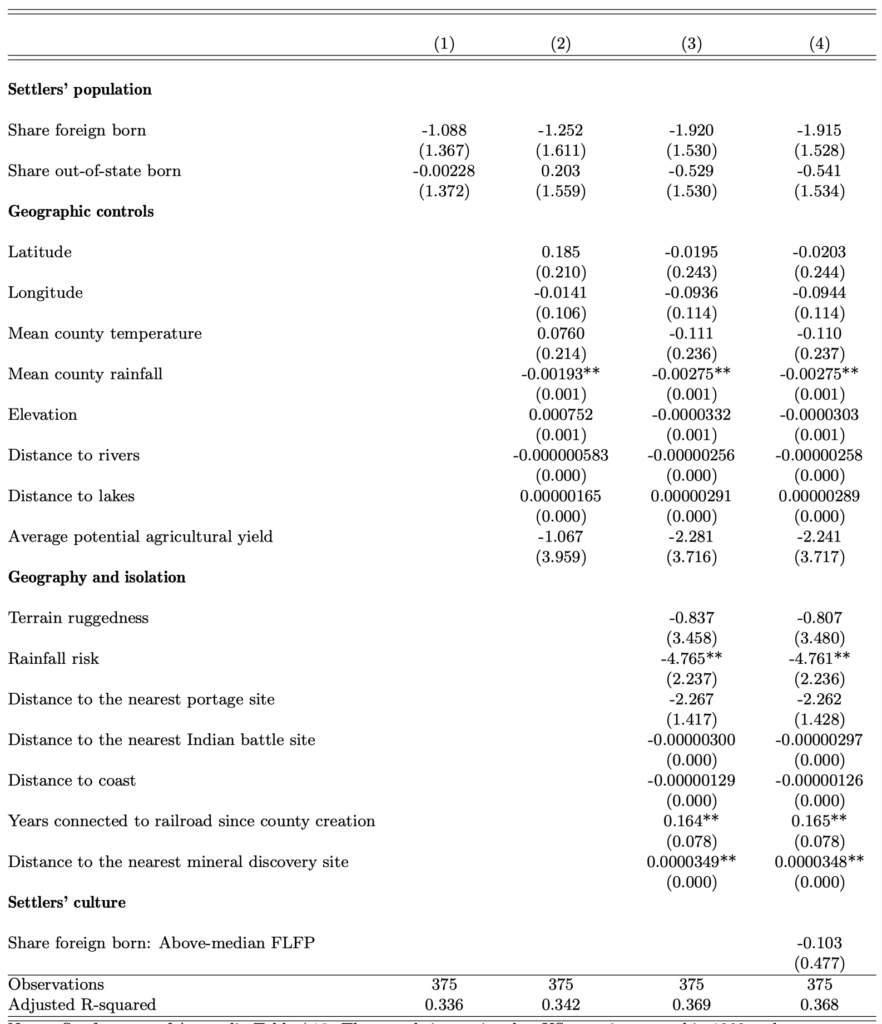
Notes: See footnote of Appendix Table A12. The sample is restricted to US counties created in 1860 and to precounty creation populations residing in US counties created in 1860 and who plausibly migrated there before county formation.
Table A14. Cultural Correspondence Assumption: Selective Migration of Settlers
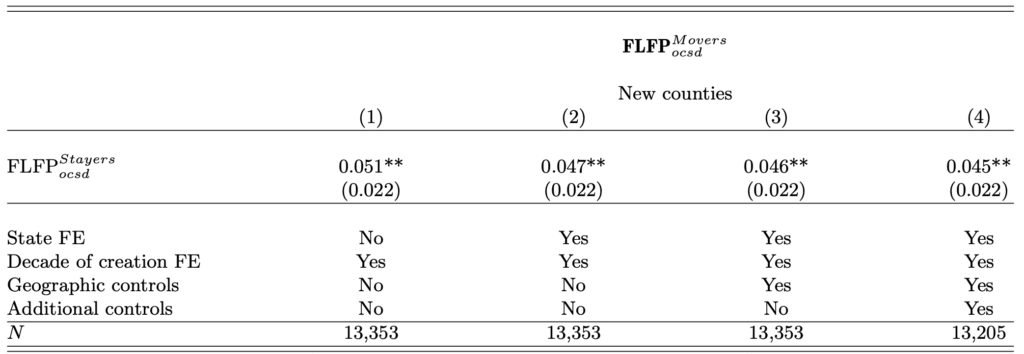
Notes: The sample is restricted to foreign-born women, i.e., born outside the United States. The dependent variable in columns (1)–(6) is the FLFP of foreign-born women in US counties (movers, i.e., observed in the United States). The independent variable is the FLFP of their sending country (stayers). FLFP in sending countries is the FLFP of foreign-born women’s birth country, and it is extracted from the same decade, or a decade or two earlier, depending on data availability, from when I observe the foreign-born women settler population. Standard errors clustered on 60-square-mile grid cells are reported in parentheses. Significance levels: *** p<0.01, ** p<0.05, * p<0.1.
Table A15. Snapshot of Number of Counties Created and Settlers’ Top Sending Countries/States
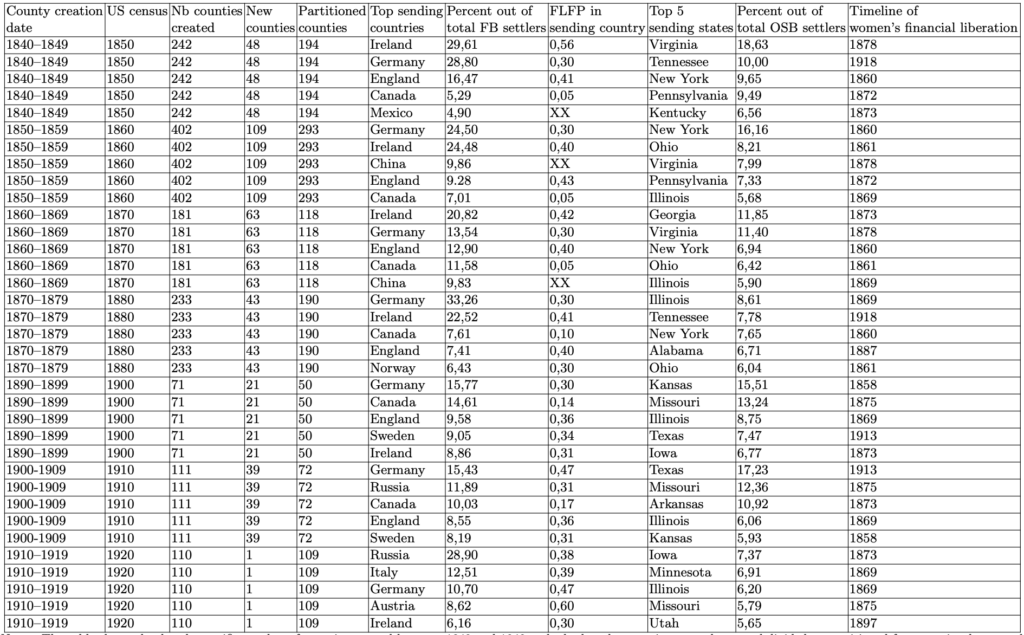
Notes: The table shows the decade-specific number of counties created between 1840 and 1940 and whether the counties created were subdivided or partitioned from previously created counties or formed from noncounty areas. The table also provides a description of the top five sending countries/states for settlers as well as their cultural characteristics, including FLFP and women’s financial liberation timeline. Source: Author’s compilation.
References
Ager, P. and Brückner, M.: 2013, Cultural diversity and economic growth: Evidence from the US during the age of mass migration, European Economic Review 64, 76–97.
Akerlof, G. A. and Kranton, R. E.: 2000, Economics and identity, Quarterly Journal of Economics 115(3), 715–753.
Alesina, A. and Giuliano, P.: 2010, The power of the family, Journal of Economic Growth 15(2), 93–125.
Alesina, A. and Giuliano, P.: 2015, Culture and institutions, Journal of Economic Literature 53(4), 898–944.
Alesina, A., Giuliano, P. and Nunn, N.: 2013, On the origins of gender roles: Women and the plough, Quarterly Journal of Economics 128(2), 469–530.
Algan, Y. and Cahuc, P.: 2006, Job protection: The macho hypothesis, Oxford Review of Economic Policy 22(3), 390–410.
Antecol, H.: 2000, An examination of cross-country differences in the gender gap in labor force participation rates, Labour Economics 7(4), 409–426.
Baranov, V., De Haas, R. and Grosjean, P.: 2020, Queens of the desert: Convictism and marital attitudes across Australia, AEA Papers and Proceedings, Vol. 110, American Economic Association 2014 Broadway, Suite 305, Nashville, TN 37203, pp. 457–462.
Baranov, V., De Haas, R. and Grosjean, P.: 2023, Men, male-biased sex ratios and masculinity norms: Evidence from Australia’s colonial past, Journal of Economic Growth pp. 1–58.
Barro, R. J. and McCleary, R. M.: 2003, Religion and economic growth across countries, American Sociological Review 68(5), 760.
Bazzi, S., Ferrara, A., Fiszbein, M., Pearson, T. P. and Testa, P. A.: 2021, The other great migration: Southern whites and the new right, Technical report, National Bureau of Economic Research.
Bazzi, S., Fiszbein, M. and Gebresilasse, M.: 2020, Frontier culture: The roots and persistence of “rugged individualism” in the United States, Econometrica 88(6), 2329–2368.
Becker, S. O. and Woessmann, L.: 2008, Luther and the girls: Religious denomination and the female education gap in nineteenth-century Prussia, Scandinavian Journal of Economics 110(4), 777–805.
Belloc, M. and Bowles, S.: 2013, The persistence of inferior cultural-institutional conventions, American Economic Review 103(3), 93–98.
Bester, C. A., Conley, T. G. and Hansen, C. B.: 2011, Inference with dependent data using cluster covariance estimators, Journal of Econometrics 165(2), 137–151.
Bisin, A. and Verdier, T.: 2011, Chapter 9: The economics of cultural transmission and socialization, Vol. 1 of Handbook of Social Economics, North-Holland, pp. 339–416. URL: https://www.sciencedirect.com/science/article/pii/B9780444531872000097.
Bisin, A. and Verdier, T.: 2017, On the joint evolution of culture and institutions, Technical report, National Bureau of Economic Research.
Blau, F. D.: 1992, The fertility of immigrant women: Evidence from high-fertility source countries, Immigration and the Work Force: Economic Consequences for the United States and Source Areas, University of Chicago Press, pp. 93–134.
Blau, F. D.: 2015, Immigrants and gender roles: Assimilation vs. culture, IZA Journal of Migration 4(1), 1–21.
Blau, F. D., Kahn, L. M., Brummund, P., Cook, J. and Larson-Koester, M.: 2020, Is there still son preference in the United States?, Journal of Population Economics pp. 1–42.
Blau, F. D., Kahn, L. M. and Papps, K. L.: 2011, Gender, source country characteristics, and labor market assimilation among immigrants, The Review of Economics and Statistics 93(1), 43–58.
Bleakley, H. and Lin, J.: 2012, Portage and path dependence, The Quarterly Journal of Economics 127(2), 587–644.
Brodeur, A. and Haddad, J.: 2021, Institutions, attitudes and LGBT: Evidence from the gold rush, Journal of Economic Behavior & Organization 187, 92–110.
Brodeur, A., Mabeu, M. C. and Pongou, R.: 2020, Ancestral norms, legal origins, and female empowerment.
Campa, P. and Serafinelli, M.: 2019, Politico-economic regimes and attitudes: Female workers under state socialism, Review of Economics and Statistics 101(2), 233–248.
Chiswick, B. R. and Robinson, R. H.: 2020, Women at work in the pre-Civil War United States: An analysis of unreported family workers.
Cohen, D., Nisbett, R. E., Bowdle, B. F. and Schwarz, N.: 1996, Insult, aggression, and the Southern culture of honor: An experimental ethnography, Journal of Personality and Social Psychology 70(5), 945.
Collins, W. J. and Zimran, A.: 2019, The economic assimilation of Irish famine migrants to the United States, Explorations in Economic History 74, 101302.
Conley, T. G.: 1999, GMM estimation with cross sectional dependence, Journal of Econometrics 92(1), 1–45.
Cortés, P., Koşar, G., Pan, J. and Zafar, B.: 2022, Should mothers work? How perceptions of the social norm affect individual attitudes toward work in the US, Technical report, National Bureau of Economic Research.
Couttenier, M., Grosjean, P. and Sangnier, M.: 2017, The Wild West is wild: The homicide resource curse, Journal of the European Economic Association 15(3), 558–585.
Davis, L.: 2016, Individual responsibility and economic development: Evidence from rainfall data, Kyklos 69(3), 426–470.
Davis, L. E., Easterlin, R. A., Parker, W. N., Brady, D., Fishlow, A. and Gallman, R.: 1972, American economic growth, New York.
Fages, D. M. and Cerda, M. M.: 2022, Migration and social preferences, Economics Letters 218, 110773.
Fernandez, R.: 2007, Women, work, and culture, Journal of the European Economic Association 5(2-3), 305–332.
Fernandez, R.: 2011, Does culture matter?, Handbook of Social Economics, Vol. 1, Elsevier, pp. 481–510.
Fernandez, R. and Fogli, A.: 2009, Culture: An empirical investigation of beliefs, work, and fertility, American Economic Journal: Macroeconomics 1(1), 146–77.
Fernandez, R., Fogli, A. and Olivetti, C.: 2004, Mothers and sons: Preference formation and female labor force dynamics, Quarterly Journal of Economics 119(4), 1249–1299.
Fiszbein, M., Jung, Y. and Vollrath, D.: 2022, Agrarian origins of individualism and collectivism, Technical report, National Bureau of Economic Research.
Fortin, N. M.: 2005, Gender role attitudes and the labour-market outcomes of women across OECD countries, Oxford review of Economic Policy 21(3), 416–438.
Fulford, S. L., Petkov, I. and Schiantarelli, F.: 2020, Does it matter where you came from? Ancestry composition and economic performance of US counties, 1850–2010, Journal of Economic Growth 25(3), 341–380.
Gay, V.: 2023, The intergenerational transmission of World War I on female labour, The Economic Journal p. uead029.
Geddes, R. and Dean, L.: 2002, The gains from self-ownership and the expansion of women’s rights, American Economic Review 92(4), 1079–1092.
Giuliano, P.: 2007, Living arrangements in Western Wurope: Does cultural origin matter?, Journal of the European Economic Association 5(5), 927–952.
Giuliano, P. and Nunn, N.: 2021, Understanding cultural persistence and change, Review of Economic Studies 88(4), 1541–1581.
Goldin, C.: 2006, The quiet revolution that transformed women’s employment, education, and family, American Economic Review 96(2), 1–21.
Grosjean, P.: 2014, A history of violence: The culture of honor and homicide in the US South, Journal of the European Economic Association 12(5), 1285–1316.
Grosjean, P. and Khattar, R.: 2019, It’s raining men! Hallelujah? The long-run consequences of male-biased sex ratios, Review of Economic Studies 86(2), 723–754.
Guiso, L., Sapienza, P. and Zingales, L.: 2009, Cultural biases in economic exchange?, Quarterly Journal of Economics 124(3), 1095–1131.
Guiso, L., Sapienza, P. and Zingales, L.: 2016, Long-term persistence, Journal of the European Economic Association 14(6), 1401–1436.
Hansen, C. W., Jensen, P. S. and Skovsgaard, C. V.: 2015, Modern gender roles and agricultural history: The neolithic inheritance, Journal of Economic Growth 20(4), 365–404.
Hartz, L.: 1969, The Founding of New Societies: Studies in the History of the United States, Latin America, South Africa, Canada, and Australia, Houghton Mifflin Harcourt.
Karadja, M. and Prawitz, E.: 2019, Exit, voice, and political change: Evidence from Swedish mass migration to the United States, Journal of Political Economy 127(4), 1864–1925.
Knudsen, A. S. B.: 2019, Those who stayed: Individualism, self-selection and cultural change during the age of mass migration. Unpublished Manuscript.
Miho, A., Jarotschkin, A. and Zhuravskaya, E.: 2023, Diffusion of gender norms: Evidence from Stalin’s ethnic deportations, Journal of the European Economic Association p. jvad040.
Minnesota Population Center: 2020, Integrated public use microdata series, international: Version 7.3. https://doi.org/10.18128/D020.V7.3.
Nunn, N.: 2014, Gender and Missionary Influence in Colonial Africa, Cambridge University Press, New York, pp. 489–512.
Nunn, N.: 2021, History as evolution, The Handbook of Historical Economics, Elsevier, pp. 41–91.
Nunn, N. and Puga, D.: 2012, Ruggedness: The blessing of bad geography in Africa, Review of Economics and Statistics 94(1), 20–36.
Nunn, N. and Wantchekon, L.: 2011, The slave trade and the origins of mistrust in Africa, American Economic Review 101(7), 3221–52.
Olivetti, C.: 2014, The female labor force and long-run development, Human Capital in History: The American Record.
Olivetti, C. and Petrongolo, B.: 2016, The evolution of gender gaps in industrialized countries, Annual Review of Economics 8, 405–434.
Porter, R., Gannett, H. and Hunt, W.: 1890, Progress of the nation, including the map of the population of 1870, Report on Population of the United States at the Eleventh Census pp. 13–30.
Robinson, P. M.: 1988, Root-n-consistent semiparametric regression, Econometrica 56(4), 931–954.
Ruggles, S., Flood, S., Goeken, R., Grover, J., Meyer, E., Pacas, J. and Sobek, M.: 2020, IPUMS USA: Version 10.0 [dataset]. Minneapolis, MN: IPUMS; 2020.
Schulz, J. F., Bahrami-Rad, D., Beauchamp, J. P. and Henrich, J.: 2019, The church, intensive kinship, and global psychological variation, Science 366(6466), eaau5141.
Sequeira, S., Nunn, N. and Qian, N.: 2020, Immigrants and the making of America, The Review of Economic Studies 87(1), 382–419.
Shayo, M.: 2009, A model of social identity with an application to political economy: Nation, class, and redistribution, American Political Science Review pp. 147–174.
Solomou, S. and Wu, W.: 1999, Weather effects on European agricultural output, 1850–1913, European Review of Economic History 3(3), 351–373.
Spolaore, E. and Wacziarg, R.: 2013, How deep are the roots of economic development?, Journal of Economic Literature 51(2), 325–69.
Tabellini, G.: 2008, Institutions and culture, Journal of the European Economic Association 6(2-3), 255–294.
Tabellini, G.: 2010, Culture and institutions: Economic development in the regions of Europe, Journal of the European Economic Association 8(4), 677–716.
Teso, E.: 2019, The long-term effect of demographic shocks on the evolution of gender roles: Evidence from the transatlantic slave trade, Journal of the European Economic Association 17(2), 497–534.
Turner, F. J.: 1893, The significance of the frontier in American history, Proceedings of the State Historical Society of Wisconsin.
Voigtländer, N. and Voth, H.-J.: 2012, Persecution perpetuated: The medieval origins of anti-Semitic violence in Nazi Germany, The Quarterly Journal of Economics 127(3), 1339–1392.
Von Berlepsch, V. and Rodríguez-Pose, A.: 2019, The missing ingredient: Distance, Internal migration and its long-term economic impact in the United States, Journal of Ethnic and Migration Studies pp. 1–20.
Woodard, C.: 2011, American Nations: A History of the Eleven Rival Regional Cultures of North America, Penguin.
Zelinsky, W.: 1973, The cultural geography of the United States. Englewood Cliffs, NJ: Prentice Hall.

